Very rare visitor.
One record: a juvenile spent about four hours perched in a tree of a Fishers Green garden on 12 August 1994.
Very rare visitor.
One record: a juvenile spent about four hours perched in a tree of a Fishers Green garden on 12 August 1994.
Irregular visitor and, breeding resident.
Mostly seen at Fairlands Valley Lakes and the Town Centre Gardens. With additional records of two flying over Woodland Way on 10 April 1967, two flying over the Old Town on 12 September 1973, six flying over Stevenage on 25 September 1975, four flying over Watery Grove on 29 July 1981 and, a ringed bird (889) at Glaxo Smith Kline on 26 September 2016.
They were first seen at Fairlands Valley Lakes in 1973, the following is an account of these Swans from the Stevenage & District Ornithological Society’s Report for that year:
“Fairlands Lakes attracted four adults and one juvenile on 16 January (12 flying along the valley on 24 January did not stop and may have been Mutes) but after a young bird was found shot apart from one on 11 February it wasn’t until 16 September that two were seen to stay, then five from 4 October and finally five or six regular until the end of the year.”
In 1974 they were seen all year at Fairlands Valley Lakes except for in June and August, with six seen on 4 March. A young bird appeared to be resident in 1975.
A pair attempted to breed at Fairlands Valley Lakes in 1976. Breeding was successful in 1977 with two cygnets seen during May one of which was subsequently killed by a Dog, whilst the other died by swallowing a fishing line. Two were also seen to mate on 8 January 2001, but did not stay to breed.
In 2016 a ringed pair (male 4COO and female 48NN) nested on the Millennium Lake Island but failed to breed. (The male was originally red colour ringed with number 4AXO at London Colney as a cygnet on 10 September 2013 and, was first recorded at Fairlands Valley Lakes in March 2014. Having lost its original ring, it was replaced on 9 March 2017 with ring number 4COO. The female was ringed at Fairlands Valley Lakes on 9 March 2015 with red colour ring 48NN). In 2017 the same pair nested in the same place and produced six cygnets, which were first seen on 24 May. Unfortunately, between the 21 and, 26 July the number of cygnets was reduced to two. One is believed to have been taken into care by the R.S.P.C.A., the disappearance of the other three is unaccounted for. The two adults and, surviving two cygnets were seen until 14 September, when one of the surviving cygnets again mysteriously disappeared. The surviving cygnet and two adults were still at the Lakes until 5 October with the surviving cygnet last seen on 12 October.
The same pair nested again in 2018 and 2019 with seven cygnets seen on 27 May 2018, sadly the number of cygnets was reduced to one by 4 July and, the remaining cygnet was last seen on 12 September. Two cygnets were seen on 26th May 2019 but, were reduced to one by 4 July and, last seen on 26 July. Nesting was attempted again in 2020 with nest building seen on 19 February but, unfortunately the female (4BNN) was believed to have been killed by a Fox (Vulpes vulpes).
On 9 January 2022 the male (4COO) was seen with what appeared another female (ringed 4EJZ) together with another pair, an un-ringed, male and a female (ringed 4ETH). The female (4ETH) had been ringed as a five-year-old bird at Walthamstow Wetlands on 6 October 2020 and had subsequently been seen at Victoria Park, Hackney, Wanstead Flats and Nazeing Mead, Essex.
4COO and 4EJZ nested in 2022 with five cygnets seen on 23 May. Unfortunately, the cygnets were quickly reduced to one, with the surviving cygnet seen until 27 October. The same pair nested again in 2023 raising one cygnet, which was seen until 10 February 2024. Despite egg laying in 2024 and 2025 the pair were unsuccessful in producing any young.
There is a record of another ringed pair at Fairlands Valley Lakes in 2016, ring numbers, 4BIQ and, 4BOW unfortunately, 4BOW was found dead there at the end of the year having apparently hit some wires.
The most seen together are 11 at Fairlands Valley Lakes on 4 and 5 June 2000, and an unusual record is of a family group of two adults, and eight juveniles seen on 28 January 2008.
From 2014, when they were first seen with two cygnets on 17 November there was a regular wintering pair at the Town Centre Gardens. The female, ring number 888 was ringed as a cygnet at Digswell Lake near Welwyn Garden City on 16 March 2010 and, the male, ring number, 889 was ringed as a cygnet at Verulamium Lake, St Albans on 13 April 2002, they are regular breeders at Digswell Lake. The latest record of this pair at the Town Centre Gardens is 1 October 2020.
Four were present at the Town Centre Gardens throughout March 2025.
A 15, year old bird ringed at Verulamium, St Albans on 13 April 2000 (ring No. W00619) was seen at Stevenage on 17 December 2017 and, 11 November 2018.
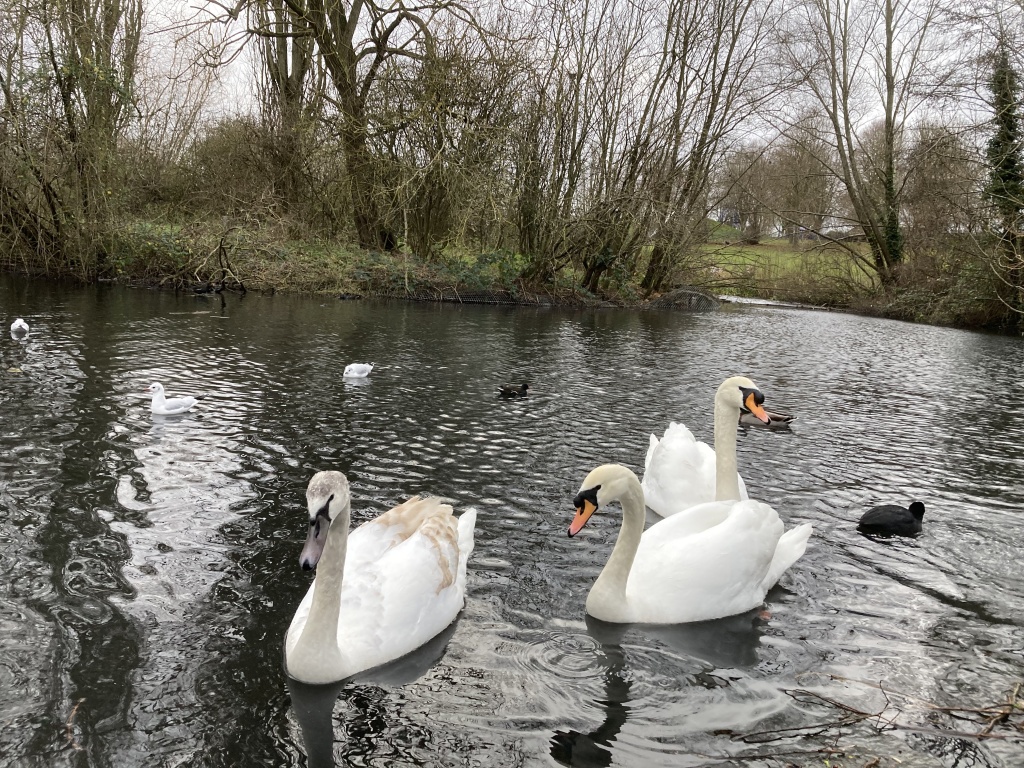
4COO and 4EJZ with cygnet Fairlands Valley Lakes 24 December 2023.
Single birds have been seen at Fairlands Valley Lakes on 29 and 30 October 2001, 17 to 23 June 2003, 29 November to 3 December 2015. Two seen from 21 July to 27 October 2016 and, one on 3 November.
[ thought or known species of introduced or captive origin ]
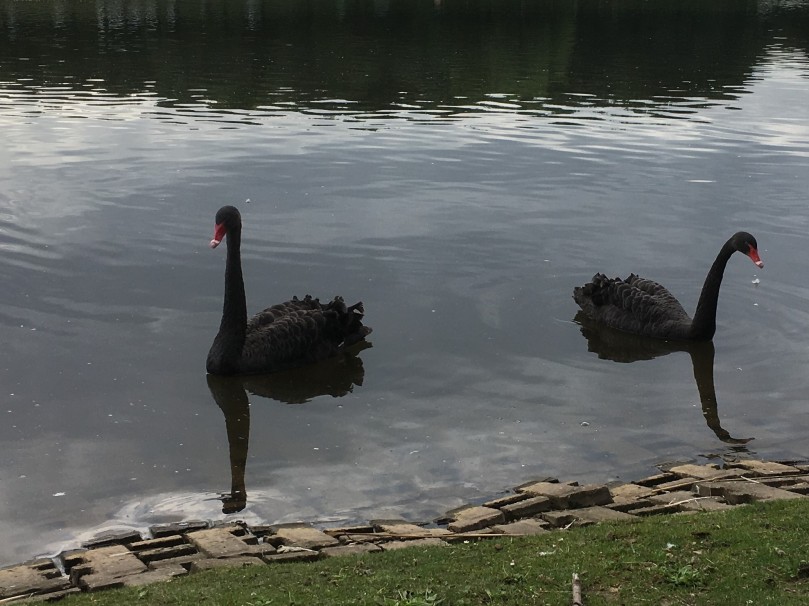
Very rare visitor.
25 Swans, possibly Bewicks flew over Fairlands Valley on 6 January 1985.
Very rare winter visitor.
Four records: two were recorded by the Stevenage Woodland Conservation Society as being at the Town Centre in February 1970, 30 recorded by the Stevenage and District Ornithological Society flying over Whomerley Wood on 6 March 1970, an adult and two first winter birds flying southwest over Astonbury Wood on 16 January 1991 and a juvenile at Fairlands Valley Lakes on 4 November 2022 (this bird was seen later the same day at Amwell and then at Rye Meads on 5 November where it remained until it died on 26 November).
Very rare visitor
One record: a juvenile at Fairlands Valley Lakes on 9 and 10 December 2010, during exceptionally cold weather.
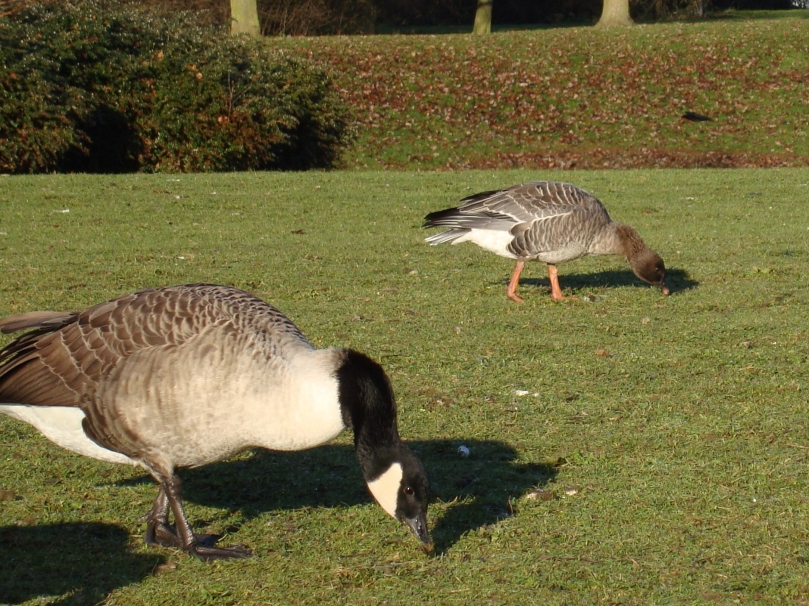
Very rare visitor
Two records: one at Fairlands Valley Lakes on 25 October 2013 and a first winter bird found at the Town Centre Gardens on 23 December 2020 and seen later that day at Fairlands Valley Lakes, having roosted overnight at the Lakes it flew off southeast on 24 December, the same bird was seen again briefly at Fairlands Valley Lakes on 13 and 15 February 2021.
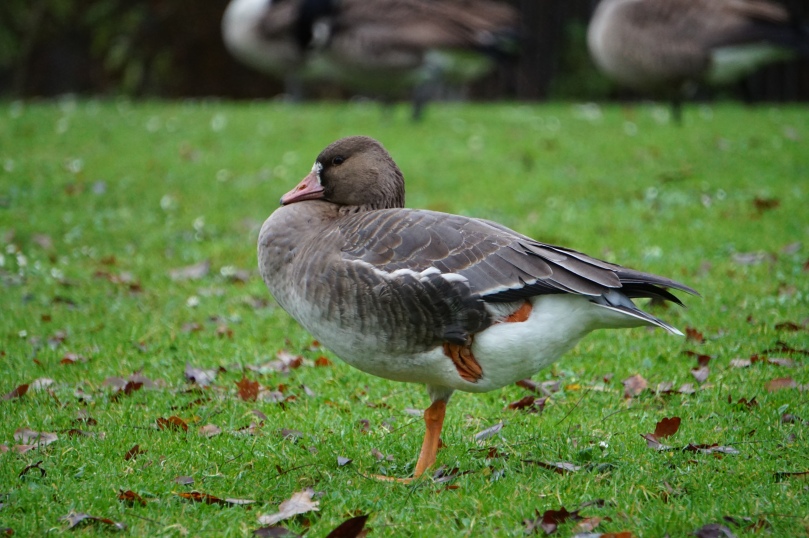
First Winter bird, Town Centre Gardens 23 December 2020
Increasing visitor and feral resident.
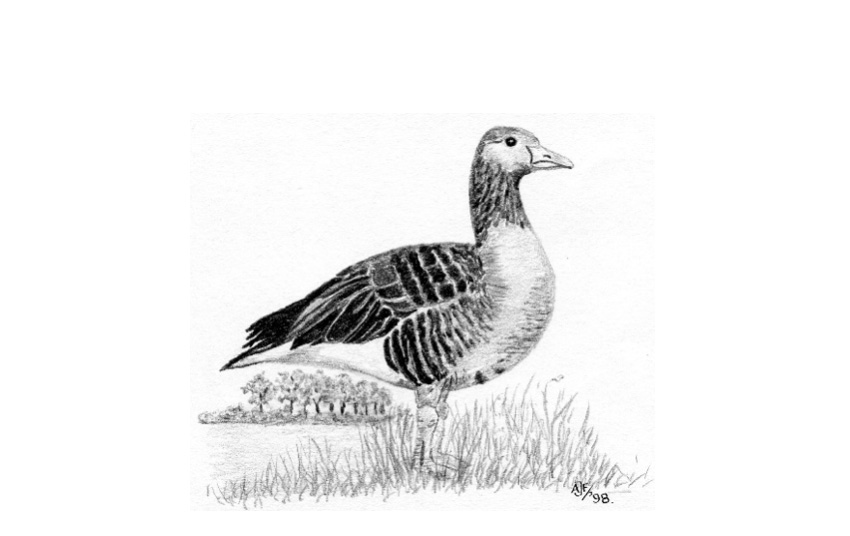
Domesticated Greylag Geese were formerly kept at farms in Stevenage for both food and their “guard dog” qualities.
In recent years the numbers of Greylag Geese of feral origin have increased in Hertfordshire with quite large flocks seen.
Birds of possible wild origin are occasionally seen at Fairlands Valley Lakes and birds of feral origin are regularly seen. The earliest record from there is from November 1983 and, the 33 seen on 12 November 2025 is the highest number of birds seen together there.
Single birds are also occasionally seen at the Town Centre Gardens, with five seen there on 5 July 2018.
Other records: four were seen flying over Norton Green Tip on 5 April 2016; two seen feeding among c.200 Canada Geese (Branta canadensis) at Astonbury Farm on 16 November 2022; two seen flying over Astonbury Wood on 31 March 2024; one flying over Astonbury Wood on 4 May 2024; five feeding among a flock of c.100 Canada Geese in a field behind Stringers Lane, Aston on 12 December 2025.
Breeding Resident.
Despite their familiarity they are only recent colonisers of Hertfordshire. In the 1950’s, this introduced species from North America, was a rare visitor to the County and did not breed until 1969. The earliest local record is 25 seen by the River Beane at Aston on 22 January 1940.
Now regularly seen at Stevenage with a large flock usually present at Fairlands Valley Lakes (where they were first recorded on 22 February 1972 when three were seen), and a smaller one at the pond in the Town Centre Gardens.
The most seen at Fairlands Valley Lakes are 830 on 24 October 2025. C.120 were seen at the Town Centre Gardens on 29 September 2016, 250 at Norton Green on 12 September 2017, c.200 at Astonbury Farm on 16 November 2022 and c.400 flying over Astonbury Wood on 5 October 2024 in groups of five and 20.
Regular as a breeding species at Fairlands Valley Lakes. During the 2018 breeding season 35 young and 12 nests were recorded. In 2019 11 pairs produced only one brood. 35 young from eight broods were recorded in 2021. They have also bred at Norton Green Pond in the late 1980s, and the pond at Astonbury Manor in 2006.
Large flocks are also often seen and heard flying over the town early in the morning and in the evening.
Birds have been seen at Fairlands Valley Lakes (10 October 1997, 3 March 2004 and 7 November 2025) and the Town Centre Gardens (18 June 2003, 12 to 23 March and 28 April 2004).
[ thought or known species of introduced or captive origin ]
Five were seen at Fairlands Valley Lakes from 17 October 1978 to January 1979 (when two left) the remaining three departed during April 1979 and, a ringed bird was there between 5 and 10 March 1980.
[ thought or known species of introduced or captive origin ]
An occasional visitor
Although some Siberian Barnacle Geese winter regularly in southeast England, those seen in Hertfordshire are considered to be feral birds.
They have been seen mostly singularly at Fairlands Valley Lakes, and the Town Centre gardens. Two birds were seen at Fairlands Valley Lakes on 12 September 2018 and, the Town Centre Gardens on 19 September 2018 and, up to two birds were seen at Fairlands Valley Lakes from 24 October to 5 December 2022.
A long staying bird was seen at Fairlands Valley Lakes between 15 June and 28 September 1999.
One was also seen at Norton Green Tip on 12 September 2017.
The most recent record is of one at Fairlands Valley Lakes on 1 April 2025.
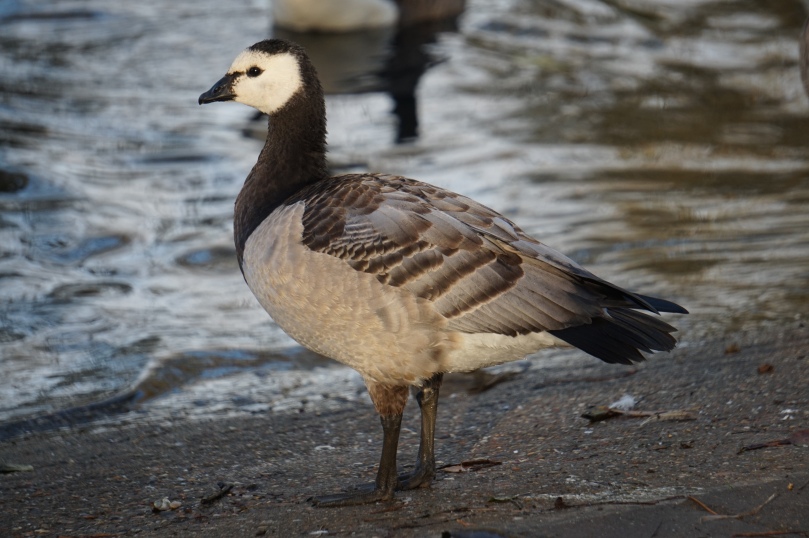
Fairlands Valley Lakes 4 November 2022
Very rare winter visitor and passage migrant.
An immature bird was at Fairlands Valley Lakes from 18 to 29 December 1994.
Two large flocks were seen flying over Stevenage in early 1996, the first, a flock of 28 flew high in a north westerly direction over the Old Town on 19 February, the other a flock of approximately 45 flew south west to east over Norton Green on 7 April.
One at Fairlands Valley Lakes on 15 January 2012.
One at Fairlands Valley Lakes from 12 to 20 March 2015 and, possibly the same bird at the Town Centre Gardens and Fairlands Valley Lakes on the, un-seasonable dates of 4 and 5 June 2015.
200 were seen flying low over the A1(M) near Stevenage in small flocks on 12 September 2024.
An increasingly regular visitor.
From a small feral population in Norfolk, this introduced species is now increasing and spreading in England.
The first record for Stevenage was of one at Fairlands Valley Lakes and the Town Centre Gardens between 24 January and, 6 February 2007. One was subsequently seen at Fairlands Valley Lakes and, the Town Centre Gardens between 10 and 12 October 2007.
They were not recorded again until 2011 when up to two were at Fairlands Valley Lakes between 25 and 29 July 2011.
Subsequent records prior to 2020 are; two on the GSK Site Lake on 21 December 2018; two at Fairlands Valley Lakes on 17 and 29 March 2019; two adults and four juveniles at Fairlands Valley Lakes on 17, 21 and 29 September and 6 October 2019 (assumed to be the birds that bred at The Park, Knebworth House that summer); eight at Fairlands Valley Lakes on 21 November 2019; three at Fairlands Valley Lakes from 24 to 1 December 2019; two at Fairlands Valley Lakes from 2 December 2019 until 12 January 2020, with 11 seen on 15 December.
The records for Fairlands Valley Lakes since 2020 are: four on 19 January 2020; one on 16 March 2020; up to nine between 23 and 27 July 2020; one on 28 October 2020; two adults and a juvenile seen between 26 September and 23 November 2021; seen in January, April, and August 2022 and up to seven on various dates from 28 September to 11 December; seen in January and May 2023 and up to nine between 14 July and 28 November 2023; between two and 10 seen on various dates between February and December 2024, 10 seen between 2 and 27 July 2024; three on 24 January 2025; one on 24 and 25 April and 11 May 2025; up to six between 10 and 25 June 2025; two on 8 and 17 July 2025; one between 28 July and 26 August 2025; up to five on various dates between 2 September and 14 October 2025; two on 14 December 2025.
Other records for Stevenage are: one flying over Norton Green Tip on 23 August 2022; one seen feeding among c.200 Canada Geese (Branta canadensis) at Astonbury Farm on 16 November 2022; two at Astonbury Farm on 29 October 2023.
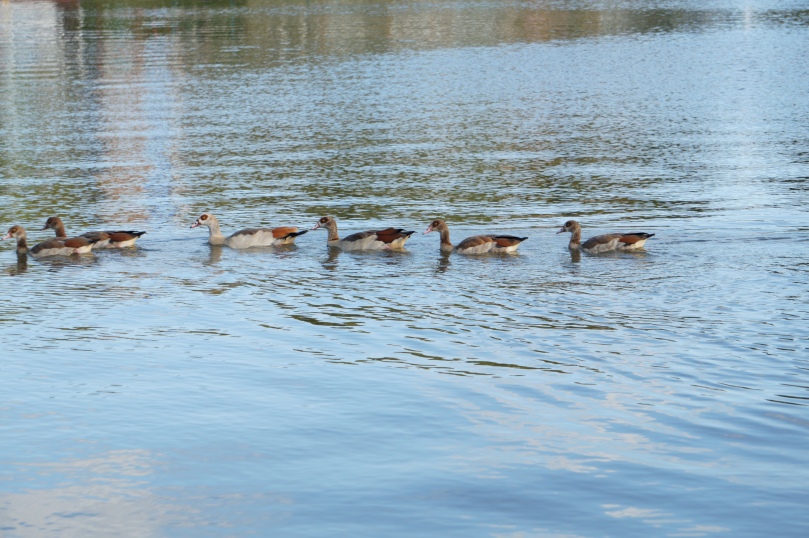
Very rare visitor.
Four records: one was seen at the Symonds Green water meadow in Gunnels Wood Road from January to March 1979, one at Fairlands Valley Lakes on 20 April 2013, one seen flying west over a Stevenage Garden on 30 November 2020 and two flying over Fairlands Valley Lakes on 12 April 2024
Formerly seen regularly at Fairlands Valley Lakes, and the Town Centre Gardens, until the late 1990’s, breeding at both sites.
[ thought or known species of introduced or captive origin ]
A male and two females were seen at Fairlands Valley Lakes on various dates in 1986 and 1987.
[ thought or known species of introduced or captive origin ]
Seen at Fairlands Valley Lakes on: 8 November 1986, 26 December 1986, 31 January 1987 (2 drakes and 3 females), 28 February 1987, and 17 March 1990 (a drake and female).
[ thought or known species of introduced or captive origin ]
An occasional visitor.
In the 1970s and 1980s Mandarin Ducks were occasional visitors to Fairlands Valley Lakes and the Town Centre Gardens, with the following records:
Fairlands Valley Lakes: Two Males 30 April 1974; an immature male 20 July 1974; one 28 April 1975; one female 1 March 1976; one male from 18 August until the end of September 1981; one female 23 February 1982, and a male and female 31 January and 28 February 1987.
Town Centre Gardens: A male described as, “scruffy and bedraggled” seen from 29 May until August 1981, which was seen again 8 November and 12 December, and one male seen throughout April 1982.
One was also reported as, “flying between waters” in December 1983 (Presumably between Fairlands Valley Lakes and the Town Centre Gardens.)
They were not recorded from Stevenage again until a male was seen at Fairlands Valley Lakes on 26 March 2008. They have since been recorded from:
Astonbury Manor: Pair seen on 28 March 2025; three drakes by the pond on 27 April 2025.
Astonbury Wood: A pair seen on 27 March and, 9 April 2020; a drake on 11 April 2020; two pairs on 22 April 2022; one drake on 11 April 2025; three drakes on 13 April 2025.
Fairlands Valley Lakes: A female from 7 to 17 December 2010, female on 27 March 2011, a drake on 12 April 2011, a drake from 31 September to 16 November 2017, a drake on 5 June 2018, two females from 12 to 14 August 2019, a female on 24 October 2019, a drake on 31 October 2019, an eclipse type on 1 June 2020, a drake on 25 September 2020, a female from 23 to 25 November 2021, a female on 20 October 2022 and a male on 8 April 2023.
Watery Grove: A pair seen from 3 to 8 April 2014; two seen on 2 April 2017; one seen on the pond opposite Norton Green Farm on 18 March 2023; two flying over on 19 March 2023; drake and female flying over on 20 March 2023.
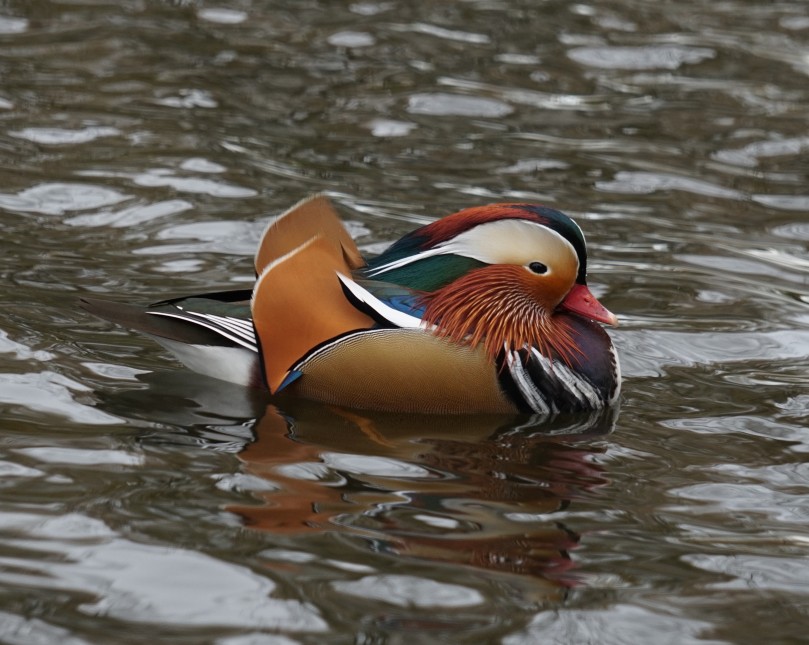
Occasional winter visitor and passage migrant.
Occasional visitors to Fairlands Valley Lakes between September and March, the first record was a drake seen between 19 and 25 March 1976. They were not recorded again until 26 February 1980 when a drake and three females were seen. There were two further records in the 1980s.
During the 1990s there were eight records. Between 2000 and 2009 six records and, between 2010 and 2019 ten records.
Since 2020 there have been 12 records: four 17 September 2020; two 17 September 2021; female 13 October 2021; drake and female 17 December 2021; two 15 October 2022; three 20 October 2022; one 1 November 2022; drake and female 1 December 2022; three 2 December 2022; drake 6 September 2023; female 22 September 2023; female 8 November 2024; drake and two females 13 October 2025, with the drake remaining until 23 October.
The most seen together are, nine on 17 January 2013.
Away from Fairlands Valley Lakes a drake was seen at the Town Centre Gardens during February 1987.
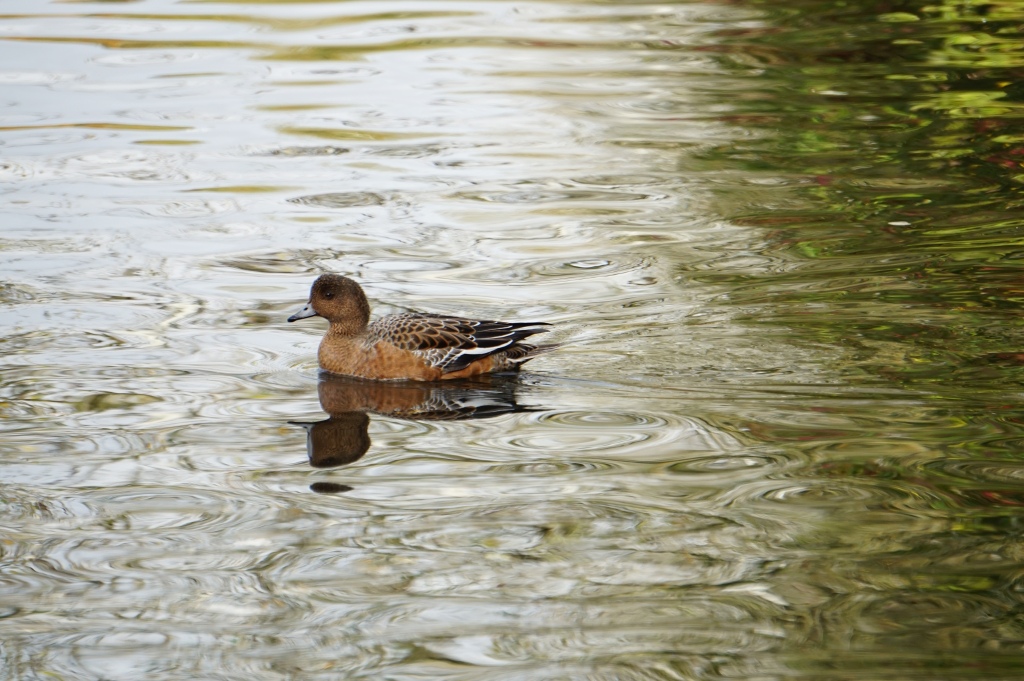
Two drakes and a duck were seen at Fairlands Valley Lakes in December 1975, and remained there during 1976, when they were also seen at the Town Centre Gardens.
[ thought or known species of introduced or captive origin ]
Occasional winter visitor and passage migrant.
Prior to 1850 when they were introduced into Norfolk, Gadwall were only visitors in small numbers to Britain. They were not recorded in Hertfordshire until 1925 and, were first recorded in North Hertfordshire in 1954 when a female was at Radwell Lake near Baldock during February and March.
Occasional visitors to Fairlands Valley Lakes between August and April (with the exception of one seen on 21 June 2024), from where they were first recorded on 1 November 1993, when a drake was seen. There were three further records in the 1990s.
Six records between 2000 and 2009 and a further six records between 2010 to 2019.
The most seen together are, five (three drakes, two females) on 20 October 1997.
Since 2020 there have been 21 records, the latest record is of one seen on 12 October 2025.
Increasing winter visitor and passage migrant.
The earliest record is of one shot at Ashtree Wood on 5 October 1907.
Occasional visitors to Fairlands Valley Lakes between August and April, from where they were first recorded in April 1979 when a female was present for nine days.
Possibly overlooked, there were no further records until 1997 when a pair were seen on 17 April, and a single bird seen on 20 October.
Between 2000 and 2009 there were five records and between 2010 and 2019 four records.
Since 2020 records have increased significantly. From the 28 August to 24 December 2022 and 30 August to 30 January 2024 birds were seen almost daily. The most recent record is three on 23 November 2025.
The most seen together are, nine on 31 December 2010 and nine (three drakes, six females) on 18 October 2023.
Away from Fairlands Valley Lakes, one was seen at Watery Grove on 2 August 1974.
Common resident breeding species and winter visitor.
In the late nineteenth century Mallards were uncommon as a breeding species in Hertfordshire. They were later described by Sage (1959), “as breeding by small ponds in the Stevenage area”.
They are now found by any of the town’s ponds and at Fairlands Valley Lakes, where the population increases in winter.
The largest flock recorded at Fairlands Valley Lakes is 325 on 12 February 2012.
30 were seen by the pond at Astonbury House on 16 February 1968 and c.80 were regularly found at the Town Centre Gardens in 1978 and 1979.
They were confirmed as breeding in three of the tetrads covering Stevenage in the 1973 Breeding Atlas, eight in the 1992 Atlas and, from five in the 2012 Atlas.
The 2012 Winter Atlas recorded their presence from eight of Stevenage’s tetrads.
At Watery Grove between 1972 and 1999 (with the exception of, 1974, 1976, 1978, 1982, 1983, and 1999), their presence or breeding territories, was recorded by the Common Bird Census with a maximum of three territories being held in 1987.
Other interesting records: eight were seen at the Old Sewage Works (now the Roaring Meg Retail Park) on 31 December 1967; a pair seen at the Moat in Whomerley Wood during March and April 1969; a pair prospecting in the middle of Box Wood on 12 April 1980; duck and three eggs found in a tree stump at Watery Grove in 1980.
Very rare visitor.
Two records from Fairlands Valley Lakes, one on 28 August 1974 and a drake on 28 April 1999.
Occasional winter visitor and passage migrant, with six summer records.
Occasional visitors to Fairlands Valley Lakes mainly between September and May, from where they were first recorded on 20 March 1975 when three were seen. A pair was also seen there on 21 May 1977.
Only one record from the 1980s, one on 13 March 1983.
Four records in the 1990s, six records between 2000 and 2009 and five records between 2010 and 2019.
Since 2020 records have increased significantly.
The summer records: a drake on 13 June 2008; one on 11 July 2017; one on 24 August 2021; four on 30 August 2021; one on 18 August 2022; two on 27 August 2022; a female on 18 August 2023; male and two females on 19 August 2025.
The most seen together are eight (one drake and seven ducks) on the Millennium Lake on 20 November 2004.
The latest record is of a pair seen on 15 and 16 December 2025.
Very rare visitor
One record: two drakes were seen at Fairlands Valley Lakes on 24 April 2013.
Frequent visitor in small numbers.
Apart from 10 birds seen flying along Fairlands Valley on 25 February 1975, Pochards have only been seen at Fairlands Valley Lakes, from where they were first recorded on 1 December 1972 when six were seen. They have occurred in every month of the year.
The most seen together are, 25 on 4 February 1980, and were the maximum count of a flock of originally 19, which arrived on the 31 January, and which remained until 7 February, there were never less than 18 during this period, and only five of the flock were females. 24 were also seen in fog on the Main Lake on 25 November 1998.
Long staying birds: a pair seen from 20 November to 19 December 1978; up to three birds from 9 February to 11 April 1979; a drake from 5 January to 12 March 1996.
The most recent record is three drakes seen on 26 November 2025.
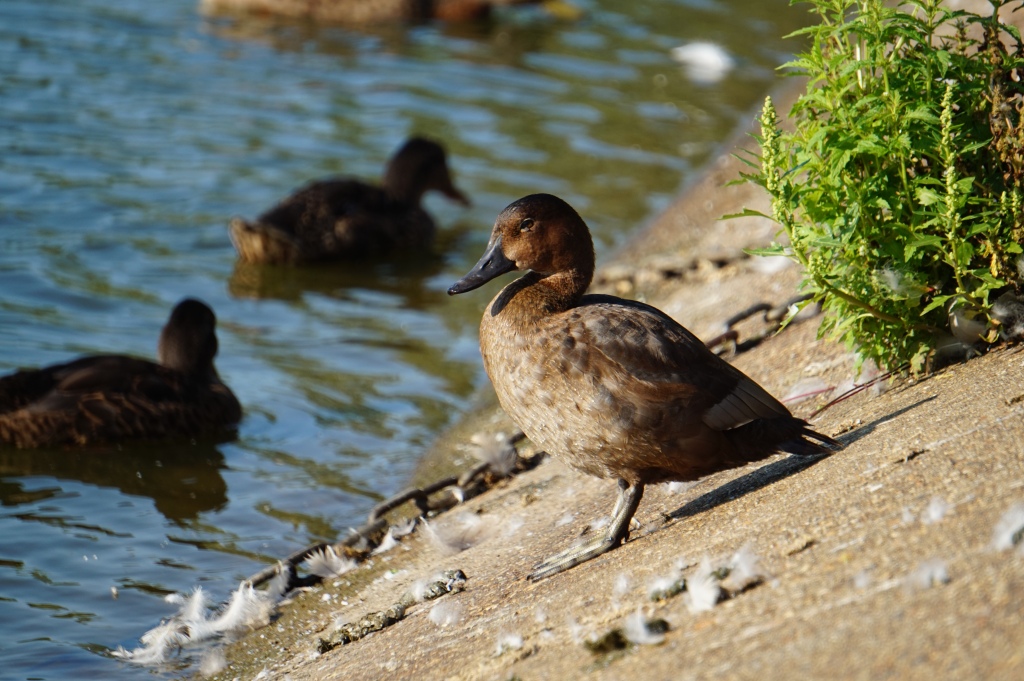
Juvenile Fairlands Lakes 24 August 2021.
Frequent visitor in small numbers.
Frequent visitors to Fairlands Valley Lakes, with records from every month of the year. They were first recorded on 21 December 1972 when three were seen. The most seen together are 12 on 7 May 2025. A long staying pair were seen there in May and June 2009, and again briefly in July, but made no attempts to nest.
The earliest record for Stevenage comes from a photograph in Stevenage Museum (PP2176), showing nine Tufted Ducks on the newly completed Town Centre Gardens Pond dated c. 1960.
A single drake was seen on several occasions at the Town Centre Gardens in 1981.
Very rare visitor.
Four records from Fairlands Valley Lakes: a female from 23 April until 2 May 1979 when it was found dead, and was given to Stevenage Museum. (This was only the second record of this species in North Hertfordshire, the first was from Radwell Mill in 1913), a male and female on 18 March 1980, a drake on 2 April 1981, and a female on 21 April 1990.
Rare winter visitor and passage migrant
Rare visitors to Fairlands Valley Lakes, the first record was a female seen from 1 to 11 February 1982. There was one further record from the 1980s, one seen on 27 December 1982.
Three records from the 1990s: a drake on 16 March 1991; a female on 9 April 1997; two females on 19 November 1997.
Between 2000 and 2009 three records: a female on 2 November 2001; a female on 30 October 2006 (possibly the same bird recorded by the WeBS in November); a drake on 23 January 2007.
Seven records between 2010 and 2019: a drake on 31 December 2011; two females on 3 November 2016; drake and female on 15 December 2016; a drake on 5 January 2017; a drake on 8 November 2017; a female on 14 November 2017; a drake on 24 November 2018.
The records since 2020: a female on 23 and 30 October 2021; two females on 23 November 2021; a female on 20 December 2021; a female on 6 February 2023; a female on 9 December 2024; a drake on 15 November 2025.
Three were also seen at the Town Centre in April 1989.
Very rare visitor
Ten records from Fairlands Valley Lakes: two on 24 November 2007; one on 31 January 2009; a drake from 3 to 12 March 2010; three in flight over the Environmental Lake on 9 February 2012; a drake on 4 December 2021; a drake on 27 December 2021; a drake seen flying over on 7 January 2024; one seen flying over on 20 November 2024; two drakes and a female on 8 December 2024; one flying over Fairlands Farmhouse on 23 November 2025.
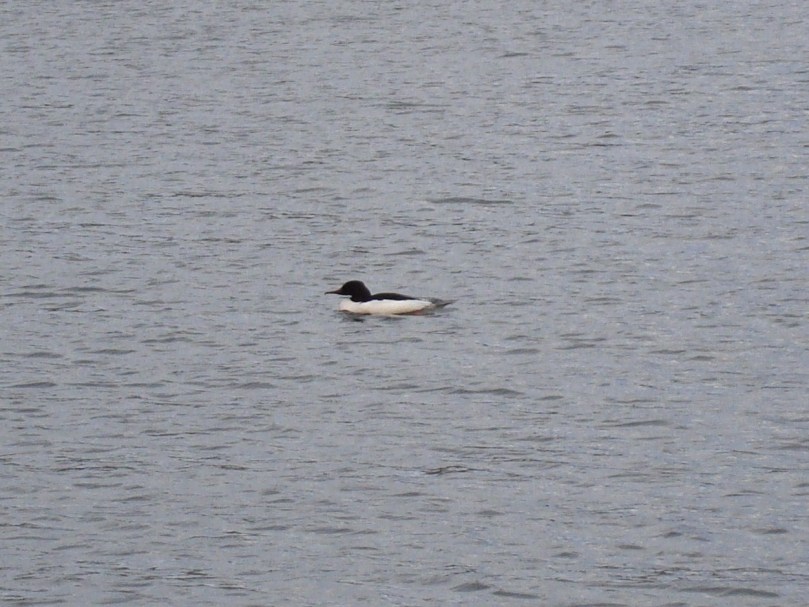
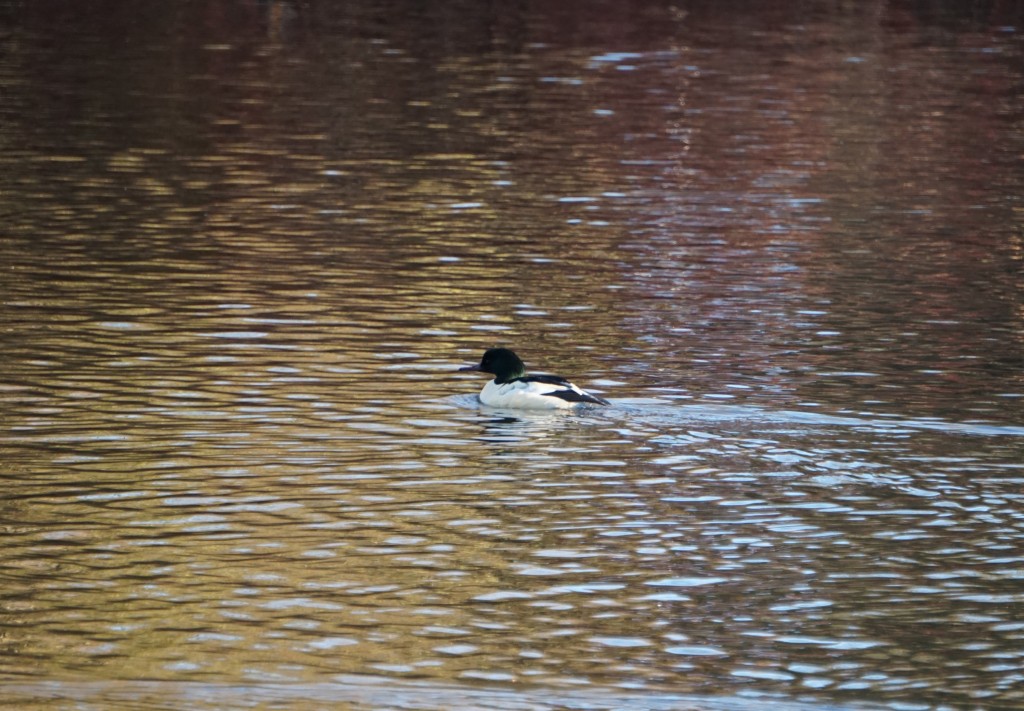
Very rare visitor.
Ruddy Ducks are native birds of North America that colonised southern and central England following the escape of captive birds from the Wildfowl and Wetlands Trust Centre at Slimbridge during the 1950’s. Their spread has been considered to be a conservation disaster as they are believed to have spread as far as Spain and hybridised with the endangered White – headed Duck (Oxyura leucocephali). In 2000 the UK Government initiated a programme of shooting to try and eliminate the species.
Three records from Fairlands Valley Lakes: One on 23 April 1983 (this was the first record for North Hertfordshire), a female on 17 July 2000 and, a drake and duck on 29 July 2000.
During the nineteenth century numerous attempts were made to introduce this North American Game Bird to Britain. The majority of birds released lasted no more than two or three years, a few did survive for up to ten years. An old female was shot near Stevenage on 12 August 1882.
One was also found at Stevenage on 7 April 1967.
[ thought or known species of introduced or captive origin ]
Rare summer visitor.
During the last quarter of the nineteenth century Quail were common as breeding birds in Hertfordshire. In 1902 Marlborough H. Pryor recorded that up to fifteen years previously Quail used to nest in the neighbourhood of Stevenage but were by then practically extinct in the area. Their decline nationally, which began at the end of the nineteenth century, has been linked to agricultural changes in Britain and the large numbers killed on migration in the Mediterranean.
One was shot at Aston End on 19 September 1893.
The other records are: one heard calling from rough ground reserved for building near Martins Wood on 5 July 1967; one calling at Aston on 7 June 1970; one heard calling as it flew over an unrecorded location at 2.30am on 25 July 1976; one heard calling at Bragbury End in June and early July 1989; a pair heard calling and seen near Norton Green on 30 and 31 May 1994; one heard calling west of Stevenage on the evening of 27 May 2003; one heard calling at Chells Green on 22 May 2004. (Chells Green was formerly a group of isolated cottages but is now part of the Hazel Park Development, Gresley Way).
Uncommon residents.
Red-Legged Partridges were introduced to Britain around 1770 by the Marquis of Hertford near Orford in Suffolk. By the last quarter of the nineteenth century following other introductions in Suffolk and Essex, they had spread throughout southeast England. The first record from Hertfordshire came from Little Almshoe near St. Ippollits in 1815. Although once common in the County there is now evidence to suggest they may be in decline.
The earliest record for Stevenage is from May 1891 when a nest with eggs was found on the ridge a straw stack at Aston.
The records from the 1960s and 1970s are: two pairs located at Aston End on 16 June 1963; six or seven at Box Wood on 30 January 1966; a pair at Box Wood on 8 April and 29 May 1966; five at Box Wood on 16 April 1967; Astonbury 3 March 1968; Holbrook Farm, Aston 31 March 1968; Fairlands Valley (occasionally seen 1969), Whomerley Wood (one in 1969); Fishers Green 1973; 10 by Watery Grove on 26 October 1973; a covey of 16 at an unrecorded location on 15 January 1974; eight by Symonds Green on 19 December 1974; two seen near Astonbury Wood and, two in the front drive of Astonbury Manor House on 10 April 1976; a pair and up to five birds Watery Grove spring 1977; breeding Astonbury 1977; a pair in fields adjoining Astonbury Wood in May 1978; an adult and 11 young seen on the drive of Astonbury Manor House on 2 July 1978 which took cover in a rose-bed; pair Watery Grove 1978; pair Box Wood 1979; covey of six Astonbury January 1979.
At Watery Grove one breeding territory was recorded by the Common Bird Census in 1977.
The records from the 1980s and 1990s are: pairs at Watery Grove and Box Wood 1981; coveys of 12 and 15 at Fishers Green on 4 December 1982; two at Box Wood on 24 April 1983; two at Norton Green Tip on 13 June 1983; Norton Green Tip 22 April 1990.
More recently the following large coveys have been seen: 17 near the River Beane at Aston End on 14 October 2010; 12 at Aston End on 15 October 2010; 13 at New Park Lane, Aston on 31 December 2010; 22 at Norton Green Tip on 23 October 2011; 12 at Watery Grove on 22 October 2013; 15 at Norton Green on 22 November 2015; 12 at New Park Lane, Aston on 26 September 2017; 12 at Lord’s Farm, Aston on 26 October 2018.
Confirmed as breeding from three of Stevenage’s tetrads by both the 1973 and 1992 Breeding Atlases, only probable breeding was considered by the 2012 Breeding Atlas from the tetrad covering Chesfield Park.
Successful breeding was recorded from Norton Green in 2020.
Their presence was confirmed in the tetrads covering Norton Green and Bragbury End by the 2012 Winter Atlas.
Red-legged Partridges can occur singly in unusual places, in the spring of 1972 one was encountered walking the wrong way around the roundabout by the Swimming Pool in heavy traffic, one was watched proceeding down Popple Way in March 1978 and, one was seen in a Fairview Road Garden on 1 July 2023.
The most recent local record is of one at Watery on 20 May 2025.
Uncommon residents.
During the Nineteenth Century Grey Partridges were numbered in millions, in 2003 it was estimated that there were only 75,000 pairs in the Country. This decline has occurred during the twentieth century, becoming more noticeable after the Second World War and accelerating during the 1960’s. The decline has been attributed to the use of insecticides on cereal crops and the loss of suitable habitat. Chemical seed dressings were recognised as causing problems to Partridges as early as the 1840’s. The Herts Bird Club Grey Partridge Survey of 2005 estimated a reduction in population of 90% to 98% since 1992. During the survey two birds were found in the tetrad covering Norton Green, and four were found in the tetrad covering Boxbury Farm.
In 1856 24 were shot at Aston End on 9 September, 55 shot at Broom Barns on 12 September and 17 shot at Monks Wood on 13 September.
The Game Book of Colonel Unwin-Heathcote of Shephalbury Manor records that 119 Partridge were shot at Shephalbury in 1893. From the same book: 30 were shot at Astonbury on 6 September 1893; two at Shackledell on 12 October 1893; 16 at Ridlins Wood on 22 November 1893; 29 at Aston End on 13 September 1894; 58 at the Monks Wood, “home beat” on 10 September 1895; and, 70 at Chesfield on 18 September 1895.
Records from the 1960’s 1970s are: a nest containing 10 eggs found near Mobbsbury, Chells on 23 June 1965; a pair at Mossbury on 24 April 1966; Box Wood on 29 May 1966; eight at Box Wood on 11 March 1967; Watery Grove 1967; a pair seen in Fairlands Valley on 14 May 1969; coveys of 15 and 20 at Bragbury End and, the Hertford Road area on 31 December 1973; six by Tilekiln Wood on 5 August 1974; pair Hertford Road 1974; a covey of 20 by Roebuck October 1975; two seen in the walled garden of Astonbury House on 16 April 1978; one at Astonbury on 9 May 1978; Astonbury 1979; 15 seen near Watery Grove on 19 October 1979; 10 in a field adjacent to Box Wood on 30 November 1979.
The records for the 1980s and 1990s are: pairs at Box Wood and Ridlins Mire in 1981; four at Box Wood on 25 January 1983; Norton Green 1983; 29 in two coveys at Norton Green on 6 January 1984; three pairs at Pryors Wood 1990; a covey of 28 seen in October and November 1992 at Norton Green; one at Watery Grove on 5 May 1993; two Holders Lane, Aston End on 7 May 1997; 12 at Bragbury End on 8 November 1997; Watton Road on 19 December 1998; Astonbury 13 February 1999; Norton Green Tip 9 April 1999.
More recently the largest coveys have been: Aston (14 between 20 December 2010, and 9 January 2011, 12 on 29 December 2021); near Astonbury (up to 12 between 21 and 25 October 2010); Aston End (12 on 2 November 2007, 25 October 2010 and, 16 October 2011); Bragbury End (12 on 4 January 2023); east of Chells Manor (12 on 2 December 2010); Norton Green (two coveys totaling 19 birds on 2 January 2008 and 12 on 22 December 2022); Watton Road, Bragbury End (15 on 2 January 2023); Potters Spring (20 on 18 August 2025).
The 1973 Breeding Atlas confirmed breeding from the tetrad covering Chesfield Park and considered breeding as probable from the other 10 tetrads covering Stevenage. The 1992 Breeding Atlas considered breeding as probable from five tetrads and, the 2012 Atlas from three.
Recent local breeding: An adult with four young at Norton Green Tip on 14 July 2014 and, an adult with seven young also seen there on 19 September, two adults and, chicks at Norton Green Tip on 16 July 2016, two adults and, approximately 10 nearly full grown birds at Chesfield Park on 26 July 2016, a covey of two adults and, five young at the rear of Lister Hospital on 3 August 2016, a covey of 10 birds at Norton Green Tip on 7 August 2017 which included juvenile birds, a single brood at Aston End in 2020 and c.10 birds including juveniles near Aston End Road on 27 July 2022.
The 2012 Winter Atlas recorded their presence from five of the tetrads covering Stevenage.
Unusual records are; a pair shot near Stevenage in 1886 by a Mr W. Garrett which had white wings and tails, a feature known as symmetrical albinism, a covey of eight seen in Rectory Lane on 10 November 2005 and one in an Edmonds Drive Garden on 20 October 2025.
The most recent local record is the Edmonds Drive bird on 20 October 2025
Uncommon residents.
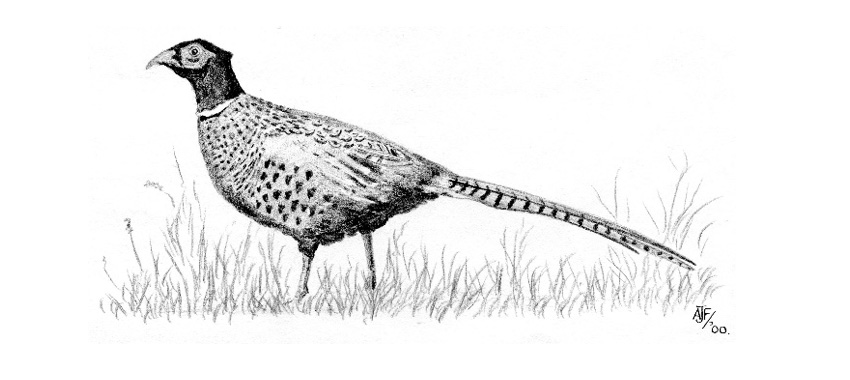
Pheasants were formally reared in the Stevenage area for shooting, notably in the woodlands of the Knebworth House Estate, and “surplus” birds supplemented the feral population.
The Game Book of Colonel Unwin-Heathcote of Shephalbury Manor records that 184 Pheasants were shot at Shephalbury in 1893. The same book records Pheasant Shooting between 1893 and 1895 from the following woods and, places, with the largest, “bags” in brackets: Aston End (15 on 30 November 1893); Chesfield (56 on 30 November 1895); Monks Wood (72 on 24 October 1893); Ridlins Wood (128 on 12 November 1895); Shackledell (23 on 23 September 1894)
They can be found in any of the town’s woods, the surrounding farmland and occasionally in gardens. Single birds have been seen in Fairlands Valley in March 1975, and in 1976. In December 1979 one roosted in a small area of woodland surrounded by houses near Broadwater Crescent. A female was outside Hanger 1 at the BAE Factory in the winter of 1982. One was seen flying over the Town Centre on 6 November 1999.
At Fairlands Valley Lakes one was seen 24 February 2010, a female on 28 October 2019, a male on 27 December 2021 and a female on 26 August 2022.
30 were seen at Norton Green on 22 September 2016 and 1 November 2020.
There is evidence of feral breeding at Ridlins Mire, on 9 July 1997 a female with two chicks was seen and, on 4 June 2006 a female and chicks were seen beside Gresley Way, near to Ridlins Mire.
The 2012 Winter Atlas confirmed their presence in seven of the tetrads covering Stevenage.
At Watery Grove up to three breeding territories were recorded in the Common Bird Census between 1972 and 1999, these probably relate to surplus or surviving birds released in the Knebworth House Estate for shooting.
Commonly kept in collections, feral populations also exist in parts of Britain as a result of escapes and releases. Males have been seen at Chesfield in 1973, Watery Grove on 30 September 1974, and Oaks Cross on 1 April 1991.
[ thought or known species of introduced or captive origin ]
Often kept on farms, one was seen at New Wood, Aston on 6 May 1996, and three were seen there on 11 April 1999.
[ thought or known species of introduced or captive origin ]
Very rare winter visitor.
One record: following bitter easterly winds and snow one was at Fairlands Valley Lakes from 14 to 23 February 1979 and was part of an unusual influx of 33 of this species inland. It was on a diminishing patch of open water where it was easily observed and photographed, and seen to eat fish. Its dives averaged 46 seconds.
Very rare winter visitor
One record: an immature was found at first light on 1 December 1993 on the Main Lake at Fairlands Valley Lakes, where it remained until 25 December. It had arrived during a spell of mild foggy weather.
Very rare visitor.
Three records: one was found alive 12 September 1974 following storm force Westerly gales on 7 and 8 September and, was later released in Wales; one found on 22 July 1977 at Hampson Park, and released on the Welsh Coast the following day; one found at Newgate on 20 September 1980, after sometime in care it too was released in South Wales, but failed to go, and was taken to a bird sanctuary in Newquay where it died later.
Very rare visitor.
Two records: one was picked up exhausted by Martins Way on 19 October 1969 and, was released by the R.S.P.C.A. on the River Mimram at Welwyn four days later; following prolonged wet and windy weather from the west, another was found alive at 7a.m. on 14 December 1978 at St. Michaels School in Sandown Road, but subsequently died and, was given to the Stevenage Museum, where there is a specimen of this species in their collection, which could be this individual.
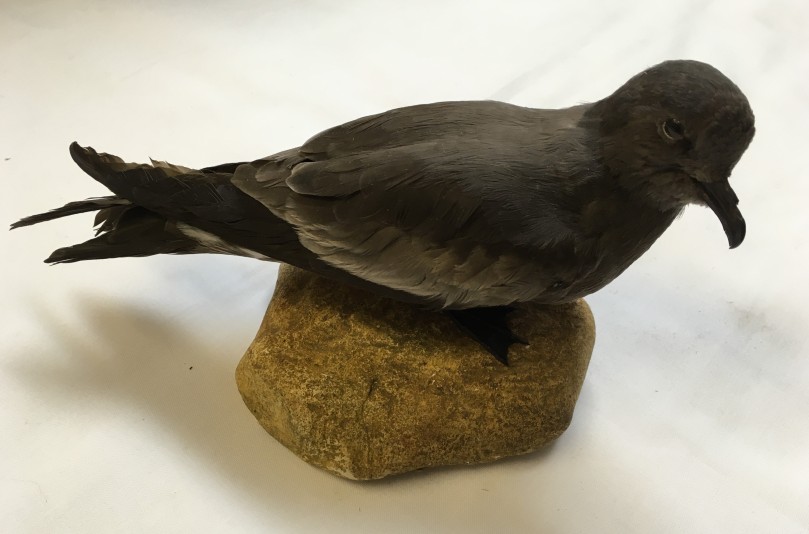
Very rare visitor.
One record: one was picked up alive near St. Nicholas Church on 6 April 1974 and handed to the Stevenage Zoological Society its fate is unknown.
Regular visitor to Fairlands Valley Lakes.
Following their protection under the Wildlife & Countryside Act 1981 and, an increase in suitable inland habitat, Cormorant numbers have increased in Hertfordshire considerably.
Regular visitors to Fairlands Valley Lakes, from where they were first recorded on 8 September 1974, with records from every month of the year, the most seen together at the lakes is 24 on 28 November 2025.
Individuals and small numbers are frequently seen flying over Stevenage and Aston (the largest numbers being seven flying north over Six Hills Way on 18 March 1994, and 10 flying over Norton Green Tip on 29 September 2021), Aston (the largest number being 10 flying over on 5 March 2019), and Astonbury Farm (eight flying over on 20 October 2024).
They have also been seen at the Town Centre Gardens and Aston End, and one was seen resting on top of a Stevenage factory chimney on 14 December 1983
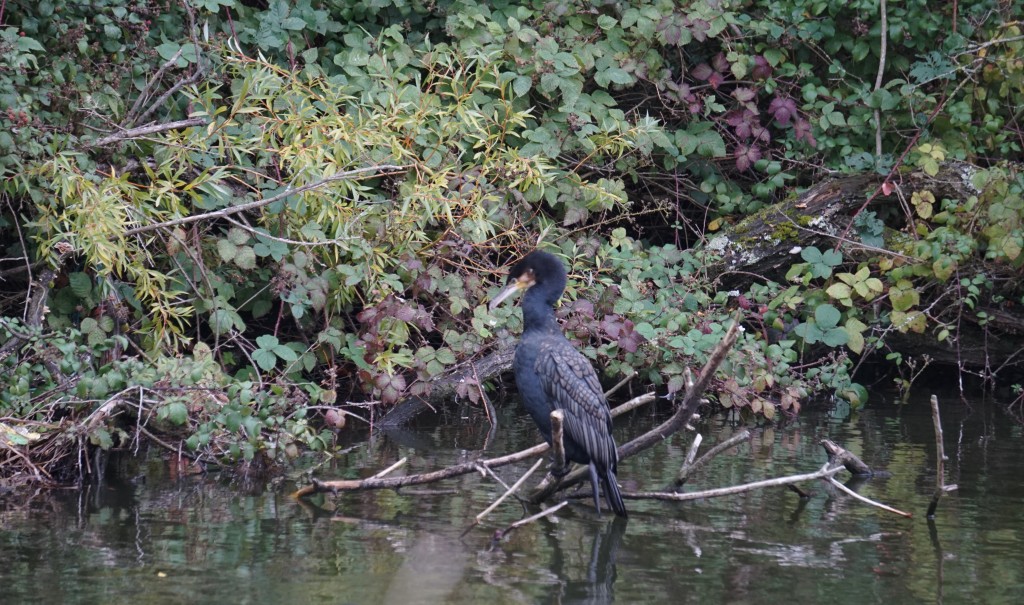
Fairlands Valley Lakes 25 September 2020
Rare winter visitor.
Two records: One on 7 November 1982 at the Town Centre Gardens and one on 25 January 1993 at an unrecorded location:.
One was at Fairlands Valley Lakes from 30 August to 5 September 2012, when it briefly visited a Stevenage Garden. It was one of two that had escaped from Blackbrooke Zoological Gardens, Staffordshire, and was finally re-captured at Sawbridgeworth on 9 September 2012.
[ thought or known species of introduced or captive origin ]
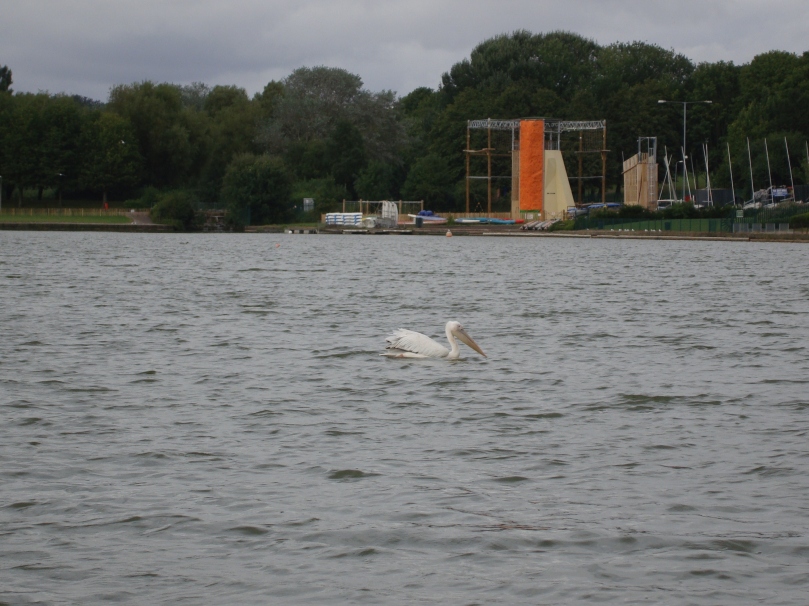
Increasing visitor.
Little Egrets are recent colonisers of Britain. Prior to 1985 there had only been two records from Hertfordshire, since 1994 they have been recorded annually, and in 2011 bred for the first time in the County. Winter roosts are being established in the Colne, Lea and Mimram Valleys.
The first record for Stevenage was of one, flying north over Fairlands Way on 25 November 2006.
There were three further records prior to 2010; one flew through Fairlands Valley Lakes on 10 August 2007, one over Bragbury End on 20 March 2009 and one at Fairlands Valley Lakes on 6 July 2009.
Between 2010 and 2019 they were recorded from: Aston Allotments (one flew over on 3 November 2015); Aston Brook (9 December 2012, 18 December 2018 and, 11 November 2019); Aston End (4 January 2015); Fairlands Valley Lakes (5 February 2012, 15 to 22 July 2012 and, 1 January 2019); Golf Course, Bragbury End (15 February 2010); Gresley Way (9 December 2012); Norton Green Tip (27 December 2018); Old Town (one on flooded School Playing Fields on 17 July 2015); River Beane, Aston (1 December 2015 and, 15 November 2016); Six Hills Way (2 flying over on 19 March 2015); Stevenage Brook (5, 6 and 12 January 2010 and, 1 December 2014).
Since 2020 there are records from Fairlands Valley Lakes for every month of the year. Other records are from: Aston (21 March 2025); Aston Brook, Gresley Way (13 January 2020, 17 January 2021, 28 November 2021 and 27 December 2022; 7 and 27 January 2023; two on 20 January 2023; one on 17 February 2023; two on 24 February 2023; two on 3 and 8 March 2023; one between 16 and 21 March 2023; two on 31 August 2023; one on 5 December 2023; one on 18, 21, 24 and 26 December 2024; one on 7 and 15 January 2025; one on 12, 17 and 18 February 2025; two on 20 February 2025; one on 1 and 24 March 2025); Golf Course (11 March 2020 and 4 May 2024); Magpie Crescent (one flying over on 11 December 2022); Norton Green Tip (7 July 2020 and 7 May 2024); Ridlins Mire (one on 12 January 2024); Ridlins Water Meadow (9 and 16 March 2020 and, 2 April 2020); Ridlins Wood: one on 3 April 2023; St George’s Way (one flying south 26 January 2025); Shackledell (13 December 2024 and 24 February 2025); Town Centre Gardens (20 and 26 June 2024); one flying north over Stevenage on 1 April 2020; one over a Stevenage Garden on 21 May 2020.
Common non-breeding visitor.
Common visitors at all times of the year to Fairlands Valley Lakes (from where they were first recorded in April 1975) and at any of Stevenage’s ponds and ditches. They are also known to raid garden fishponds.
Grey Herons suffer in hard winters and during the winter of 1962/63 the British Breeding population was halved, during that winter the remains of one was found by a pond at Symonds Green.
The most seen together are four at Fairlands Valley Lakes on 6 July 2009.
The 2012 Winter Atlas recorded their presence from six of the tetrads covering Stevenage.
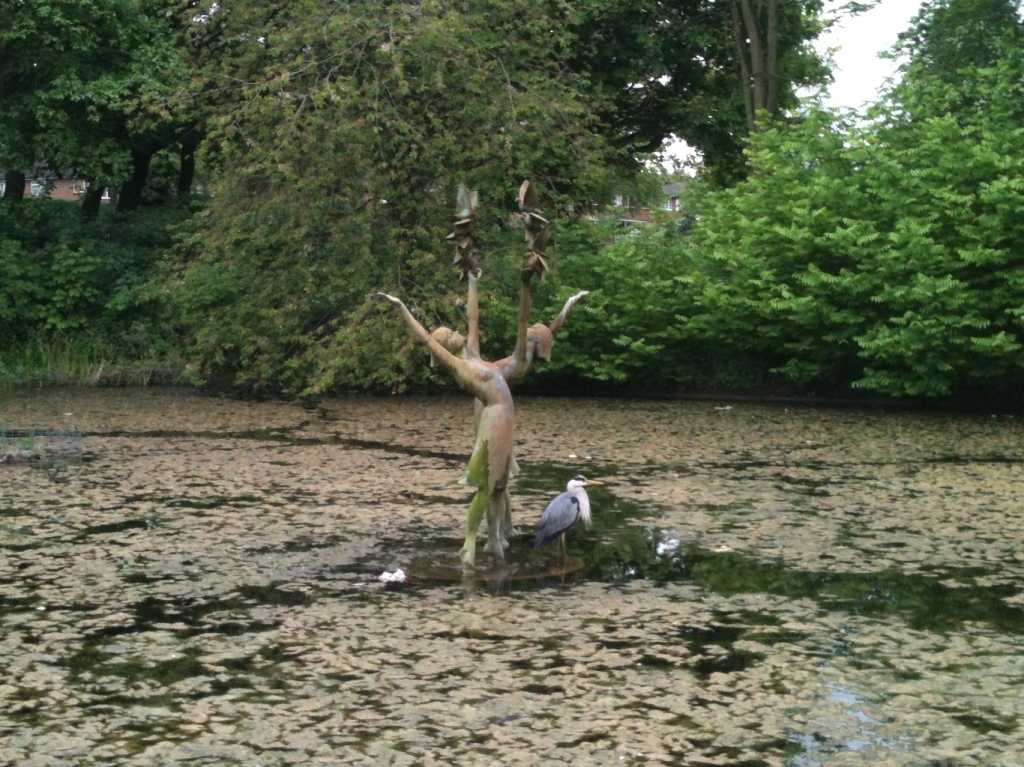
Very rare visitor
During an unusual influx of this species in Britain during the spring of 2012, one was seen over Symonds Green drifting towards Norton Green on 22 May.
On 7 April 2023 one was at Fairlands Valley Lakes perched on a lamp post and, what was considered to be the same bird was seen circling over the Main Lake on 16 April.
A bird believed to be of captive origin was also seen at Norton Green Tip on 1 April 2018.
One was seen at Stevenage on 4 May 1982, the same bird had been seen at Broxbourne Gravel Pits and Rye Meads, Hoddesdon the previous day, and it was presumed to be the same escapee, which had reappeared for the third year running at Stockers Lake, Rickmansworth.
[ thought or known species of introduced or captive origin ]
Increasing visitor, which has breed.
Foster (1914) described Little Grebes as common at Stevenage.
Increasingly seen at Fairlands Valley Lakes, from where they were first recorded on 8 February 1973. There were a further five records during the 1970s, three records during the 1980s, three records during the 1990s, three records between 2000 and 2009 and, seven records between 2010 and 2019.
Since 2020 the records are: one seen on 21 and 28 September 2020; up to two birds seen between 9 and 15 October 2021; a single bird on 5 November 2021; a single bird seen on several dates from 9 February to 21 March 2022; between one and four birds from 2 September 2022 to 10 May 2023, with two pairs on 30 March 2023; a single bird on 3 and 14 August 2023; a single bird between 11 October and 20 April 2024 (with two birds seen on 9 and 12 March and 5 and 14 April 2024); a single bird between 6 and 8 June 2024; a single bird between 29 July and 29 August 2024; a single bird on 13 September and two on 17 September 2024; a single bird on 1 October and two on 13 October 2024; two on 9 and 18 November 2024; a single bird on 1, 11 and 31 December 2024; a single bird on 1 and 7 January 2025; up to two birds from 24 February to 20 July 2025 (with three seen on 12 March and 29 May); single birds between 7 and 13 September 2025; three on 23 September 2025; two on 25 September 2025; up to two birds between 3 and 28 November 2025; a single bird on 21 and 22 December 2025.
In 2023 there were two unsuccessful attempts to nest. In 2024 an occupied nest was found but no young were seen. In 2025 breeding was successful with four young raised.
Other records for Stevenage are a dead bird picked up in the Chells area on 25 October 1974; one at Watery Grove in the spring of 1977.
Regular visitor at all times of the year, but mainly in winter and spring, that has bred.

Great Crested Grebes are regular visitors to Fairlands Valley Lakes, having first being seen there on 9 April 1974. There are records for every month of the year. When five were seen on 12 March 1975 it was at that time the largest number recorded in North Hertfordshire. Ten have since been seen on 12 April 2016.
Breeding, and attempted breeding has also occurred at Fairlands Valley Lakes; 1983 (one pair raised one young), 1984 (one pair raised four young, three of which died later), 1990 (one seen, “on eggs” on 21 April), 1992 (one pair, two/three young), 1993 (three broods, five juveniles), breeding recorded between 1994 and 1997, 1998 (attempted pairing and nest building), 2003 (a pair seen displaying between 3 and 15 April), 2004 (one pair bred), 2008 (a pair displaying on 20 April), 2010 (a pair displaying on 22 April), 2015 (three pairs displaying during March and April), 2016 (one brood and a juvenile seen on 12 August), 2019 (bird seen on a nest during August), 2020 (nest with eggs destroyed during June), 2021 (three failed breeding attempts), 2022 (failed breeding attempt).
Whilst juvenile birds have been seen in the breeding seasons of, 2002 (23 and 25 May) and, 2008 (13 June), there are no records of breeding for those years.
Very rare visitor.
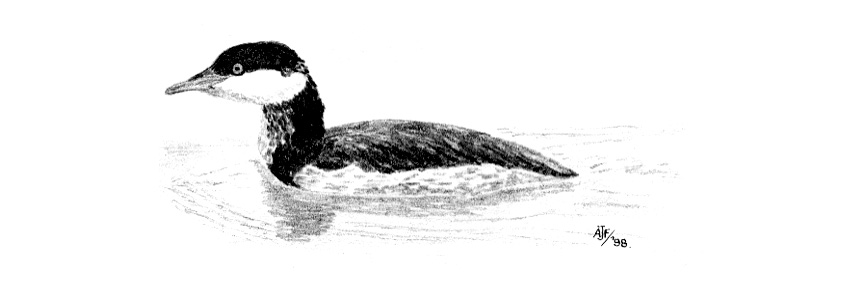
One record: one at Fairlands Valley Lakes on 1 April 1996.
Increasing regular visitor, which has bred.
In historic times Red Kites were common scavengers of rural and urban carrion and rubbish in Britain. Extinct in Hertfordshire before 1810, and exterminated in England by 1870 through persecution, the decrease in carrion, and the burial of dead farm animals. In 1989 English Nature and the RSPB began a reintroduction scheme releasing Spanish birds in England and Swedish birds in Scotland. Red Kites are now re-established at several locations including in the Chilterns, and now breed in Hertfordshire.
The first local record is of one seen over Aston on 15 February 2000.
Since 2003 they have been recorded annually at Stevenage with records for every month of the year, with the majority coming from between March and June and, are becoming a familiar sight.
The most seen together is 19, seen on 3 July 2014 in fields behind Tilekiln Wood, Great Ashby.
Four Hertfordshire wing-tagged birds have been seen at Stevenage: GY02533 tagged at Benington on 16 June 2020 was seen at Boxbury Farm on 11 August 2020; GR24054 tagged at Brocket Park, Lemsford was seen over the Old Town on 18 March 2022; GY02663 tagged at Benington on 26 June 2020 was seen at Aston End on 16 December 2022; GY18603 tagged at Hatfield on 13 June 2020 was seen at Fairlands Valley Park on 4 February 2023 (this bird was also seen at Newmarket Suffolk on 13 June 2022).
They were confirmed as breeding in the tetrad covering Aston in the 2012 Breeding Atlas.
The 2012 Winter Atlas recorded their presence from six of the tetrads covering Stevenage.
Very rare passage migrant.
Three records; a female/juvenile near Stevenage on 13 August 1990, a female flying near Dye’s Lane on 7 April 2012, one flying north over Norton Green on 19 April 2012.
Very rare visitor.
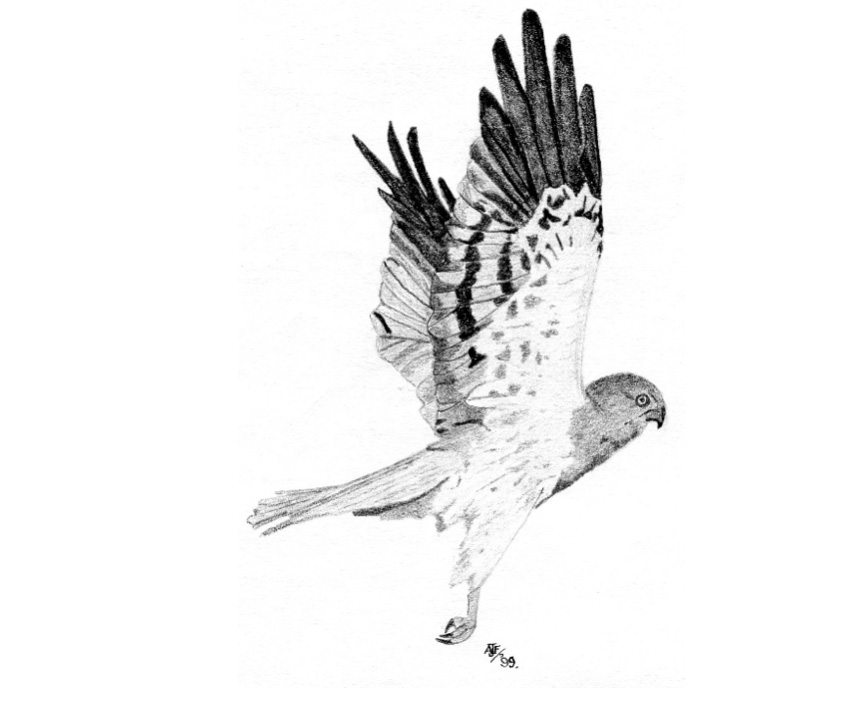
One record: reported from near Stevenage in August 1932 by Thomas Young, this record only appears as a footnote in Hine (1934) however, in the years preceding this one had also been seen at Jacks Hill near Graveley.
Common breeding resident.
The Sparrowhawk is a very resilient bird. During the nineteenth century landowners and their gamekeepers tried to eradicate it along with other birds of prey. Having survived this persecution a worse fate befell it during the late 1950’s and early 1960’s when the effects of Organochlorine Pesticides used in Agriculture brought the species to the verge of extinction in southern and eastern England. Following the banning of these pesticides it began to increase in numbers again, and by the 1980’s was increasing dramatically.
Foster (1914) reported Sparrowhawks from Box Wood, and Humley Wood (Whomerley Wood).
Having only been recorded from Stevenage on eight occasions between 1965 and 1979, with records coming from, Box Wood, Claypits Spring, Fairlands Valley, Monks Wood, and Watery Grove, their numbers increased rapidly from 1980.
In 1984 they bred again in Box Wood, and since 1984 have re-colonised Watery Grove.
The 1992 Breeding Atlas confirmed breeding from five of the tetrads covering Stevenage but, worryingly from only one tetrad in the 2012 Breeding Atlas.
The 2012 Winter Atlas confirmed their presence from all the tetrads covering Stevenage.
Two unusual records, one “successfully exploited” a Pheasant Feeder in Box Wood in 1980 and one was seen being mobbed by six Ring-necked Parakeets (Psittacula krameria) over the White Way on 12 January 2023.
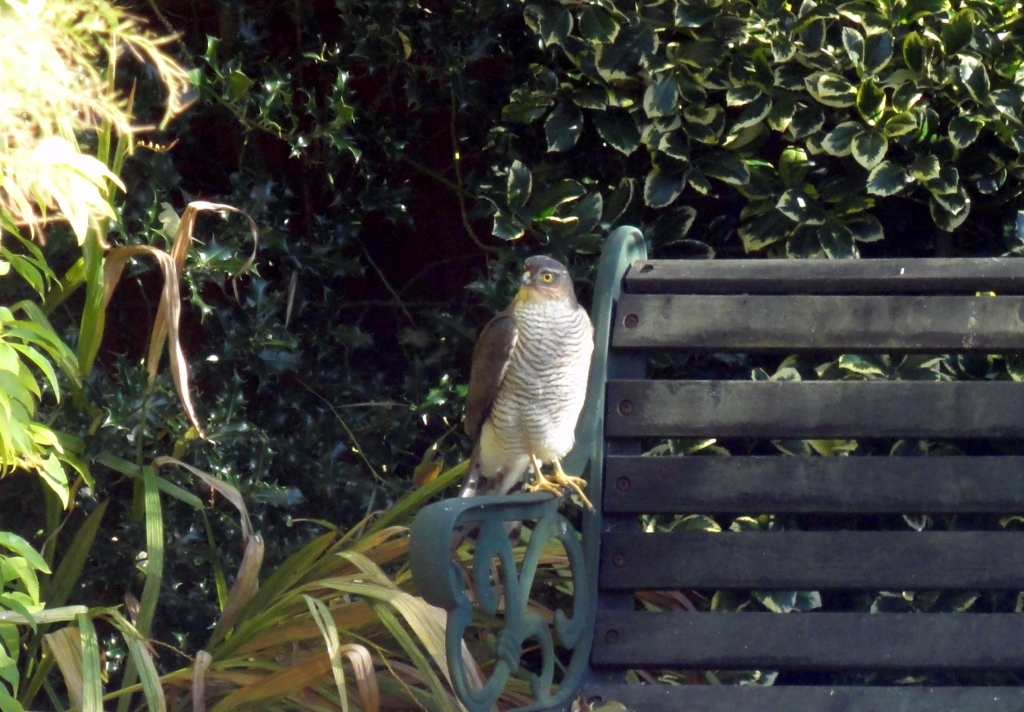
Jackdaw Close November 2013
Common breeding resident.
Buzzards were extinguished from most parts of southern England during the nineteenth century, mainly by gamekeepers who considered them as vermin. They gradually began to increase in numbers after the First World War, but were badly affected by the loss of Rabbits (Oryctolagus cuniculus), their main prey, as a result of myxmatosis in the 1950’s and 1960’s. From their former stronghold in northern and western Britain, a steady but slow expansion east has occurred.
Having previously bred in Hertfordshire prior to 1865, they bred again for the first time in 1996, and are now becoming increasingly common.
The earliest record for Stevenage comes from a letter dated 29 October 1877 from Mr G. Rooper F.Z.S. to the President of the Watford Field Club in which he states that once when hunting he had seen a pair of Buzzards in a wood near Stevenage.
Foster in Hine (1934) claimed that Buzzards had been seen at Box Wood, one had been shot between Stevenage and Walkern on 18 December 1931. They were not recorded again from Stevenage until 21 May 1968, when one was seen circling over the Old Town and being mobbed by Great Black-backed Gulls. There were two other records from the 1960s, two birds seen circling over Astonbury House on 18 September 1969 and one seen at the Town Centre in December 1969. During the 1970s single birds were seen at Fairlands Valley (30 June 1972), from Southgate House (7 August 1975), Aston (4 September 1976) and soaring over Shephall (13 September 1979). In the 1980’s single birds were seen at Box Wood (19 September and 3 October 1981), Watery Grove (3 June 1984), and Chesfield Park (27 March 1989).
During the 1990’s, when the re-colonisation of Hertfordshire took place, single birds were seen on 1 April 1992, 28 December 1995, 4 May 1996 (Norton Green), and 5 September 1999 (Pin Green Industrial Area). Two were also seen soaring north over the Town on 16 January 1994.
They are now regularly seen, particularly on the eastern and western edges of the Town, with records from every year since 2000, and in recent years, from every month of the year. The most seen together are the seven drifting over Chells Manor on 13 October 2007.
The 2012 Breeding Atlas confirmed breeding from the tetrad covering Norton Green.
The 2012 Winter Atlas recorded their presence from 10 of the tetrads covering Stevenage.
A Buzzard that was ringed as a second, year male at Stoke Ferry, Norfolk on 10 July 2010 was found dead on 4 July 2016 on the A1 Stevenage having been hit by a car.
Very rare passage migrant.
Foster in Hine (1934) claimed that Rough-legged Buzzards had been recorded from Box Wood, but no further details were supplied. An unidentified Buzzard seen at Box Wood from 23 to 30 October 1982 may have been of this species. Other possible records are of one flying over Lonsdale Road on 23 October 1985, and a, “hovering Buzzard, with legs dangling”, hunting over a rough field near Sainsburys Supermarket in Magpie Crescent on 10 November 1989, was believed to be of this species (North Herts Birders Log).
One, which had escaped from Wheathampstead was seen over the town on 8 June 1975.
[ thought or known species of introduced or captive origin ]
Very rare passage migrant
Two records: One flew south west over Colestrete on 7 September 2008 and, one flying high north, north east over Lytton Way on 31 March 2019, mobbed by a Herring Gull (Larus argentatus).
Rare winter visitor.
Water Rails are resident breeding birds in Hertfordshire and are also winter visitors from northeast Europe.
The earliest record for Stevenage is of an immature bird that was found exhausted in Broad Oak Way in 1972 (Stevenage Zoological and Wildlife Preservation Society Quarterly Members Journal Autumn 1972).
There are eleven records from Fairlands Valley Lakes: single birds seen between the Millennium and Environment Lakes on 18 and 19 December 2012, 7 and 8 April 2013, 9 March 2014 and, 17 March 2015; one seen in the Farmhouse Channel between 12 February and 23 March 2018; one at the Balancing Pond between 22 January and 31 March 2022 and, a second bird seen and heard at the Farmhouse Channel between 6 February and 1 April 2022; one at the Balancing Pond from 29 October 2022 to 1 March 2023; one at the balancing pond between 26 October 2023 and 19 March 2024; one seen in the Farmhouse Channel on 14 February 2024; one at the Balancing Pond between 4 December 2024 and 12 January 2025; one at the Environmental Lake on 30 and 31 December 2024; one at the Farmhouse Channel between 2 and 18 March 2025 (with two seen on 3 March); one seen and heard between the Millennium and Environmental Lakes from 2 and 25 November 2025; one seen and heard at the Balancing Pond on 19 and 28 December 2025.
Former rare summer visitor.
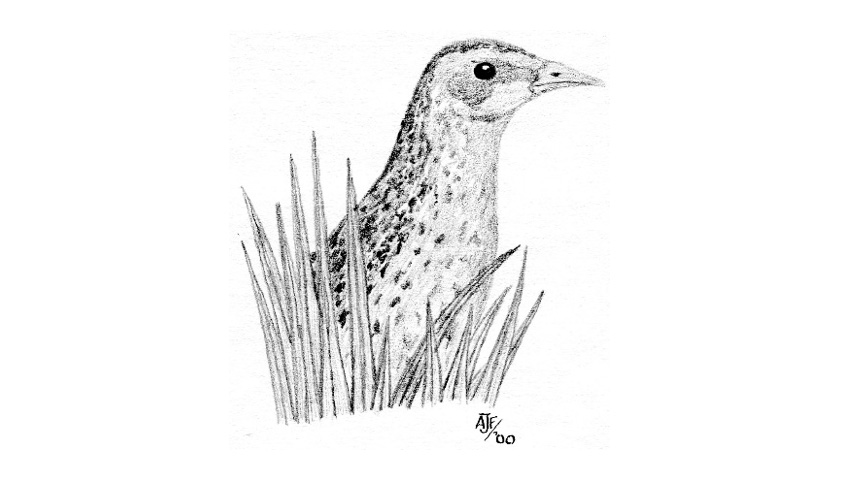
The Corncrake is an endangered species in Britain and now only breeds in the western islands of Scotland and in Ireland. Their decline has largely been attributable to loss of suitable habitat, particularly hay meadows and the introduction of mechanized hay cutting.
In the nineteenth century the Corncrake was a common breeding bird in Hertfordshire, but rapidly declined from the beginning of the twentieth century. Foster (1914) referred to the Landrail (as it was formerly known) being, “frequently met with in fair numbers in autumn and is shot whilst Partridge shooting”. The Game Book of Colonel Unwin-Heathcote of Shephalbury Manor provides the following records of them being shot whilst Partridge shooting: three at Chesfield on 16 September 1893; one at Aston End on 13 September 1894; one at Chesfield on 14 September 1895; three at Chesfield on 18 September 1895.
Other records are; one shot Broom Barns on 29 September 1902, one heard calling at Stevenage on 4 May 1931, and one heard calling in a field at Shepalbury on 18 August 1939 by a Mrs Kerr. A Corncrake was also believed to have nested near to Bedwell Plash around 1955/1956.
Common breeding resident.
Described by Foster (1914) as, “Common everywhere and often very abundant wherever there is sufficient cover near water”.
Even as late as the 1980’s, Moorhens were persecuted by Gamekeepers.
Moorhens were confirmed as breeding in seven tetrads covering the town in the 1973 Breeding Atlas, all eleven in the 1992 Atlas and from seven in the 2012 Atlas.
The 2012 Winter Atlas confirmed their presence from nine of Stevenage’s tetrads.
Despite their familiarity today, they were still considered to be rare at Fairlands Valley Lakes in 1975. Two birds became established on the Islands at Fairlands Valley Lakes in 1976 but, they did not breed there until 1979. The first record from there is of two on 9 and 10 September 1974.
The largest number recorded at Fairlands Valley Lakes is 51 on 18 September 2016 and, 15 October 2016.
During the 2018 breeding season eight broods were recoded from Fairlands Valley Lakes.
In 2024 breeding was confirmed from Astonbury Wood.
Between 1972 and 1999 at least one breeding territory was recorded from Watery Grove by the Common Bird Census with, the exception of 1985 and 1991. Two territories were held in 1978, 1989 and 1995.
Known to perch in trees and bushes, one was seen in a Larch tree at Box Wood on 17 January 1965 and one was seen perched on top of a Fir Tree at Astonbury Wood on 5 February 1978.
Although Moorhens in Britain are sedentary, some are winter visitors from the Continent. A bird ringed at, Driehoek, Castricum, Noord-Holland, The Netherlands on 20 October 2002, was seen at Stevenage on 17 October 2008.
Breeding resident and winter visitor.
Coots were first recorded from Fairlands Valley Lakes in 1973 when up to three were seen between 4 and 31 December. Since 1993 they have successfully bred there, prior to which they were mainly winter visitors. Until 1998, when they remained all summer, brooding young into August, they gradually disperse following breeding during July and August, and increased in numbers again during the winter.
The largest number recorded at Fairlands Valley Lakes is 56 on 21 August 2016.
Away from Fairlands Valley Lakes, two were found on some flood water near Box Wood on 15 January 1977 and one was at the Town Centre Gardens on 23 and 24 December 1981.
A very rare passage migrant
One record: one circling high over Chells Manor on 5 May 2013.
Very rare passage migrant which has bred in the past.
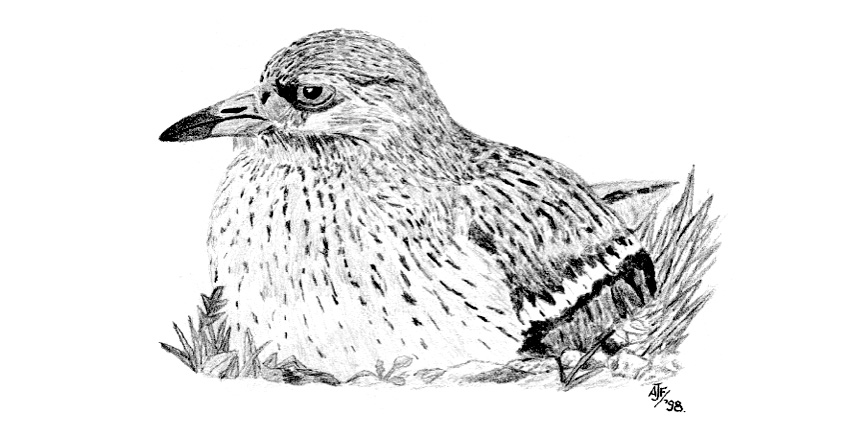
In the nineteenth century Stone Curlews bred on most of the chalk hills of North Hertfordshire from Royston to Hitchin and Stevenage, but had declined by 1899. A national decline had been noted since 1870 as sheep numbers declined and breeding sites became overgrown from lack of grazing. Stone Curlew eggs were also taken in the past and sold as Plovers eggs.
Foster (1914) described them as, “rare in the district, but locally a regular summer visitor.” The last recorded breeding in Hertfordshire was from the north east of the County in 1981.
Five Records: one was shot at Box Wood in February 1933 whilst feeding with Lapwing (Vanellus vanellus) (Hine 1934) and, after an absence of records for 74 years, single birds have since been seen at Norton Green Tip on; 4 April 2007, 21 April 2008, 28 and 29 April 2018, and 9 April 2025.
Occasional passage migrant.
Since the 1980s records of Oystercatchers in Hertfordshire have increased and in 2008, they bred in the county for the first time. Nationally there has been a 28% increase due partly to birds breeding inland.
Single birds recorded from Fairlands Valley Lakes on, 22 August 1977, 12 April 1979, 17 March 1987, 29 May 2003, 4 March 2013, 27 March 2016, 19 June 2017, 27 February 2020, 18 March 2021, 17 June 2023, 8 July 2023 and 24 April 2024. Two were seen on 11 July 2024 and three were seen on 19 May 2025.
Other records for Stevenage are, one flying low and, calling over Mildmay Road on 21 January 2013 and one flying and calling at night over Derby Way on 30 July 2023.
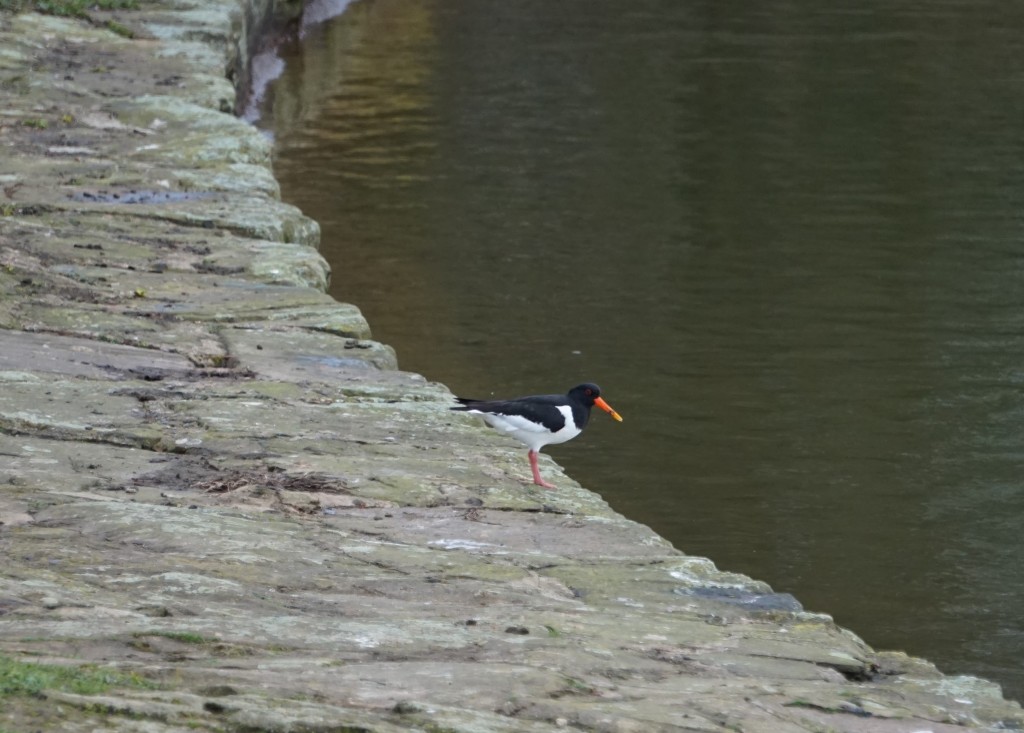
Fairlands Valley Lakes 18 March 2021
Irregular winter visitor and passage migrant.
Foster (1914) referred to flocks of many hundreds wintering in north Hertfordshire between October and April. Since then their numbers in Britain have decreased due to overgrazing and deterioration of the moorlands where they breed, and the intensification of agriculture on the arable farmland where they winter.
The 2012 Winter Atlas confirmed their presence from the tetrads covering Lister Hospital, Pin Green and, Chells Manor.
There is one autumn record of two flying over the Broadwater area and, calling on 6 August 1967, and four spring records from Norton Green Tip of, one on 21 March 2009, seven flying over on 9 April 2013, 14 flying low over on 30 March 2014 and, c.35 flying over on 2 April 2022.
The winter records for Stevenage are: 200 in the winter of 1941/2 between Knebworth, Datchworth and Bragbury End; up to 10 at Norton Green tip between 27 February and 15 March 1991; four near Holbrook Farm, Aston on 25 January 1998, up to 30 seen with Lapwings (Vanellus, vanellus) along Watton Road between Bragbury End and Knebworth on 31 December 2001 and 1 January 2002; 25 flying over Mobbsbury School, Chells on 6 December 2004; 250 along Watton Road on 1 December 2005; 130 along Watton Road on 3 January 2009.
Passage migrant and winter visitor, and scarce breeding resident.
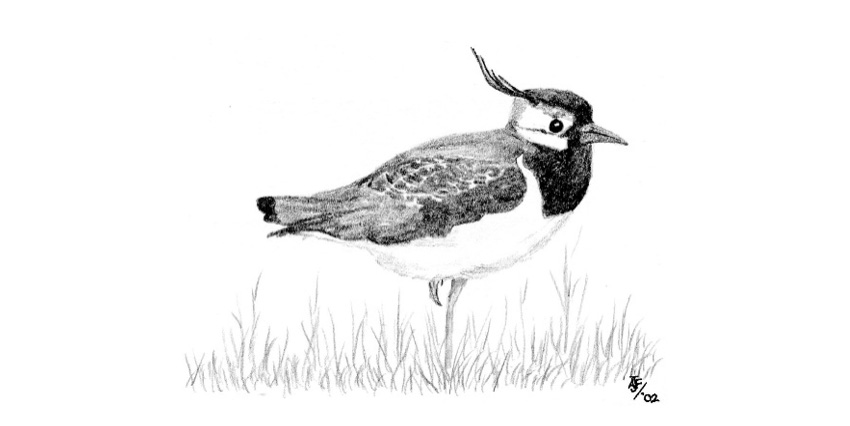
Sage (1959) described Lapwings as, “common in the Stevenage area”, they have since declined considerably as a breeding species due to the development of the town. They have also declined nationally by 43% since 1995 due to changes in farming practices such as the change from spring to autumn grown cereal crops, mechanised cultivation, chemical spraying and the reduction of pasture.
The 1973 Breeding Atlas confirmed breeding from six of the Stevenage’s tetrads, the 1992 Atlas from one. No confirmed breeding was recorded by the 2012 Atlas, with only probable breeding recorded from one tetrad (Norton Green).
The 2012 Winter Atlas confirmed their presence from the tetrads covering Chesfield Park and, Boxbury Farm.
Large numbers of Lapwings used to be found at Norton Green Tip, where they also bred. 200 were seen there on 1 March 1974, 300 on 7 December 1998 and 100 on 10 December 2004. The largest flock since 2004 is of 38 on 18 November 2014. In 1989 ten breeding pairs were recorded. A chick raised at Norton Green and ringed on 2 May 1985 was found dead at Cleder, Finistere, France on 18 March 1986, 454 Kilometres south west of the nest site. Ploughing of a set-aside field next to Norton Green Tip in early May 2018 wrecked a breeding attempt.
Lapwings were more commonly seen on autumn migration and in the winter, when they formed large flocks, such a flock used to be found in the Watton Road area between Bragbury End and Knebworth, where between 200 and 250 were seen on 24 October 1978. Other large flocks recorded are: 200 between Knebworth, Datchworth and Bragbury End during the winter of 1941/42; 100 to 200 near Box Wood between 12 and 19 August 1965; 100 near Box Wood on 10 October 1965; c.150 at Astonbury on 19 November 1972; up to 100 at Astonbury and Bragbury End in January 1973; 200 to 300 Coreys Mill on 27 December 1974; 380 near Astonbury on 19 January 1975; 200 at Coreys Mill in November and December 1976; 220 at Astonbury on 5 February 1978; 200 at Astonbury on 17 December 1978; 400 at Coreys Mill in October 1979; 120+ Norton Green area on 15 March 1980; 200+ Aston End September 1980.
Away from the rural edges of the Stevenage, they have in the past been seen at King George’s Playing Fields in winter, and in the fields of the sites of Angotts Mead and, Woolenwick School in the late 1940’s. 10 were seen at Fairlands Valley Lakes in the early morning of 25 January 1994, and a flock of 60 were seen passing over there on 23 October 2004. In 1983 a small flock was seen on a flooded piece of ground that is now the site of the Range and Wicks Stores in Broadhall Way.
The most recent records from Stevenage are: one flying over Fairlands Valley Lakes on 9 October 2021; one at Potters Spring on 12 April 2022; one at Fairlands Valley Lakes on 19 October 2022; 50+ flying west over Chells/Shephall on 18 December 2022; one near Astonbury on 31 May 2023; three flying over Fairlands Valley Lakes on 26 June 2024; one at Fairlands Valley Lakes on 30 July 2024; c.15 flying over Astonbury Wood on 24 December 2025.
.
Passage migrant which has bred.
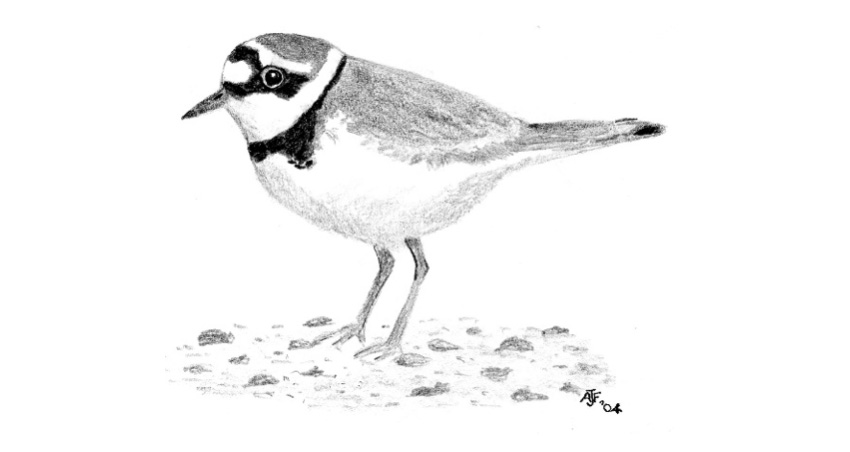
Little Ringed Plovers are recent colonisers of Britain, breeding for the first time in the Country at Tring Reservoirs in 1938. Their natural breeding habitats are river shingle and sand spits, in Britain they use gravel pits, tips, industrial sites, sewage works and reservoir margins, two of these habitats have been used as breeding sites in Stevenage.
Successful breeding was recorded from Stevenage in 1977, 1978, 1979, 1980 and, 1981 at an unrecorded location.
Between 1983 and 1992 Little Ringed Plovers were present at the former Stevenage Development Corporation Tip at Norton Green with breeding confirmed from there in 1984, (when two pairs raised three juveniles), and 1989. The earlier records may also relate to this site. “Off road” vehicle driving eventually caused their abandonment of this site and they began using nearby demolished factory sites. In 1993 two pairs raised four young at the former Kodak factory site and returned again in 1994 to this site and the former George W. King factory site. Unfortunately, the George W. King site has since been redeveloped as the Stevenage Leisure Park. A pair returned to the Kodak site in 1996 but did not breed. On 29 March 2008 a passage bird was seen at Norton Green Tip.
Passage birds have also been seen at Fairlands Valley Lakes; 14 and 20 May 1980, 29 June 1995 (when an immature was seen), 13 June 2008 (when two were seen on the bed of the drained Main Lake), up to three seen from 3 to 8 June 2009 (again whilst the lake was still drained), one on 23 March 2019 and two on 13 July 2022.
One was seen at the pond behind Norton Green Cottage (now the site of Pigeonswick Close) on 15 April 2015.
Occasional passage migrant, mainly in spring and, rare winter visitor.
Passage birds have been seen at Fairlands Valley Lakes: autumn of 1974, 3 May 1978, 29 May 1975, 18 August 1975 (when two were seen), 3, 7 and 9 May 1980 and 22 April 2024. There is also a winter record from 19 January 1996.
Other records are; of single birds at unrecorded locations on 1 September 1979 and 5 April 1982, and three at Norton Green Tip on 11 March 1989.
Rare passage migrant
Seven records: 28 flying north over Fairlands Valley in the evening of 11 May 1970; four flying north east over Box Wood on 22 April 1990; five on waste ground of the former Kodak Factory site on 2 May 2004; one flying low south, south west and calling at St Nicholas Park in the evening of 21 August 2006; one at Norton Green Tip on 6 May 2007; 20 flying south on 2 August 2008; one at Fairlands Valley Lakes on 11 April 2021.
Uncommon passage migrant.
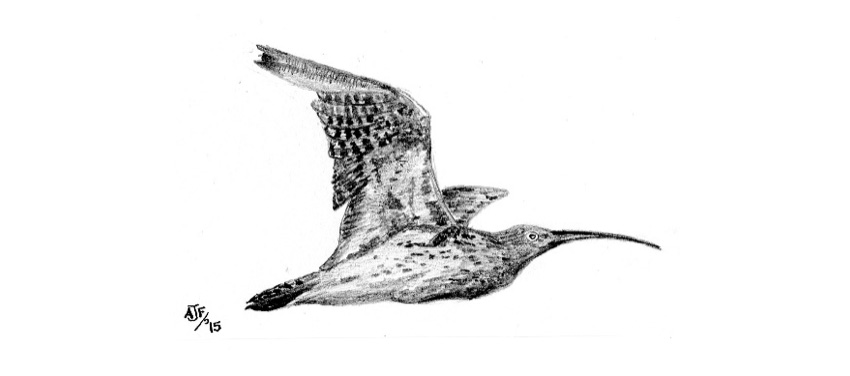
Curlew have often been recorded flying over Stevenage (including at night), indicating a regular migration route.
The earliest records are, three at Stevenage on 4 December 1884, two of which were shot, “some” Curlew flying over with three Dunlin (Calidris alpina) on 9 August 1907, and one seen on 12 September 1913.
Other records are: one calling over Box Wood on 21 April 1965; an unknown number calling at night over the Mobbsbury area on 6 July 1966; heard calling at night on 23 July 1968; heard flying over Monks Wood and Whomerly Wood 1969; an unusual winter record of four on 8 December 1973; several heard over at night on 13 March 1974; five flew over Chells at 22.00 hours on 19 June 1975; Some heard at night at Chells on 8 March 1976; Fairlands Valley Lakes 20 April 1976; four over at night, calling, 1 March 1977; One heard at Fairlands Valley Lakes 16 November 1978; Fairlands Valley Lakes 5 May 1980; two flew north on 5 July 1983; nine flew over Watery Grove on 15 May 1988; one on 26 October 1991; one flying over Norton Green Tip on 31 March 2008; one at Fairlands Valley Lakes on 3 February 2012.
Very rare visitor.
One record: one at Fairlands Valley Lakes on 27 July 1984, this was the first record for North Hertfordshire.
Very rare visitor.
One record: a reeve (female) shot at Chesfield around 1882, and was according to Crossman (1902) in the possession of Mr C. Poyntz Stewart of Chesfield Park. This was the first record for Hertfordshire.
Uncommon passage migrant.
The earliest record is of three seen flying over Stevenage with some Curlew (Numenius arquata) on 9 August 1907.
At Fairlands Valley Lakes they have been seen on spring and autumn passage and, there are two winter records. The records are: one on 3 May 1973; one on 20 December 1973; one 10 May 1974; one 25 May 1974; one 18 August and 21 September 1974; two 30 January 1976; two 25 May 1977; one 12 July 1977; one from 3 to 5 May 1980; one 23 July 1999; three 15 September 1999; one 2 May 2003; two 27 April 2004; seven seen in snow on 1 and 2 March 2018; one on 15 April 2019.
There is one record from Norton Green Tip of a bird seen on 23 March 1992.
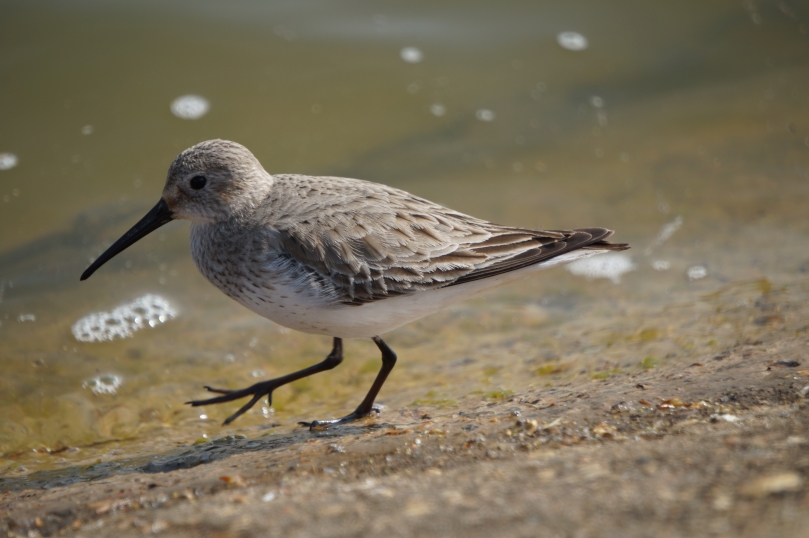
Regular spring and autumn passage migrant.
Common Sandpipers are regularly seen on passage at Fairlands Valley Lakes from where they were first recorded on 1 May 1973. Since 1994, except for 2006 they have been recorded annually.
On spring migration usually single birds are seen but, three were seen on 20 April 1977, two on 3 May 1977, four on 5 and 11 May 1978, three on 26 May 1978, five between 3 and 9 May 1980, two on 14 May 1981, two seen displaying by the Environmental Lake on 9 May 2016 and three seen on 29 April 2023 and 30 April 2024.
They are also seen on autumn migration, mostly single birds recorded during July August and September the exceptions being, two seen on 27 July 1981, four on 12 August 2004, two on 18 July 2021, two plus on 21 July 2022, two on 19 August 2022, five on 16 July 2023, three, possibly four on 18 August 2023, 15 on 13 September 2023, three on 7 July 2024 and two on 23 July 2024.
The latest date they have been recorded is 29 September 2021.
There are also five records from June: two seen on 30 June 1998; one on 26 June 2009; three on 2 June 2023; two on 30 June 2023; one on 24 June 2025.
Migration through Stevenage was also, noted by Foster (1914) and by the Stevenage Woodland Conservation Trust, which recorded in 1969 that they are often heard over Whomerley Wood at night during the spring and, autumn, indicating that Stevenage is on an ancient and regular passage route for Common Sandpipers.
In 1907 Mr S. Maples reported that a Common Sandpiper was picked up near a roadside at Stevenage and that another was killed in a pond near the sewage farm on 2 November 1907. (The sewage Farm is now the site of the Roaring Meg Retail Park.)
Other records are: one flying across the pitch at Broadhall Way during a floodlight match on 26 March 1969, one heard calling over the town on 14 August 1969, one heard calling over Chells at night on 5 July 1970, one seen by the stream at Bragbury End on 2 September 1973, one at Astonbury Manor House Pond on 18 May 1975, and one at Norton Green Tip on 3 May 2012.
Very rare autumn passage migrant.
The earliest record is of one shot near Stevenage on 1 August 1907.
Eight records from Fairlands Valley Lakes: one on 21 September 1974; two on 15 May 1981; one on 27 July 1994; two flying over and calling on 22 December 2010; one on 28 June 2018; one on 1 and 2 August 2018; one on 22 and 23 August 2019; two on 11 August 2020.
Other records are of single birds: Astonbury (by a stream) on 6 August 1975; Astonbury Wood on 27 July 1990; the Stevenage Brook (opposite B & Q) on 19 January 2009; Norton Green Tip on 27 August 2010; on a flooded field next to Norton Green Tip on 20 March 2024.
Rare passage migrant.
Two records from Fairlands Valley Lakes of single birds: 22 August 1977 and 1 September 1979 and one from Pin Green of a bird flying over on 27 May 2020.
Rare passage migrant.
The earliest record is of two shot near Stevenage in 1907, one on the 25 August and the other on 28 November. One was also shot at Bedwell Plash in November 1909, (the pond and marshy ground that is now the Town Centre Gardens in St. George’s Way.)
Eight records from Fairlands Valley Lakes: six on 27 March 1979 and, single birds on, 27 March 1981, 14 April 1997, 18 March 2003, 16 April 2003, 25 July 2015, 23 March 2019 and 18 March 2021.
Other records: two calling over Box Wood on 8 July 1981, and single birds at Norton Green Tip in February 1987, and on 22 April 1990.
Rare winter visitor.
Foster (1914) recorded that Jack Snipe had been reported from the Stevenage area.
Other records: birds seen at the Old Sewage Works, Roaring Meg on 24 and 31 December 1966 and, 4 March 1967; two flushed from, “Shephall Brook” on 2 January 1979; up to two at an unrecorded location on 1 and 27 January 1997; one at Norton Green Tip on 16 March 2005.
Uncommon passage migrant and winter visitor that formerly bred.
Woodcocks were uncommon in Britain until around 1820, during the following 10 or 20 years they had spread to breed throughout Britain. This increase was probably as a result of the protection of woodland where Pheasants (Phasianus colchis) were nesting. They are now in decline, but the cause is unknown. In Hertfordshire the decline has been noted since 1981.
The earliest record of Woodcock at Stevenage comes from the Game Book of Colonel Unwin-Heathcote of Shephalbury Manor when one was shot at Ridlins Wood on 8 January 1894. Single birds were subsequently shot at, Monks Wood (17 January and 24 October 1894), Half Hyde (1 November and 5 December 1895), Astonbury (26 December 1895) and, Humley (Whomerley) Wood (31 October 1898).
Foster (1914) stated that the Woodcock, “occurs regularly in woods near Stevenage”.
In the 1960s they were recorded from: Astonbury Wood, (1969) Box Wood (1965, 1967, 1968, 1969) and Watery Grove (1967).
During the 1970s they were recorded from (with unusual records): Ashtree Wood 1979; Astonbury Wood 1970, 1974, 1975, 1976, 1978 (one flew into conifers presumably to settle for the night 6 February 1976, five flushed during a Squirrel shoot on 18 March 1978); Box Wood 1970, 1975, 1976, 1979; Chells 1978; “Chells” Wood 1979; John Lewis Warehouse (now Costco) 1977; Martins Wood 1976; Pin Green 1979; Shephall 1978 (one sitting in a back garden on 16 November 1978), Symonds Green 1975, 1979 (one in a flooded horse field on 14 December 1979); Watery Grove 1970, 1971, 1974, 1975, 1976, 1977, 1979; Whomerley Wood 1974.
In the 1980s they were recorded from (with unusual records): Astonbury Wood 1986; Box Wood 1980, 1987; Chells 1981 (where one was seen in a garden on 6 February 1981); Monkswood Way 1988 (two seen on the water meadow at the old college, now the Asda Car Park, spring 1988); Norton Green Tip 1989; Pin Green 1989; Shephall 1989; Stevenage Football Ground, Broadhall Way 1981 (one flying over the pitch before a game on 14 March 1981); Watery Grove 1980, 1982, 1983, 1984, 1986, 1987, 1989.
During the 1990s records came from: Astonbury Wood 1994; Monks Wood 1998; Watery Grove 1990, 1994, 1999.
Between 2000 and 2009 records came from: Astonbury Wood (where three were seen on 4 December 2004); Fairlands Valley Lakes (one 31 October 2006); Fishers Green (one flying north 19 March 2005); Great Ashby Way (one flushed off waste ground on 23 December 2000); Norton Green (one 22 March 2006 and 2 January 2008); Watery Grove (“roding” bird 14 May 2005).
The records from between 2010 and 2019 came from: Aston Allotments (one flying over 17 March 2013); Box Wood (25 March 2016); Broaches Wood (28 January 2010); Chesfield Park (25 November 2017); Fairlands Valley Lakes (27 February 2019); Gresley Way (one flying over into Pryors Wood 19 December 2010); Norton Green Tip (15 and 26 October 2014, 17 January 2015, 25 March 2015); Parsons Green Wood (9 May 2015); Six Hills Way/Caxton Way (flying over 2 December 2012); Stevenage Football Ground, Broadhall Way (one landed in the goalmouth during a match on 7 December 2019); Tilekiln Wood (3 December 2014, 21 November 2019); Warren Springs (three seen in woodland edge bordering the A1 M of the GSK site 28 November 2012); Whomerley Wood (near the Moat 13 April 2018); three flushed on private land on the outskirts of Stevenage November 2012; one found dead under a garden gate 14 March 2018.
The records since 2020 are: One at Norton Green Tip on 22 February 2020, one at Watery Grove on 5 November 2020, one at Fairlands Valley on 9 November 2020, two at Monks Wood on 23 November 2020, one at Whomerley Wood on 8 March 2021 and one at Norton Green Tip on 5 January 2023.
The 1973 Breeding Atlas confirmed breeding from the tetrad covering Norton Green and considered breeding as probable from the tetrads covering Boxbury Farm and Chells Manor. The 1992 Atlas considered breeding as probable from the tetrad covering Norton Green. The 2012 Atlas did not consider breeding from Stevenage.
The 2012 Winter Atlas confirmed their presence from four of the tetrads covering Stevenage.
Common Bird Census at Watery Grove recorded their presence in 1972, 1978, 1984, 1987, 1993, 1994 and 1997 and as holding one territory in 1974.
Uncommon winter visitor and passage migrant.
Common Snipe have declined by 26% in Britain since 1995 due to habitat loss, the efficient drainage of low fields, loss of ponds and chemical spraying.
Foster (1914) described them as, “plentiful in the neighbourhood of Stevenage”.
In the 1960s they were recorded from, Box Wood, where one was seen flying over on 24 October 1965 and, the Old Sewage Works (now the site of the Roaring Meg Retail Park) on 3 January 1968 and, two seen there in 1969.
In the 1970s they were recorded from: a meadow by Ashdown Road in January and February 1977; Astonbury during the springs of 1973 to 1976 (with up to five seen on 7 and 8 April 1975 and, one put up in vegetation by the central, “pool” on 5 March 1976), one flushed from under the bridge over the a pool in the Wood on 26 November 1978, seen at Astonbury Pond in December 1978 and, in the meadow adjoining the Wood on 28 January 1979; Aston End February 1979; Fairlands Valley Lakes on 10 October 1975 and in November 1978; “Shephall Brook” nine seen on 2 January 1979; Symonds Green Water Meadow in the autumn of 1978; Town Centre one flying over on 18 March 1979.
In the 1980s and 1990s they were recorded from: Aston (where between 20 February and 16 March 1980 14 to 25 were recorded), Aston Brook on 27 and 28 January 1996; Astonbury 4 January and 9 March 1980; Norton Green Tip during the springs of 1989 to 1991, (with five seen on 10 April 1990).
The only records between 2000 and 2019 were from Norton Green Tip with two seen on 30 March 2007, one on 5 April 2007, one on 2 January 2008, four on 27 March 2008, one on 28 March 2008, one on 12 April 2009, one on 28 November 2015, one on 16 January 2016 and one on 2 January 2017.
Since 2020 they have been recorded from: Fairlands Valley Lakes one seen between 21 and 24 September 2022; one on 12 December 2022; one flying over on 27 September 2023; one at the Balancing Pond on 17 October 2025; Norton Green Tip; two on 31 August 2020; one on 26 February 2023; one flying over on 25 September 2025; Potters Spring six seen on a nearby, “set aside field” on 19 March 2024.
The 1973 Breeding Atlas considered breeding as possible from the tetrad covering Bragbury End and, the 1992 Atlas considered breeding as possible from the tetrads covering Norton Green and, Knebworth. The 2012 Atlas did not consider breeding as possible.
The 2012 Winter Atlas confirmed their presence from the tetrad covering Norton Green.
Very rare visitor.
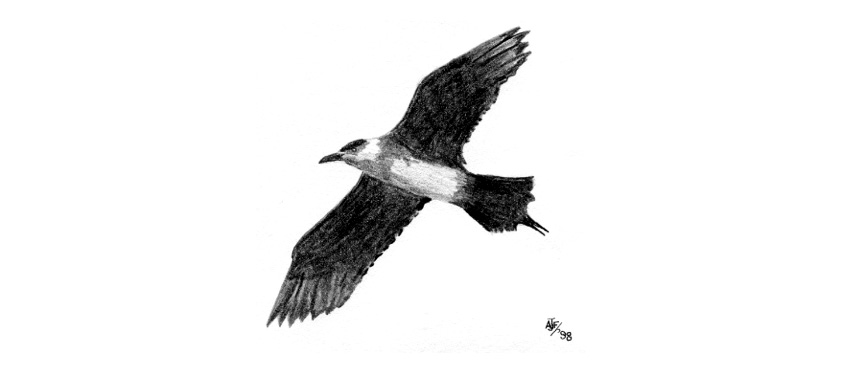
Every autumn good numbers of Arctic Skuas occur in the North Sea and there are large movements of the species from the middle of August until the end of October. They are rarely seen inland and those that are, are usually weak or storm driven individuals.
One was shot at Stevenage on 5 November 1881.
Very rare visitor.
Little Auks are Arctic birds that winter in the North Sea. They are only usually seen on the coast following and during Westerly storms when they come closer inshore. Occasionally they are blown inland, sometimes in large numbers known as “wrecks”.
One was found alive at Fairlands Valley Lakes on 13 February 1983, but died later, this was following the biggest ever “wreck” of seabirds in Britain. This was attributed to the previous month being dominated by westerly gales, which were then followed by north – easterly winds forcing already weakened birds down, mainly in the North Sea. Other birds killed in the, “wreck” were found to be emaciated suggesting that they were unable to feed due to poor weather conditions. A total of three birds were picked up in Hertfordshire, all of which are now in the County’s Museum collections.
Another was found at Stevenage on 30 October 1995 and was taken into care at Graham Dangerfield’s private zoo at Redbourn and, after recovery released in Norfolk, this was at a time when unprecedented numbers of Little Auks were recorded along the North Sea coast.
Very rare passage migrant.
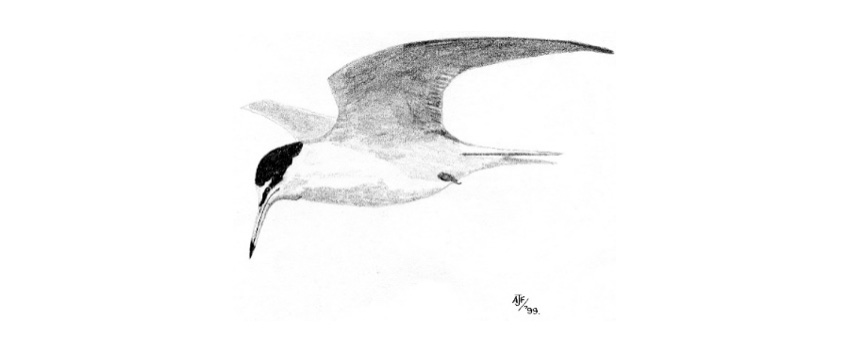
Two records from Fairlands Valley Lakes: three on 5 May 1977 and, one on 9 May 2009.
Rare passage migrant.
Four records from Fairlands Valley Lakes: one on 27 May 1977, three on 1 June 1978, three on 12 May 1980 and, one on 6 May 2011.
One was also seen flying over Kymswell Road on 23 July 2005.
Annual passage migrant and summer visitor.
Annual passage migrants and summer visitors at Fairlands Valley Lakes, from where they were first recorded on 6 May 1974 when two were seen. The most seen together there are 11 on 16 September 1980.
Since 1997 between one and seven birds have been seen at Fairlands Valley Lakes throughout the summer. Whilst they are known to travel considerable distances from their nest sites to fish, and this may account for the presence of some of them, others have been seen displaying. The nearest nest sites to Stevenage are at Amwell in the Lea Valley where artificial rafts are provided for them to nest on.
The earliest date they have been seen is 5 April 1982, and the latest date is 23 September 2017, when four juveniles were seen.
Rare passage migrant.
Five records from Fairlands Valley Lakes: one on 17 September 1980, two on 4 September 1992, two on 4 April 2008, one on 14 July 2022 and one on 16 and 17 April 2024.
Very rare passage migrant.
Four records from Fairlands Valley Lakes: one seen briefly on 3 May 2006 before flying north east, two on 3 May 2011, one on 23 April 2024 and, one on 21 April 2025.
Abundant winter visitor, passage migrant and, increasingly regular summer visitor.
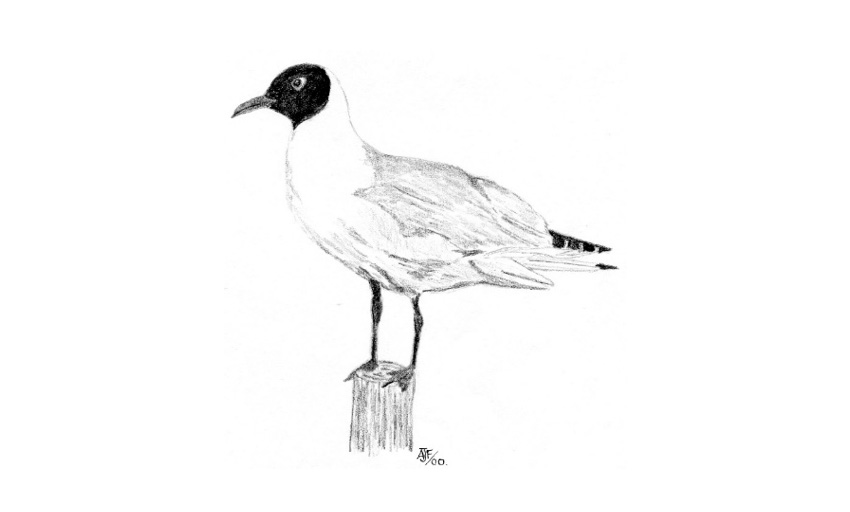
Large flocks are seen in winter passing over and, on playing fields, grass verges, and at Fairlands Valley and Lakes. 300 were seen flying south-east over Astonbury on 17 December 1978, 685 were recorded at Fairlands Valley Park in January 2009, 913 were recorded flying over Stevenage in mid-September 2020 and 1000 were at Fairlands Valley Park on 18 December 2020.
The first record from Fairlands Valley Lakes is a flock of 100, including Common Gulls (Larus canius) that spent all winter there in 1972.
Since 2009 small numbers have been seen throughout the summer, with a large flock of c.600 seen passing over on 28 August 2020. During September and October passage increases and many birds that pass through and arrive at that time are from Scandinavia, the Baltic and the Low Countries.
Ten ringed birds have been seen at Fairlands Valley Lakes:
One on 27 December 2017 and again on 29 October 2021 had been ringed X5T3 as an adult on 28 May 2016 on the island of Riether Werder, northeast Germany.
One seen on 29 June 2020 had been ringed, 2C23, as a nestling at Fishers Green, Essex on 22 June 2019.
One first seen on 31 August 2021 and twice during September 2021 that had been ringed E8Y4 as a nestling on the island of Terschelling, Netherlands on 7 July 2021 was seen again on 21 August 2023 and 31 October 2025.
One ringed, 2A53, at Fishers Green, Essex on 4 July 2017 seen on 12 July 2022.
One ringed, T5JU, as a nestling at Michalowo, Poland (c.1600km from Fairlands Valley Lakes) in June 2019 seen on 30 October 2022.
One ringed 253A as a five-calendar bird at Centre Parcs, Nottingham was seen on 2 January 2023.
One ringed 2FNV as a second calendar year bird at Pitsea Landfill Site, Essex on 6 December 2014 was seen on 10 July 2023.
One bird ringed E8VL was seen on 21 August 2023.
One ringed AB058 in Belarus on 23 May 2024 was seen in October 2024.
One ringed 2F01 at Southend was seen in October 2024.
The 2012 Winter Atlas confirmed their presence from all 11 of the tetrads covering Stevenage.
Very rare passage migrant
Four records: up to five at Fairlands Valley Lakes on 27 and, 28 March 2011, three on 11 April 2016, two on 13 April 2018 and one on 8 March 2024.
Very rare visitor
Five records from Fairlands Valley Lakes: a first winter bird on the Main Lake on 18 January 2009, one on 7 March 2010, a first winter bird on 30 October 2022, an adult on 16 November 2022 and an adult on 13 March 2024.
Regular Common winter visitor and passage migrant.
As winter visitors they are more noticeable during January, February and, March. 300 were seen at Stevenage on 9 March 1975 and, 200 were seen at the Stevenage Football Ground in Broadhall Way on 1 March 1983.
The highest number seen at Fairlands Valley Lakes is 60 on 20 December 2020. Early returning birds have been seen there on 3 July 2000 and 3 July 2016.
On spring migration, they pass through the Stevenage – Hitchin gap on route for the Wash before crossing the North Sea to the Baltic and Scandinavia.
A road casualty found at Symonds Green in 1981 had been ringed in Norway.
A bird with a numbered ring XE46 on its leg seen at Fairlands Valley Lakes on 13 August 2020 had been ringed as a, chick on the island of Langenwerder, off the German Baltic Coast on 29 June 2019. The same bird was again seen at Fairlands Valley Lakes on 21 December 2020, 12 February 2021, 15 and 25 October and 4 November 2022.
The 2012 Winter Atlas confirmed their presence from all 11 of the tetrads covering Stevenage.
Occasional, but increasing visitor, and passage migrant which has bred.
Seen increasingly regularly at Fairlands Valley, flying over the town in small numbers and, birds resting on buildings in the Town Centre.
The most seen together at Stevenage are: 12 on unrecorded playing fields on 31 July 1981; 13 at Fairlands Valley Lakes on 28 May 2017; 20+ at Fairlands Valley Lakes on 22 July 2022; 26 at Fairlands Valley Lakes on 11 June 2023; c.30 at Fairlands Valley Park in early 2024.
A pair were seen mating at Fairlands Valley Lakes in May 2016 and, juvenile birds were seen there in July 2019 which may have been locally bred.
In 2022 breeding at Stevenage was confirmed when an adult was seen feeding young on the roof of Asda Supermarket, Monkswood Way on 23 June. Three adults and seven young were seen at Asda on 30 July 2024 and at least three chicks were seen on the store roof on 17 June 2025.
A bird ringed in Norfolk was seen at Fairlands Valley Lakes on 9 August 2019, a bird ringed as a chick on the Suffolk coast in 2011 was seen at Fairlands Valley Lakes on 9 June 2021 having been previously seen in Leicestershire in 2013 and Cordoba, Spain in 2015 and a bird ringed H287V as a fledgling on the Friesian Island of Amrum, Germany on 1 July 2023 was seen at Fairlands Valley Lakes on 2 June 2025 having been previously seen at Cotesbach, Leicestershire on 11 April 2024 and Milton, Cambridge on 31 January 2025.
The 2012 Winter Atlas confirmed their presence from eight of the tetrads covering Stevenage.
Occasional, but increasing winter visitor.
Although Foster (1914) stated that they had been reported from Stevenage, prior to 1930 they were rarely seen in Hertfordshire. Their increase during the Twentieth Century has coincided with the growth of domestic refuse tips and sewage farms as the Human population has expanded.
At Stevenage they are usually seen flying over in small groups and, with birds increasingly seen at Fairlands Valley Lakes.
The largest numbers seen together are: 10 flying over Box Wood on 6 February 1966; 25 flying over Box Wood on 17 December 1972; 20 by the Hertford Road on 21 January 1974; 16 at Fairlands Valley on 26 September 1979; 11 at Fairlands Valley on 28 January 1980; 25 at Fairlands Valley on 7 February 1980; 35 Fairlands Valley Lakes on 14 February 2021; 50 at an unrecorded location on 6 November 2024.
The 2012 Winter Atlas confirmed their presence from five of the tetrads covering Stevenage.
Two birds seen at Fairlands Valley Lakes on 17 December 2022 had both been ringed at Pitsea Landfill Site, Essex. One ringed, GV37259 was ringed as a second-year bird on 2 April 2016, the other, ringed, GV15765 was also ringed as a second-year bird on 21 March 2015. GV37259 was seen again at Fairlands Valley Lakes on 24 January 2023.
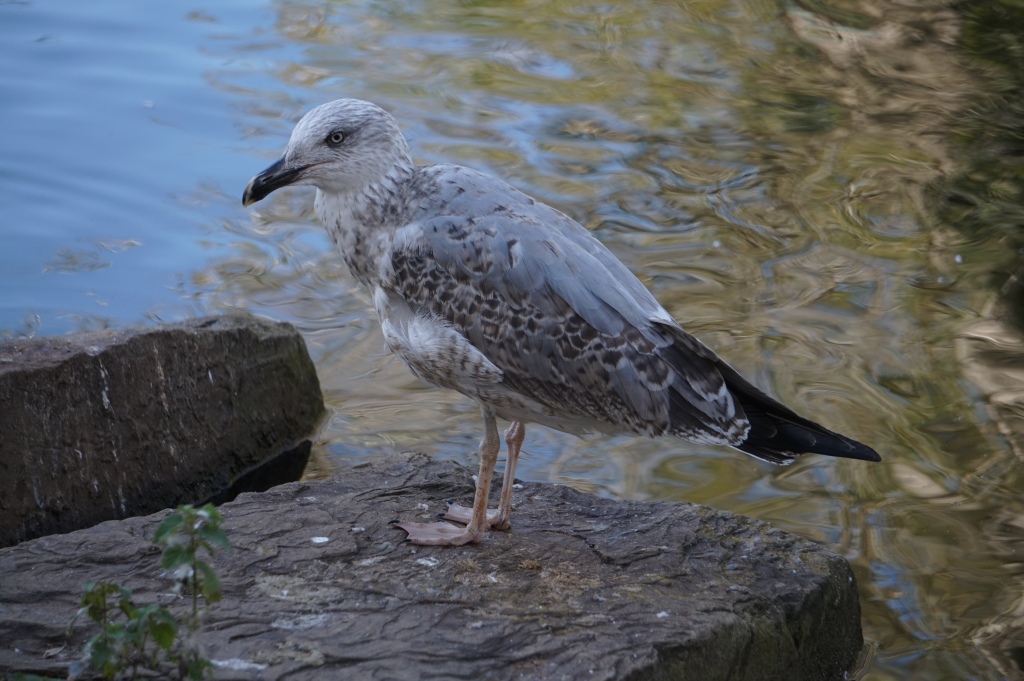
2nd Winter Herring Gull, Fairlands Valley Lakes 28 September 2020
Rare visitor
Eight records from Fairlands Valley Lakes: An adult bird on 1 January 2019; an adult bird on 13 and 14 February 2021; a juvenile on 26 July 2022; a third winter bird on 17 December 2022; an adult bird on 21 January 2024; one on 10 March 2025; a first winter bird on 13 and 19 October 2025; an adult bird on 13 December 2025.
Very rare visitor
A, “first winter” bird was seen at Fairlands Valley Lakes on 22 April 2017 with a coloured ring on its leg numbered X307. It had been ringed as a nestling at Oberspreewald – Lausitz, Germany on 6 June 2016. In September 2016 it was seen at the Thames Barrier Park, London and, at Rainham, Essex in October. It was also seen at Amwell, Hertfordshire during January and, February 2017 then, back at the Thames Barrier Park mid-March and, at Amwell again on 11 March.
The same bird was seen again at Fairlands Valley Lakes on 8, 9 and 13 January 2018 and, from 3 to 5 February 2019. Returning in the winter of 2019/20 it was seen almost daily from December 2019 to February 2020 [seen eating a Carp (Cyprinus carpio) on 15 February] and from 17 to 20 March 2020.
On 12 June 2020 it was, “recovered” at Parey in Germany and, noted as probably breeding. It returned to Fairlands Valley Lakes on 12 November and was subsequently seen on 6, 22 and 23 December 2020, regularly in January 2021 and on 12 and 13 February 2021.
On 11 October 2021 it again returned and was seen on various dates during October, November and, December and, during January 2022.
In 2022 it returned earlier than usual and was seen on 25 July and was seen again on 18 and 23 August, 24 September, 7 October, 4 November, 5 and 15 December and several dates in January 2023. It was later recorded at Altfriedland, Brandenburg, Germany on 29 March 2023.
In 2023 it returned even earlier on 21 July and, was seen again on 25 July, 17 August, 11 and 16 October, 5 and 26 December, 2, 16 and 19 January 2024.
Returning again on 25 July 2024 and subsequently seen on 27 July, 4 and 13 August, 8 September, 28 October 2024, 31 December 2024 and 19 February 2025.
In 2025 it returned on 1 August and was seen again on 26 August, 25 September and between 1 October and 14 December.
It is considered that this bird may be a hybrid with some Herring Gull (Larus argentus) genes. The colony in Germany where it was ringed is known to contain Herring Gulls and hybridisation of the two species is not uncommon.
Other records are a third winter bird at Fairlands Valley Lakes on 14 July 2022 and a first winter bird there on 23 January 2025.
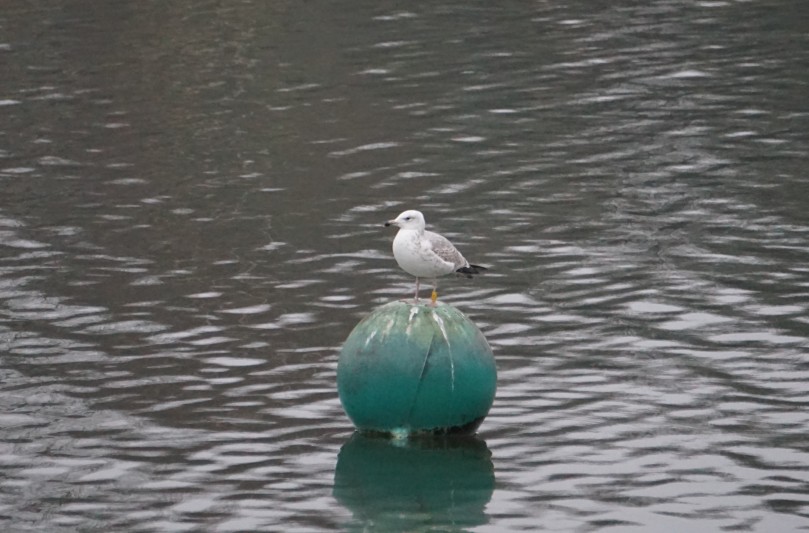
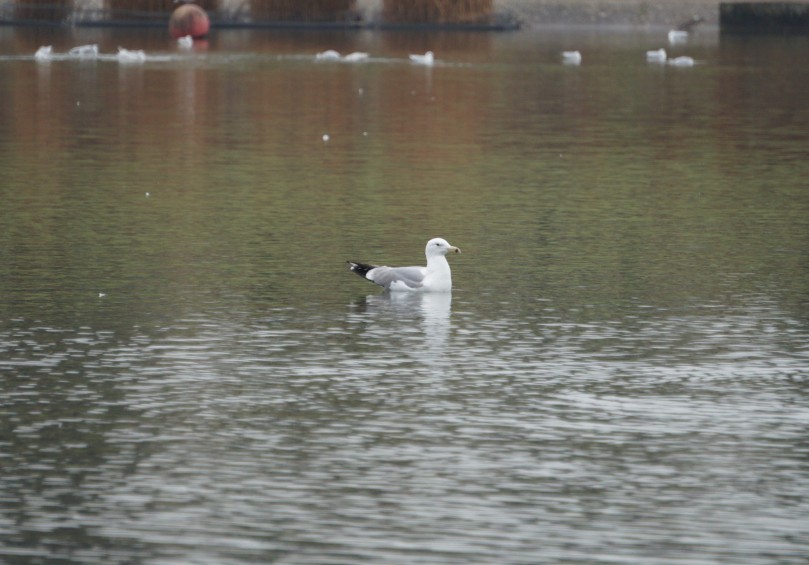
Uncommon visitor.
According to Foster (1914) they had, “occasionally occurred in North Hertfordshire, but were not common”
The records for the 1960s and 1970s are: Single birds over Box Wood on 1 January and 28 August 1965; 20 over Stevenage on 15 March 1968; six over the Old Town, mobbing a Buzzard (Buteo buteo) on 21 May 1968; seen over Monks Wood/Whomerley Wood 1969; one over Fairlands Valley on 2 August 1970; one at the Industrial Area on 10 January 1973; one at Fairlands Valley on 22 January and 18 February 1979.
One record from the 1980s with three at Fairlands Valley Lakes on 18 January 1980.
No known further records until 2016 when one was seen at Norton Green Tip on 8 September. The records since are: one at Fairlands Valley Lakes on 19 January 2020; an adult at Fairlands Valley Lakes on 11 October 2021; one at Fairlands Valley Lakes on 15 December 2022; one at Fairlands Valley Lakes on 6, 19 and 28 January 2023; a first winter bird at Fairlands Valley Lakes on 29 October 2024.
The 2012 Winter Atlas confirmed their presence from the tetrad covering Boxbury Farm.
Common resident.
Feral Pigeons were confirmed as breeding in four of the tetrads covering Stevenage in the 1992 Breeding Atlas. The 2012 Atlas recorded probable breeding in two tetrads and, possible breeding in a further seven.
The 2012 Winter Atlas confirmed their presence from 10 of the tetrads covering Stevenage.
In 2015 in excess of 100 birds were reported from the Town Centre, 100 were reported from Stevenage on 29 October 2018 and, 18 December 2019, 146 on 10 December 2020 and, 200 on 26 November 2021.
Uncommon and, declining resident.
Stock Doves were one of the hardest hit species from the effects of organochlorine seed dressings in the 1950’s, their numbers have since recovered.
In the 1960s and 1970s they were recorded from: Astonbury; Box Wood; Brooches Wood; Monks Wood; Tilekiln Wood; Watery Grove; Whomerley Wood.
During the 1980s and 1990s they were recorded from: Aston, Astonbury Wood; Box Wood; Norton Green; Watery Grove.
Since 2000 they have been recorded from: Abbots Grove; Ashtree Wood; Astonbury Wood; Aston End; Chesfield; Fairlands Valley Lakes; Holbrook Farm, Aston; New Wood, Aston End; Potters Spring.
The 1973 Breeding Atlas confirmed breeding from one of Stevenage’s tetrads, the 1992 Atlas confirmed breeding from five and the 2012 Atlas recorded probable breeding from three tetrads and, possible breeding from a further three.
Breeding was recorded from Fairlands Valley Park in 2021 and 2022.
The 2012 Winter Atlas confirmed their presence from the tetrads covering, Lister Hospital, Boxbury Farm and, Bragbury End.
The largest flocks recorded are, 70 at Box Wood on 16 February 1975, and 30 at Norton Green Tip on 13 June 1983. The most recent sizeable flock is 12 at Astonbury on 5 and 24 April 2003.
Abundant resident.
The Woodpigeon originally inhabited deciduous woodland and was in the nineteenth century considered as common in all the wooded and enclosed parts of Britain. By the last quarter of that century it was increasing and becoming more adaptable by breeding in more general habitats, this increase coincided with the growth of arable farming and the destruction of birds of prey and crows by gamekeepers which removed many of its natural predators. The downside of this increase was that the Woodpigeon became a pest because of the immense damage it does to arable crops. The Herts Express of 15 February 1957 advised Bedwell residents to keep out of Whomerley and Monks Wood for the next two or three Saturdays whilst Woodpigeon shooting took place under, “agricultural pest regulations”.
The 1992 Breeding Atlas confirmed breeding from all eleven of the tetrads covering Stevenage, this was an increase from the seven in the 1973 Atlas. This increase proved the adaptability of the Woodpigeon by increasing in an urban area and successfully making the transition from woodland and farmland to urban areas. The 2012 Breeding Atlas however, only confirmed breeding from 6 tetrads, probable breeding from 4 and, possible breeding from one tetrad.
The 2012 Winter Atlas confirmed their presence from all 11 of the tetrads covering Stevenage.
Breeding territories were recorded annually at Watery Grove by the Common Bird Census between 1984 and 1999, with a peak of 11 territories being held in 1998.
The largest flocks recorded are: 450 at Astonbury on 15 March 1967, 1,000 at Box Wood on 27 December 1973; between 500 and 1,000 at Coreys Mill on 31 December 1974; 1000 at Aston End on 1 December 2007; c. 840 over Fairlands Valley Lakes on 1 November 2021; c. 510 over Stevenage in flocks of up to 70 between 06.45and 07.30am on 2 November 2021; 1270 in flocks of up to 50 birds over Fairlands Valley Lakes on 6 November 2023; c.500 at Norton Green on an unknown date in 2023; 850 heading south over Fairlands Valley Lakes in groups of up to 70 on 24 October 2025.
Common and widespread resident.
The Collared Dove is a prime example of opportunistic exploitation. At the end of the nineteenth century it was only found in southern and central Asia. Its subsequent spread across Europe is one of the most dramatically successful colonisations of modern times. They were only first seen in Britain in 1952, and in Hertfordshire in 1957.
The earliest records from Stevenage are: pair at Humphreys End, Rectory Lane on 10 April 1966; one at the High Street on 1 October 1966; one at an unrecorded location on 1 January 1967; a pair in Monks Wood in 1969 (one of which was subsequently shot); two at Watery Grove on 11 April 1970; one at Monks Wood on 9 December 1971; three pairs Chells 1972; pairs Pound Avenue, Walkern Road, Fairlands Way and the Industrial Area 1972; pairs Aston End and Watery Grove 1973. From then their numbers built up with, 16 pairs recorded from Stevenage in 1973, and by 1976 they were considered common in the town.
Breeding was confirmed from eight of the town’s tetrads in the 1992 Breeding Atlas, which was an increase from the two in the 1973 Atlas. The 2012 Atlas confirmed breeding from two tetrads, probable breeding from five and, possible breeding from three tetrads.
The 2012 Winter Atlas confirmed their presence from all 11 of the tetrads covering Stevenage.
The Common Bird Census recorded their presence at Watery Grove in 1975, 1977, 1990 and 1993.
Approximately 50 were seen roosting at Lords Farm, Aston on 8 November 2003.
Former summer visitor now a rare passage migrant.
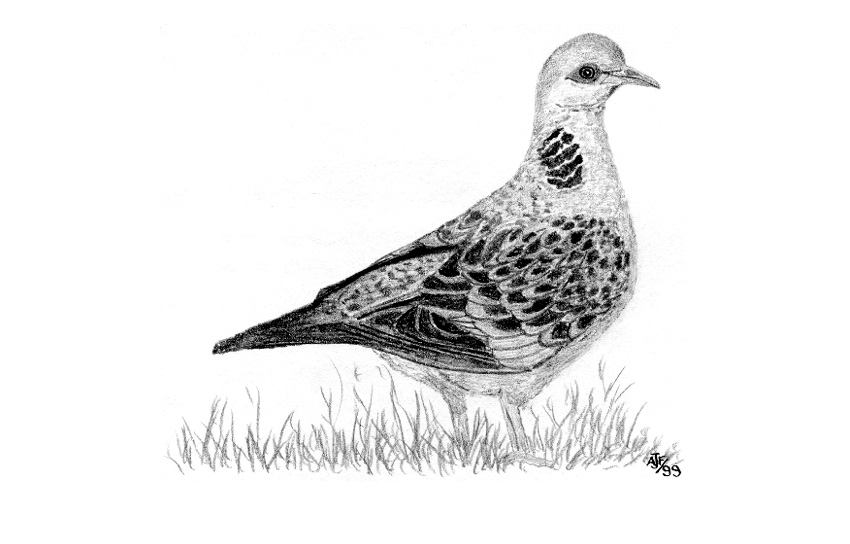
Turtle Doves were once common summer visitors to Britain, but have declined nationally by 96% since 1970, the reasons for this decline are, losses in their wintering range caused by the Sahel drought, shooting in Southern Europe during migration, agricultural changes in Britain and the intolerance of close Human pressure.
As an example of how common they once were, 40 were seen perched on wires near Stevenage on 3 July 1955.
The rapid decline locally is illustrated by the three Breeding Atlases. In the1973 Atlas breeding indications were recorded from 10 of the tetrads covering Stevenage, with breeding confirmed from the, Chesfield Park, Boxbury Farm, Norton Green and Aston tetrads. The 1992 Atlas recorded breeding indications from all 11 tetrads covering Stevenage, with breeding confirmed from the, Boxbury Farm, Pin Green and, Broadwater tetrads. No breeding indications were recorded by the 2012 Atlas for the tetrads covering Stevenage.
In the 1960s they were recorded from: Box Wood, Chesfield, Monks Wood and Whomerley Wood.
In 1972 they were described as widespread, but not uncommon at Stevenage. During the 1970s they were recorded from: Astonbury; Aston End; Box Wood (where a freshly fledged youngster was ringed on 23 September 1979); Monks Wood; Norton Green; Warren Springs; Watery Grove; Whomerley Wood.
The records for the 1980s are: Box Wood 30 April 1980 and, one ringed in September 1980; Astonbury on 7 May 1980; Roebuck 1980; 20 seen in June and July 1981 at Aston; Chells Manor and Watery Grove June and July 1981; one at Norton Green Tip on 13 June 1983; four at Box Wood on 1 May 1984; two at Box Wood on 5 May 1985; seen in Box Wood on 19 April 1986.
At Watery Grove where they were described as, “unusual visitors to the wood”. The Common Bird Census recorded their presence in 1972, 1977, 1978, 1987 and 1992.
The earliest arrival date was 12 April 1973 at Box Wood and, the latest departure date was 23 September 1978 also at Box Wood.
The records since the 1990s are: one seen flying over the Main Lake at Fairlands Valley Lakes in the evening of 19 May 2005; one on wires by the River Beane at Aston End on 9 June 2007; one in a Stevenage Garden on 21 and 26 July 2011; one at Norton Green Tip on 4 May 2012; one in an Old Town garden on 20 April 2018; one seen flying across the A1M south of junction 8 on 6 June 2018.
One was found at Jackdaw Close on 9 April 1999.
[ thought or known species of introduced or captive origin ]
Uncommon summer visitor, numbers having seriously declined in recent years.
Nationally Cuckoos have declined by 65% since the early 1980s. They are dependent on their preferred host species, such as Dunnock (Prunella modularis) and Meadow Pipit (Anthus pratensis), and as a result their population fluctuates accordingly. In 1967 a pair of Dunnocks in a Fairview Road garden died of exhaustion feeding a recently fledged Cuckoo (which also succumbed later). A Cuckoo egg was found in a Dunnocks nest at Astonbury Wood on 29 May 1977 and, on 25 June 1978 a full grown flying juvenile was seen being fed by a Dunnock at Astonbury.
The earliest record of one at Stevenage is 22 March 1894, the 1894 Bird Report noted that this information had come from a newspaper. It used to be common practice for people to write to newspapers claiming the first date of hearing a Cuckoo for the year.
The earliest (verified) spring arrival date at Stevenage is 1 April 1972 at Astonbury, the latest departure date is 1 August 1972 at Watery Grove. The most seen together are seven seen on electricity wires at Watery Grove on 10 May 1973, and up to six were seen on the same wires in May 1975.
The 1973 Breeding Atlas confirmed breeding from one tetrad and probable breeding from the other 10 tetrads covering Stevenage, the 1992 Atlas confirmed breeding from four tetrads and probable breeding from the other seven tetrads covering Stevenage. The 2012 Atlas only recorded possible breeding from four tetrads.
The Common Bird Census at Watery Grove recorded one breeding territory being held from 1972 to 1996, with the exception of 1973, 1976, 1979, 1990, 1991 and 1995, when along with 1997 and 1998, their presence only during the breeding season was recorded. Three were calling at Watery Grove on 14 May 2005.
Since 2012 records have come from Norton Green Tip, with the most recent record of one on 1 May 2020. Other records are: one recorded from Monkswood Way on 3 May 2020 and one seen flying over Stanley Road on 14 June 2022.
They were formally recorded from: Aston (last record 3 May 1995); Astonbury (last record 14 May 2000); Aston End (last record 17 May 1999); Box Wood (last record 23 April 1988); Fairlands Valley Lakes (last record 3 April 2001); Pryors Wood (last record 23 April 2011); Wellfield Wood (last record 3 April 1973); Whomerley/Monks Wood (from where their reduced numbers was commented on in 1969).
Very rare visitor, former breeding resident.
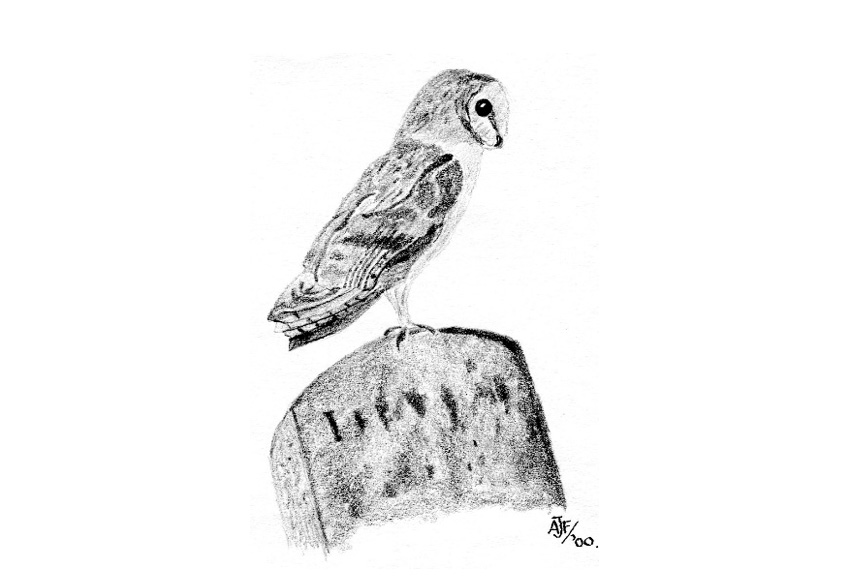
In the eighteenth century the Barn Owl was considered to be the commonest owl in Britain. In 1877 it was classed as common in all districts of Hertfordshire. A slow decrease in their numbers was noted in the nineteenth century, which was linked to the loss of nest sites, food, more organised farming methods and the inevitable persecution by gamekeepers. This decline accelerated in the twentieth century due to further losses of nest sites, the reduction of rodents in both urban areas and at farms, severe winters, the effects of organochlorine fertilisers in the 1950s and the more recent hazards of road traffic accidents. Barn Owls nationally are now an endangered species.
Locally, Foster (1914) described Barn Owls as, “common everywhere”, but in Hine (1934) he stated that they had, “diminished in numbers of late years”. R. Burleigh writing in 1948 of the Stevenage area said that they were by then rare residents. Barn Owls nested in the ruins of St Etheldreda’s Church at Chesfield after the First World War, and were seen quartering the long grass near Fairlands Valley Way prior to the development of the Pin Green area in the early 1960’s, and also used to breed at Fairlands Farm.
Breeding was considered possible from the tetrad covering Norton Green in the 1973 Breeding Atlas. The 1992 Atlas considered breeding possible from the tetrads covering Boxbury Farm and, Pin Green. The 2012 Atlas did not consider breeding at Stevenage.
The 2012 Winter Atlas confirmed their presence from five of the tetrads covering Stevenage.
In March 1977 a pair of captive birds were released at Astonbury Wood and, a further four birds were proposed to be released there in 1979. One of the released birds was seen by the Field Study Centre on 12 August 1979 having a running battle with a Jay (Garrulus glandarius).
Other records are: on found dead at Box Wood on 2 November 1969; a pair killed in separate road accidents at Bragbury End in 1969; a nest found in a hollow tree near Aston on 5 June 1970, containing four young and, the remains of, Skylark (Alauda arvensis), Meadow Pipit (Anthus pratensis) and four mice; the remains of one found in the Avenue in 1974; one near Stevenage on 25 and 28 June 1979; a pair seen near St. Nicholas on 7 May 1980; one in Watery Grove on 26 July 1981; one found dead at an unrecorded location on 11 February 1982; one at Bragbury End during February 1983; one in the middle of Stevenage on 7 and 20 October 1983; one at Bragbury End in 1984; one at Box Wood in February 1985; one at Gresley Way on 24 February 2008; one at Junction 8 of the A1m on 27 January 2010; one at Norton Green on 1 and 2 May 2010; one seen at Stoney Ford, Aston on 17 February 2011; One near Box Wood on 26 November 2011; one seen dead beside the A1m in 2012; one at Astonbury Lane on 5 March 2015; one at Aston on 6 August 2015; one at the River Beane, Aston End on 7 and 21 May 2020; one at Watery Grove on 31 March 2025; one found dead on the A1(m) near Norton Green on 11 April 2025.
A nestling ringed at an undisclosed nest site near Stevenage on 3 July 2000 was found dead at Nazeing in Essex on 2 February 2001. Two nestlings that were also ringed at an undisclosed nest site near Stevenage on 9 July 2001 found their way to Lincolnshire in their first year, one was found dead at East Heckington near Sleaford on 8 October 2001, and the other found dead at Spalding on 20 May 2002. Also in 2002 there is a record of a pair raising three young near Stevenage.
Uncommon residents of the farmland edges of the town.
In the early nineteenth century Little Owls were occasional visitors to Britain from the continent. In the latter half of that century they were successfully introduced to the Country. The first Little Owl recorded in Hertfordshire was shot at Ashwell in 1877, and they first bred in the County in 1897.
Several Little Owls were shot at Stevenage in 1906. The Bird Notes for 1907 contains the following note by Mr S. Maples (Stevenage) from the, “Zoologist” September 1907, “On September 20th a ‘keeper shot one (Little Owl) at Stevenage at about 5 o clock in the afternoon. This was brought to me and is now in my collection. It proved on dissection to be a female but is in very bad plumage. I have since heard from the same Keeper that there are some more Little Owls in the neighbourhood and that they have taken to a tree covered with Ivy: If this is the case it would be reasonable to suppose that they have nested here”. Foster (1914) described them as, “common in the Stevenage district”. In 1919 a Mr Meiklejohn recorded that he had a Little Owls’ nest at Stevenage containing five eggs and, regarded it as an exceptional clutch.
In the 1950s Little Owls were, considered to be the commonest Owl of North Hertfordshire.
The 1973 Breeding Atlas confirmed breeding from one of Stevenage’s tetrads (that covering Knebworth) and probable breeding from two others, the 1992 Atlas considered breeding as probable from seven tetrads, but no confirmed breeding and, the 2012 only considered possible breeding from one tetrad (that covering Bragbury End).
The 2012 Winter Atlas confirmed their presence from the tetrad covering Knebworh.
Little Owls can be found on the edges of the town, and until quite recently were frequently seen along the Watton Road between Knebworth and Bragbury End (the latest record of a bird seen near the Crematorium on 6 July 2012).
In the 1960s two dead birds seen on a Gamekeepers, “gibbet” in a spinney near Box Wood in 1965, one at Mossbury on 24 April 1966, two at Colestrete on 7 July 1966, one in Danestrete on 20 May 1967 and one at Astonbury in April 1968 and on 24 April 1969.
The records for the 1970s are: Astonbury 31 January 1970, 1 March 1970 and 5 April 1970; one at Watery Grove on 4 May 1972; one at Symonds Green on 28 February 1974; Aston End September 1976; one at Astonbury on 19 June and 3 September 1977 and, two, possibly three on 7 August 1977; Holbrook Farm, Aston June and July 1977; one at Astonbury Wood on 23 April 1978; seen in the meadow adjoining Astonbury Wood on 28 January 1979; one being mobbed at Astonbury Wood on 11 March 1979; one at Astonbury Wood on 1 April 1979; one at Aston 24 June 1979.
During the 1980s: one seen at Watery Grove in 1980; two at Astonbury in February and August 1980; one by Collenswood School on 14 June 1981; one at Holbrook Farm, Aston on 14 November 1981; one at the Lister Hospital on 6 June 1982; breeding proven from Stevenage in 1983; a leucistic (white) bird at Box Wood in June 1984; one at Astonbury Wood on 18 February 1985; one at Astonbury Wood in 1986.
Only two records during the 1990s: possible breeding at Aston End 1990; a pair at Norton Green in 1993.
The records since 2000 are: two at Astonbury Wood in 2001; one by the Golf Club Entrance on 28 May 2005; two at Watery Grove on 30 July 2005; up to three at Aston in 2006; one at an unrecorded location on 16 June 2008; one at Astonbury on 8 December 2012; two at Norton Green on 29 March 2014; two calling at Aston End on 4 January 2015; one heard at Aston End on 11 September 2016; one at Chesfield Park on 23 July 2018; up to five seen at Lord’s Farm, Aston End between 6 and 26 July 2019; two at Lord’s Farm on 8 February 2020; one at Aston End 7 May 2020 and recently fledged bird(s) there on 23 June 2020; single bird seen at Lord’s Farm during June 2020 and on 7 December 2020; one at Lord’s Farm on 19 June and 8 July 2022.
Uncommon breeding residents.
Like other birds of prey in the nineteenth century Tawny Owls were regularly shot by, gamekeepers. Having recovered from this persecution in the first half of the twentieth century, their numbers declined again from the effects of toxic insecticides in the late 1950s and early 1960s, and the very cold winter of 1962/63.
In the 1960s they were recorded from: Astonbury; Box Wood; Fairview Road; Grace Way; Monkswood area; Mossbury House; Farm Buildings in Six Hills Way; Watery Grove; Whitney Wood (where one was found dead on 18 May 1968 which seemed to have choked on a mouse or vole which was stuck on its lower mandible), Whomerley Wood. One was also seen to take a Sparrow at dusk in the garden of 2 Lodge Way in 1967.
Records for the 1970s came from: Aston; Astonbury Wood (where one was seen being, “mobbed” on 9 July 1978); Aston End; The Avenue; Barclay School; Barnwell School; Broadwater; Brooches Wood; Box Wood; Bury Mead; Chells; Mobbsbury House; New Wood, Aston End; Old Town; Pin Green; Popple Way; Shephall; Shephalbury; Symonds Green; The Towers, Town Centre; Watery Grove; Whitney Wood; Whomerley Wood; The Willows.
A Tawny Owl pellet found at Astonbury Wood in 1978 contained the bones of Wood Mouse (Apodemus sylvaticus).
1980s records came from: Astonbury Wood; The Avenue; Box Wood (where five were recorded on 15 March 1980); Chells Manor Woods; Gresley Way (where one was a road casualty in September 1981); Popple Way; Ripon Road area.
In the 1990s they were only recorded from Astonbury Wood and Watery Grove.
Between 2000 and 2009 records came from: Exeter Close; Fairlands Valley Lakes; Monks Wood; Pin Green; Watery Grove.
Between 2010 and 2019 records came from: Abbots Grove; Ashtree Wood; Aston End Road; Collenswood; Fairlands Valley Park; Fairview Road; Mossbury School.
Since 2020 they have been recorded from: Abbots Grove; Astonbury Wood; Edmonds Drive; Fairlands Valley Park; Pin Green; Watery Grove.
The 1973 Breeding Atlas confirmed breeding from two of Stevenage’s tetrads, the 1992 Atlas from four and the 2012 Atlas only considered breeding as possible from three tetrads. Breeding was confirmed from Stevenage in 2015, 2021, 2022, 2023 and 2024 and, Aston in 2018.
The 2012 Winter Atlas confirmed their presence from six of the tetrads covering Stevenage.
The Common Bird Census at Watery Grove recorded their presence during the 1972, 1976, 1979 and 1991 breeding seasons.
Rare winter visitor, which may have bred in the past.
Mr Marlborough H. Pryor recorded in 1900 that Long-eared Owls were on the increase in the neighbourhood of Stevenage, and Foster (1914) claimed that they nested near Stevenage.
One was found dead at Box Wood on 15 April 1969 and, three were reported from the wood on 22 February 1971, subsequently pellets were found on 13 March 1971 and 1 May 1971.
One was seen at Watery Grove on 22 October 1989.
Rare winter and spring visitor.
Mr Marlborough H Pryor stated in 1900 that he had seen as many as thirty Short-eared Owls in a plantation north of Stevenage. Although this record is debatable, it is known that the numbers of Short-eared Owls varies dramatically with fluctuations in Vole populations, the Field Vole (Microtus agrestis) being their main food source. In the nineteenth century there were periodical “Vole plagues” in Britain, causing damage to young plantations. At such times Short-eared Owls flocked to the infected districts, it is not known whether Mr Pryor was referring to such a “Vole year”. Mr Pryor also claimed that one or two had been known to stay throughout the summer. Crossman (1902) described them as winter visitors appearing some years in considerable numbers. He also stated that they were, “often flushed out of turnips and rough grass in October and November.” Foster (1914) recorded that Short-eared Owls were, “frequently put up from cover by sportsmen whilst Partridge shooting.”
Other records; one on 1 December 1978, one at Norton Green on 17 April and 3 June 1984, one near Stevenage on 19 April 1986, one at Norton Green on 5 April 1995 and, one at Norton Green Tip on 2 April 2017.
Very rare summer visitors which formerly bred.
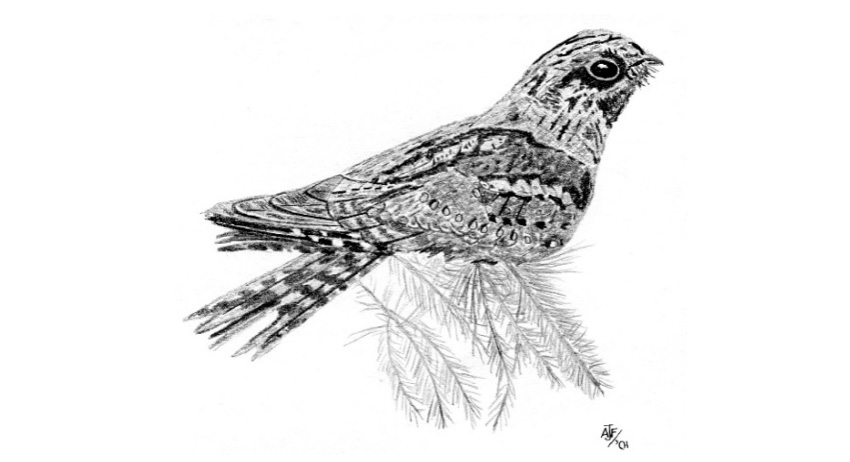
In the nineteenth century Nightjars were considered to be common in Hertfordshire. Foster (1914) stated that they were numerous in woods near Stevenage, in Hine (1934) he recorded that they bred in woods at Chesfield. Their decline in the County is as a result of habitat loss. As their traditional habitat of heathland dwindled they colonised conifer plantations, but as these matured they too became unsuitable.
Common summer visitor and passage migrant.
Swifts are dependent on old buildings for nesting. Modern building design, materials and regulations are reducing potential nest sites. It is hoped that the use of Swift Boxes and the inclusion of Swift Bricks in, “new build” housing may help the situation.
They generally arrive in Stevenage during the first week of May and depart again during the first ten days of August. The earliest spring arrival date is 21 April 2018 when three were seen at Fairlands Valley Park, the latest departure date is 7 November 1982.
They are regularly seen in the High Street particularly around Holy Trinity Church and the Old Town generally. 40 were seen at the Old Town during July and August 1975, up to 80 were seen at Sish Lane between 17 and 20 July 1976, 60 were seen at Popple Way on 12 August 1978, 30 were seen over the Old Town on 24 July 2014, 50 over the Old Town on 28 July 2016 and 50 over the Old Town on 27 July 2023.
The largest numbers seen are: 100 plus flying low over fields near Boxfield Cottage (now Chells Manor) on 18 July 1976; 100 plus seen for at least three hours over Watery Grove on 23 July 1978; 60 at Popple Way on 12 August 1978; 400 at Fairlands Valley Lakes on 6 July 1980; 60 at Norton Green Tip on 3 August 2014; 100 plus at Fairlands Valley Lakes on 6 June 2023.
The 1973 Breeding Atlas confirmed breeding from six tetrads covering Stevenage, the 1992 Atlas confirmed breeding from five tetrads and the 2012 Atlas confirmed breeding from two tetrads.
In 2018 nesting was reported from Stevenage. In 2020 birds were seen visiting a nest site in Pin Green and in 2021 two were seen entering eaves in Stanley Road.
In 2023 nesting was recorded from Basils Road (two nests including one on the Bunyan Baptist Church), Greydells Road (one nest), Haycroft Road (four nests), Julians Road (one nest), Lawrence Avenue (two nests), Lister Hospital (two nests), Stanley Road (one nest) and, Whitesmead Road (one nest).
In 2024 nesting was recorded from Alleyns Road (one nest), Basils Road (two nests including one on the Bunyan Baptist Church), Essex Road (one nest), Greydells Road (one nest), Haycroft Road (three nests), Hayfield (three nests including the first record of use of a Swift Box), Julians Road (one nest), Lawrence Avenue (two nests), Lister Hospital (one nest), Rowan Crescent (three nests), Stanley Road (one nest), Stanmore Road (one nest) and Whitesmead Road (two nests).
In 2025 nesting was recorded from Alleyns Road (one nest), Aston End Road (one nest), Bader Close (two nests, both in nest boxes), Basils Road (two nests), Bedwell Crescent (one nest), Boxberry Close (one nest), Constantine Close (four nests), Cromwell Road (one nest), Essex Road (one nest), Greydells Road (one nest), Haycroft Road (four nests), Hayfield (five nests, one in nest box), Knights Templar Green (one nest), Lawrence Avenue (two nests), Lister Hospital, Strathmore Wing (four nests), Rowan Crescent (six nests), Sish Lane (one nest), Stanley Road (one nest), Stanmore Road (one nest), Sweyns Mead (1 nest), Victoria Close (one nest), Walkern Road (three nests), Watercress Close (eight nests) and Whitesmead Road (four nests).
Very rare vagrant.
Two records, one was seen flying across Six Hills Way from Fry Woods at 06.15am on 6 June 1985, and settling briefly on the grass verge next to Collenswood, and one was in a garden at Aston from 16 to 18 May 1989.
Very rare vagrant.
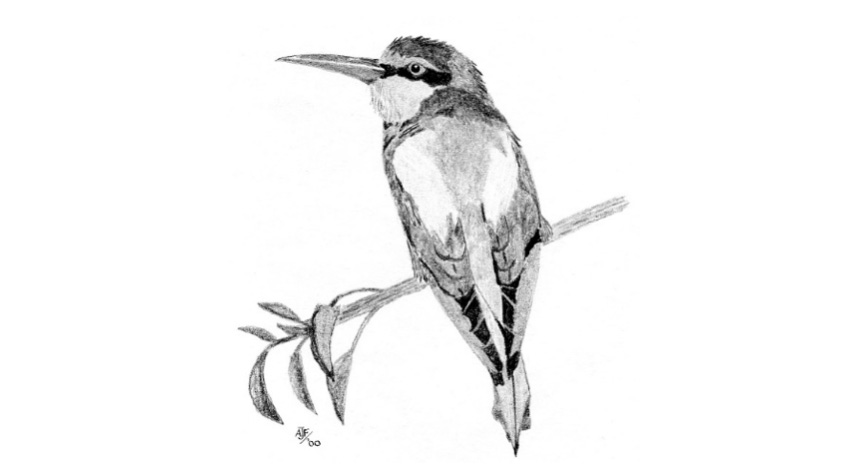
One, possibly two were seen on 29 June 1973. There are no further known details of this record, however at that time parties of up to seven had been seen in England and Wales between 10 and 28 June.
Mostly occasional autumn and winter visitors, which may have formerly bred.
Foster (1914) stated that they had been reported from near Stevenage. Around that, time they had been seen at the pond in Whitney Wood.
They are frequent autumn and winter visitors to Fairlands Valley Lakes, from where they were first recorded on 11 September 1974, with eight summer records of single birds on 2 June and, 7 July 2017, 29 July 2020, between 13 and 31 August 2021, 8 June 2022, 19 and 20 June 2022, between 28 July and 27 August 2022 (with two seen on 22 and 27 August) and 28 July 2025. A pair was seen on 9 November 2012, and a long staying female was seen between 20 September 2020 and 26 February 2021. The most recent record is of one on 12 October 2025.
Other records are:
The 1960s and 1970s: one at Astonbury House Pond from 22 to 29 February 1968; one seen leaving a hole at the back of Lower Pond, Astonbury on 6 and 8 August 1969 and, one feeding regularly there in September; one at Astonbury on 28 July 1970; one on the railings of the pond at the Town Centre Gardens on 24 and 26 October 1974; one at the Town Centre Gardens on 7 August 1975; one at Lanterns Lane, Aston End on 8 January 1977; one hunting Sticklebacks in the Stevenage Brook by Astonbury Wood on 24 September 1978; one at the, “lake”, Astonbury Wood on 16 October 1978; one hunting from the bridge over the pond behind Astonbury House on 4 March 1979; one at Box Wood on 27 August 1979.
The 1980s and 1990s: seen during July and August 1980 at Astonbury; Aston End September 1980; a pair during the 1982 breeding season along the River Beane at Aston; two at Astonbury Wood on 6 January 1985; one at Astonbury on 26 March 1989; one at Astonbury Wood on 15 and 16 July 1990; one at Bragbury End on 12 January 1991; one at Ridlins End on 18 September 1999.
Between 2000 and 2019: one at Goddard End on 22 January 2005; one between Stevenage, and Little Wymondley on 31 August 2007; one at Stevenge Brook, Berkeley Close on 20 December 2010; one at the Stevenage Brook, Ashdown Road on 12 January 2011; one at Stevenage Brook on 17 October 2011 and 20 January 2012; one at the Aston Brook, Goddard End on 29 December 2013; one at the River Beane, Aston End on 12 and 16 September and 29 December 2014; two at the River Beane, Aston End on 9 August 2015; one at the Aston Brook, Goddard End on 14 October 2016; one flying over Aston Allotments on 10 October 2017.
Since 2020: one at the Stevenage Brook by Astonbury Wood on 8 October 2022; one at Burleigh Close on 12 October 2022; one at the, “lake” Astonbury Wood on 8 September 2023.
The 1973 and 1992 Breeding Atlases considered breeding as probable from the tetrad covering Bragbury End and, the 1992 Atlas considered breeding as possible from the tetrad covering Aston. The 2012 Atlas did not consider breeding as possible.
The 2012 Winter Atlas confirmed their presence from the tetrads covering Pin Green and, Knebworth.
Rare passage migrant, mainly in the autumn and, former summer visitor.
Wrynecks were formerly common summer visitors to Britain but are now only uncommon autumn migrants. The cause of their decline, which began in 1900, and loss as a breeding species has not been established, loss of old pasture has been suggested.
In Hertfordshire they were common as a breeding species in the nineteenth century. Foster (1914) recorded that the Wryneck, “occurs regularly in all parts of the district as a summer visitor but appears to be less common than formerly”. By 1935 they were considered as scarce in the County, and Sage (1959) described them as, “local in extreme, if not extinct except as a migrant”. The last confirmed breeding in the County was at Ringshall near Little Gaddesdon in 1977. In July of that year an adult was also seen feeding a juvenile near Stevenage, which could also be considered as possible evidence of local breeding.
Other records for Stevenage are of one on 29 September 1968, one seen for 20 minutes in the garden of 42 Rockingham Way on 29 August 1970, one seen feeding on the ground at Bessemer Drive in September 1981 and, single birds at Norton Green Tip on 12 September 2005, from 2 to 5 September 2015, and, 7 and 8 September 2016.
The one spring record is of one in a Tates Way garden on 1 May 2011.
Fairly common resident.
In the nineteenth century Green Woodpeckers were uncommon as breeding birds in Hertfordshire. At that time, they were also persecuted by Game Keepers.
Foster (1914) recorded that they had been seen at Stevenage.
Not confirmed as breeding at Stevenage by the 1973 Breeding Atlas, they remained an uncommon Bird in North Hertfordshire until the late 1980’s.
The records for the 1960s and 1970s are: Heard at Astonbury 26 May 1966; seen in a Lodge Way Garden 22 December 1966; Astonbury Park 15 March 1967; heard Shephalbury Park 27 April 1967; Astonbury 8 April and 11 May 1968, January to May 1969; Watery Grove 17 April and 27 May 1971, 10 December 1972; Astonbury 31 March and 17 June 1973, 19 and 21 January, 11 May 1974; three Hertford Road Area 1974; Watery Grove 2 March 1976; Astonbury 1977, 1978, 1979; Watery Grove 1979; Box Wood 1979; Fairlands Valley 1979.
The only records for the 1980s came from Box Wood 1981, 11 May 1985, 12 and 19 April 1986.
During the 1990s they were recorded from: Ashtree Wood, Aston, Astonbury Wood, Aston End, Edmonds Drive, Fairlands Valley Lakes, Gresley Way, Monks Wood, Norton Green Tip, Watery Grove, Whomerley Wood, Wiltshire Spring.
Since 2000 they have been recorded from: Ashtree Wood, Aston, Astonbury Wood, Aston End, Bragbury End, Collenswood, Edmonds Drive, Fairlands Valley Lakes, Great Ashby Park, Gresley Way; High Broomin Wood, Monks Wood, Norton Green Tip; Pryors Wood, Ridlins Mire, Symonds Green, The Avenue, Watery Grove, Whomerley Wood, Wiltshire Spring.
The 1992 Breeding Atlas confirmed breeding from the tetrad covering Box Wood, the 2012 Atlas confirmed breeding from four tetrads (Boxbury Farm, Norton Green, Aston, Bragbury End).
Recently fledged young have been seen at: Aston 2024; Aston End 2020; Fairlands Valley 2015, 2017, 2018, 2019, 2022 and 2023; Norton Green Tip 2015, 2016, 2018 and 2020.
The 2012 Winter Atlas confirmed their presence from nine of the tetrads covering Stevenage.
The most seen together are five at Norton Green Tip on 27 September 2008.
At Watery Grove the Common Bird Census recorded one breeding territory being held in 1973, but did not record them again until 1991. From 1991 to 1999 their presence was recorded during the breeding season, with one breeding territory held in 1994 and 1999.
Common woodland resident.
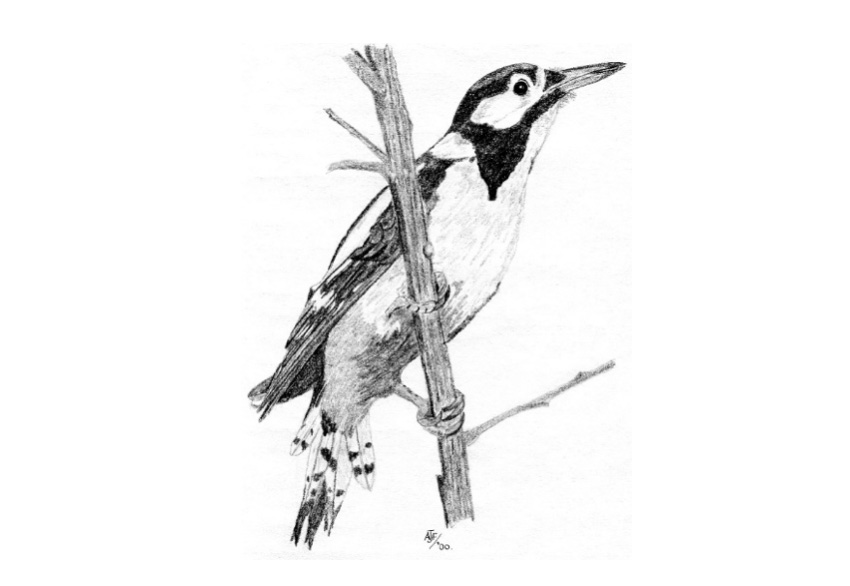
In the nineteenth century the Great Spotted Woodpecker was a rare breeding species in Hertfordshire. Foster (1914) described it as, “the scarcest of the Woodpeckers”, recording that they were found at Box Wood and Whitney Wood. The Stevenage Woodland Conservation Society recorded in 1969 that Great Spotted Woodpeckers did not nest in Whomerley Wood due to lack of nest sites. The increase noted since 1970 has been linked to woodland in Hertfordshire no longer being intensively managed and holding increased amounts of dead wood which suits it’s needs.
The increase in their numbers may be having an adverse, effect on other bird species, as they are known to predate nests of other species, particularly tits. There is also a known instance in the County where a nest of a Lesser Spotted Woodpecker (Dendrocopus minor) was predated.
Great Spotted Woodpeckers were confirmed as breeding in five of Stevenage’s tetrads in both the 1992 and 2012 Breeding Atlases, an increase from three in the 1973 Atlas.
Recent breeding activity: two nests found in Box Wood in 2020; confirmed breeding at Fairlands Valley Park in 2022. Recently fledged young seen at: Box Wood 2024; Chells Manor 2016; Aston Allotments 2018; Fairlands Park 2019; Norton Green 2019; Long Lane, Aston End 2020; Fairlands Valley Park 2023 and 2024; Astobury Wood 2024; An adult seen feeding a juvenile at Edmonds Drive in June 2024 and 2025.
The earliest, “drumming” was recoded at Fairlands Valley Park on 31 December 2021.
The 2012 Winter Atlas confirmed their presence from 10 of the tetrads covering Stevenage.
The most seen together are six at Astonbury Wood on 13 November 1983.
Three unusual records; in 1965 a Great Spotted Woodpecker’s nest box in Box Wood was taken over by Tree Sparrows (Passer montanus), one seen perched on a Dahlia Cane at Aston Allotments on 16 September 2011 and, one seen and heard drumming on a TV aerial on 21 April 2016
At Watery Grove the Common Bird Census recorded them holding breeding territories between 1978 and 1999, and they have probably bred there annually since 1980.
Five adults and a juvenile were ringed in Box Wood in 1979.
Scarce and declining residents.
The Lesser Spotted Woodpecker was an uncommon breeding bird in Hertfordshire during the nineteenth century. Foster (1914) claimed that they were fairly common in woods near Stevenage. Having declined by 83% between 1970 and 2015, their numbers nationally are now giving concern.
In the 1973 Breeding Atlas they were confirmed as breeding in two of Stevenage’s tetrads, probable breeding from seven tetrads in the 1992 Atlas and, only possible breeding from two tetrads in the 2012 Atlas.
They formerly bred at, Astonbury Wood (last recorded on 26 April 2010), Box Wood (last recorded on 11 May 1985) and, Watery Grove, where despite being recorded by the Common Bird Census as being present during the 1981, 1989, 1995, 1997 and 1999 breeding seasons, they have never been more than occasional visitors to the wood (last recorded on 3 February 2000). They have also been seen in Monks Wood (last record 9 April 2022), Parsonsgreen Wood, Great Ashby (one record 4 December 2014), Pryors Wood (last record 16 April 2013), Ridlins Wood (last record 17 April 1999) and, Whomerly Wood (last record 1975).
Away from the woodlands they have been seen at: Chells on 5 July 1970, 1972 (young birds being fed July) and 1974; Pin Green 1974; Aston End 1975; the Industrial Area 1980; Sish Lane 1981; male(s), “drumming” at Shephalbury Park 1988, one in the London Road between Brickdale House and Tesco’s Car Park in the springs of 1988 and 1989; one at Chesfield Park on 28 March 1989; one at Great Ashby on 16 November 2007; female in a Great Ashby Garden on 19 May 2020; one at Fairlands Valley Park on 18 March 2022.
The 2012 Winter Atlas confirmed their presence from the tetrad covering Norton Green.
The most recent record is of one at Monks Wood on 9 April 2022.
Uncommon breeding residents.
KestreIs were persecuted by gamekeepers in the nineteenth century until their chief diet of small mammals began to be appreciated, especially after the great vole plagues of the late nineteenth and early twentieth centuries, it was then generally left alone by ‘keepers, and numbers began to increase. One however was found on a Gamekeepers, “gibbet” in a spinney near Box Wood in 1965.
From the 1930’s there was an increase in urban breeding and this probably helped the species survive better the effects of Organochlorine Pesticides which caused another decline in their numbers in rural areas between 1959 and 1963. They were also affected by the bad winter of 1962/1963.
Foster (1914) described Kestrels as, “common near Stevenage, nesting in big woods”. Gladwin (1985) referred to there being 60 records for the Stevenage area in 1975 and 14 pairs in the 10 kilometre square (TL22) surrounding the town in 1978.
They were confirmed as breeding from three of Stevenage’s tetrads in both the 1973 and 1992 Breeding Atlases and, from two in the 2012 Atlas (the tetrads covering Pin Green and Aston.)
A pair was seen displaying over Aston Allotments on 13 April 2016 and recently fledged birds were seen at Aston End in 2024.
A, “nestling” ringed at Kimpton Mill on 7 June 2011 was found dead near Stevenage on 25 August 2011.
The 2012 Winter Atlas recorded their presence from nine of the tetrads covering Stevenage.
At Watery Grove their presence during the breeding season was recorded from 1977 onwards, with one breeding territory being held in 1979.
Some unusual records: two young birds were seen on the roof of Astonbury Manor House on 11 June 1978; a female roosted under the eaves of Astonbury Manor House during January and February 1979; a pair nested in a straw stack at Astonbury Farm in 1979 rearing three young; two seen roosting in one of Stevenage’s Tower Blocks in November and December 1981; two juvenile birds seen, “dust bathing” Dene Lane, Aston on 15 July 2008.
Very rare winter visitor and passage migrant.
Two records: one was trapped at Box Wood in March 1932 and, a male seen at Norton Green on 2 December 1993.
Passage migrant and summer visitor that has bred.
The Hobby had declined in Britain by the end of the nineteenth century mainly due to persecution by gamekeepers, egg collecting and the loss of suitable habitat. They are now increasing again in southern England.
Prior to 1967 when they began breeding again in Hertfordshire the last known instance of breeding in the county came from Box Wood in 1884. The Hertfordshire Natural History Society’s Bird Notes of 1896 recorded that Mr Frank Latchmore of Hitchin had Hobby eggs taken some years before from Stevenage. Foster (1914) reported that the Hobby was well known by a ‘keeper to visit a locality near Stevenage but, that it had not been seen for a few years. One was reported as being shot at Box Wood in February 1932, this however seems an unlikely date as generally they do not arrive in Britain until April or May.
Although a possible bird was seen passing high over Fishers Green on 8 August 1980, the first definite modern record of a Hobby at Stevenage also fittingly came from Box Wood on 19 September 1981, when one was seen mobbing a Buzzard (Buteo buteo).
Mostly single birds are recorded almost annually during spring and autumn migration. The earliest of the spring was seen on 21 March 2021 at an unrecorded location and, the latest of the autumn was seen on 22 September 2006 at an unrecorded location.
Summer records have come from: Astonbury Wood (15 August 2025); Chells (5 June 2021); Coreys Mill (16 June 2003); Derby Way (18 June 2010); Fairlands Valley Park (19 June 2017, 1 June 2022 and 2 June 2025); Jackdaw Close (12 July 2005); Lonsdale Road (13 July 1994); Railway Station (20 June 1990); Stanley Road (8 June and 21 July 2021); Tilekiln Wood area (12 July 2017).
Breeding was confirmed in 1982 when four birds, including two juveniles, were seen daily from 25 August. A pair was seen feeding a juvenile at Chesfield on 24 August 2025.
The 1973 Breeding Atlas confirmed breeding from the tetrad covering Broadwater and, Knebworth. The 1992 Atlas considered breeding as probable in two of Stevenage’s tetrads, and possible from one. The 2012 Atlas considered breeding as possible from the tetrad covering Norton Green.
Rare visitor and, uncommon resident.
Prior to 2008 when they began roosting at Southgate House (now known as Vista Tower) in the Town Centre, Peregrines were rare visitors, with two records: one seen flying north near Stevenage on 27 February 2000 and, one seen on 9 January 2007.
Between 19 September 2008, and 29 January 2009, an escaped juvenile bird, with a jess on one leg roosted regularly on the lettering on the north side of Southgate House in the Town Centre, favoring the letters, “E” and, “O” of, “Southgate”. In 2011 a bird was also seen to roost on the lettering of, “Southgate” from 23 February to 28 March. What appeared to be the same bird (with a tether on its left leg) was seen roosting on the letter, “E” of Southgate from 29 October to 23 November 2011. A male was also seen on the letter, “E” of Southgate on 24 October 2013 and, one was seen over St George’s Way and roosting on the lettering on 6 January 2014.
Between 19 May 2014 and 12 November 2015 birds roosted on the lettering and, roof of Southgate House until renovation works began on the building, with two seen together at intervals from 14 January to 9 May 2015 and, again on 30 October and 8 November 2015. One was seen flying nearby on 3 December 2015 and, one circled around the building on 14 December 2016. These birds may have indicated nesting somewhere in North Hertfordshire.
After Southgate House was renovated and renamed Vista Tower in 2017 and, the pronounced lettering on which the birds had roosted was removed, mostly single birds have been seen roosting on the roof and, on the lighting on the north side of the building with records from every month of the year. Two were seen mating there on 22 March 2025. The most recent record is one on 28 December 2025.
A bird ringed, VDT at Hemel Hempstead was seen at Vista Tower in March 2025. A juvenile seen there on 1 April 2025 had been ringed, VSR at St Mary’s Church, Andover as a chick on 24 May 2024.
Remains and feathers found beneath Vista Tower since November 2022 have indicated the following prey: Teal (Anas crecca), Quail (Coturnix coturnix), Little Grebe (Tachybaptus ruficollis), Water Rail (Rallus aquaticus), Moorhen (Gallinula chloropus), Oystercatcher (Haematopus ostralegus), Lapwing (Vanellus vanellus), Golden Plover (Pluvialis apricana), Ringed Plover (Charadrius hiaticula), Whimbrel (Numenius phaeopus), Bar-tailed Godwit (Limosa lapponica), Black-tailed Godwit (Limosa limosa), Turnstone (Arenaria interpres), Dunlin (Calidris alpina), Woodcock (Scolopax rusticola), Jack Snipe (Lymnocrytes minimus), Common Snipe (Gallinago gallinago), Common Sandpiper (Actitis hypoleucos), Redshank (Tringa tetanus), Black-headed Gull (Chroicocephalus ridibundus), Common Tern (Sterna hirundo), Feral Pigeon (Columba livia), Stock Dove (Columba oenas), Collared Dove (Steptopelia decaocto), Swift (Apus, apus), Great Spotted Woodpecker (Dendrocopus major), Magpie (Pica pica), Jackdaw (Corvus monedula), Skylark (Alauda arvensis), House Martin (Delichon urbicum), Swallow (Hirundo rustica), Starling (Sturnus vulgaris); Blackbird (Turdus merula), Fieldfare (Turdus pilaris), Redwing (Turdus iliacus), Song Thrush (Turdus philomelos), Mistle Thrush (Turdus viscivorus), House Sparrow (Passer domesticus), Greenfinch (Chloris chloris), Goldfinch (Carduelis carduelis), Reed Bunting (Emberiza schoeniclus).
They have also been seen roosting on the former Telephone Exchange in Bedwell where they were first recoded on 24 November 2017, when a male and female were seen. They were recorded there on six dates in 2018, on 2 January 2019, 4 November 2020, three dates during January 2021 and on four dates during September and October 2021, three dates in January and February 2023, on 9 November 2024, a pair on 12 March 2025, a juvenile on 20 April 2025, a juvenile female on 1 May 2025 and a 2nd calendar year female on 6 July 2025. A juvenile bird that had been ringed at Hemel Hempstead in 2021 was seen there plucking a Feral Pigeon on 3 May 2022. The latest record is of two on 11 December 2025.
The remains of a Shoveler (Anas clypeata) were found at the Telephone Exchange indicating a prey item.
Prior to 2020 other records are from: Argyle Way (one on 25 February 2015); Asda Supermarket (one on 20 November 2019); Chells Manor (one seen catching a Pigeon off Gresley Way on 5 October 2017); Fairlands Valley Lakes (single birds on 11 May 2010, 5 September 2018); Fishers Green (one on 1 August 2013); Glaxo Site (one near on 28 and 29 November 2012); Leisure Park (one over on 20 February 2017); Norton Green Tip (an adult on 27 December 2008, one on 31 August 2013, one hunting Pigeons in a field next to the Tip on 15 March 2015, one on 29 April 2018); Old Town (three over the A602 on 14 August 2019: Watery Grove (one on 4 April 2019); single birds at unrecorded locations on 3 April 2012 and 29 December 2016.
Since 2020 other records are from: Asda Supermarket (one on 19 January 2021 and two on 18 July 2023); Bedwell Crescent (one over on 22 November 2022 and one, possibly two over on 1 April 2025); Chells Manor (one flying over with a live Starling on 16 April 2022); Fairlands Valley Lakes (single birds on , 21 September 2020, 19 July 2021, 1 November 2021, 9 and 21 January 2022, 14 March 2022, 9 September 2022, 11 February 2023, 1 and 12 November 2023, 5 April 2024, 15 May 2024, 11 and 17 June 2024, 29 August 2024, 11 December 2024); Fairview Road (one flying over on 17 February 2025); Glaxo Site (one on 3 May 2022); Great Ashby (one circling towards on 19 August 2021); Hampson Park (one on 3 April 2023); Martins Wood (one over on 15 April 2020); Norton Green Tip (one on 21 March 2020); St George’s Way (one flying over on 28 January 2025); Stanley Road (single birds over on 26 June 2020, 11 July 2021 and 20 May 2025); a Stevenage Garden (single birds over on 27 January and 5 February 2021 and 22 November 2021); Swingate (birds seen perched on cranes during re-development on 27 and 28 September 2025); The Lytton Apartments, Lytton Way (one on 13 and 29 November 2025, two on 2 December 2025); Town Centre Gardens (one on19 November 2021); Weston Road Cemetery (two over April 2020); one at an unrecorded location on 25 October 2022.
Local breeding was confirmed in 2017, 2019, 2020, 2022, 2023 and 2024 at Little Wymondley.
One was seen in Popple Way on 5 and 6 July 1975, and one was seen at Aston on 19 February 1995.
[ thought or known species of introduced or captive origin ]
Increasing visitor which may have bred.
The Ring necked Parakeet is a native of Africa and the Indian sub-continent, and was introduced to Britain as a cage bird. As a result of escapes from captivity and deliberate releases large free flying colonies now exist in south east England and, large flocks are increasingly seen in Hertfordshire.
The earliest record is of one at Bragbury End from 10 to 14 March 1974 (this was the first record of this species for Hertfordshire), they were not recorded again until one was seen at an unrecorded location on 16 February 2001.
Between 2001 and 2010, there were three records: one at Fairlands Valley Lakes on 25 and 27 October 2003; one at an unrecorded location on 30 December 2003; one at the Golf Course, Aston on 23 February 2008.
Between 2010 and 2019 they were recorded at: Chells Manor (five flying over on 28 October 2012, two on 4 December 2015, six in a garden on 13 November 2019); Fairlands Valley Lakes (one on 24 August 2016, one on 18 February 2018, one on 27 February 2019, two on 29 December 2019); Fairview Road (one heard and seen on 20 May and 17 September 2014); Jackdaw Close (31 March 2014); King George V Playing Fields (two on 2 November 2017); Martins Way (one on 26 March 2018); Norton Green (one heard on 29 October 2011); Roebuck Hotel (eight flying over on 3 December 2016); St Nicholas (one in a garden on 25 May 2018).
Since 2020 sightings have increased significantly with records (and maximum numbers) from: Ashtree Wood (15+ on 19 February 2022); Aston (c. 25 on 12 November 2024); Aston Allotments (four on 6 December 2021); Aston Lane, Aston (four on 24 May 2021); Astonbury Lane: (two on 28 November 2020); Astonbury Manor (two on 3 April 2020); Astonbury Wood (12 on 3 September 2024); Blackberry Mead (10 on 27 June 2022); Bragbury End (c.10 on 31 January 2024); Chells Manor (11 on 13 December 2021); Clark’s Farm, Aston End (three on 2 January 2022); Drakes Drive (one on 4 March 2020, one on 13 August 2021); Edmonds Drive (20 on 10 July 2025); Fairlands Valley Lakes (23 on 19 August 2024); Glebe Shops, Chells (eight flying over on 16 January 2020); Great Ashby (seven on 19 October 2025); Gresley Way (three on 10 January 2022); Holders Lane, Aston End (two on 22 April 2021); Jackdaw Close: 13 on 7 December 2022); Minsden Road (five on 18 December 2022); Mobbsbury Way (one on 16 July 2021); Mobbsbury Wood (10+ on 9 February 2022); Pin Green (seven on 27 September 2023); Tatlers Lane, Aston End (two on 28 May 2023); Weston Road Cemetery (two on 17 August 2021); Watton Road, Bragbury End (32 on 31 January 2023).
The most seen together is the 32 at Watton Road, Bragbury End on 31 January 2023.
In 2018 local breeding was suspected when a young bird was seen.
One unusual record, six were seen mobbing a Sparrowhawk (Accipiter nisus) at the White Way on 12 January 2023.
One spent the afternoon in a dead Elm Tree in Fairview Road in July 1975, and was thought to have escaped from the Bird Gardens that existed at that time at Knebworth House.
[ thought or known species of introduced or captive origin ]
Very rare passage migrant.
A male was accidentally shot by a Mr Wilcox at Box Wood on 6 May 1955 whilst Pigeon shooting.
Former summer visitor.
Once common summer visitors to the south and east of England Red- Backed Shrikes are now extinct as breeding birds in Britain. They have been in a long decline since the nineteenth century, which has accelerated since the 1940s. Although the reasons for the decline are not fully understood, the loss of mixed farms with small fields and large hedges, and the heavy use of insecticides are believed to be the major causes.
Prior to 1916 they were characteristic birds of most parts of Hertfordshire. Foster (1914) described them as, “common near Stevenage”. In Hine (1934) Foster recorded that the Red-Backed Shrike was, “a common object on the telephone wires bordering the Great North Road between Stevenage and Biggleswade”. He also recorded that Doctor C. Grosvenor had reported that they regularly nested within half a mile of Stevenage High Street.
By the following year, 1935, they were declining in Hertfordshire, and despite being described by Sage in 1959 as being “fairly common”, the decline continued. The last suspected breeding in the County was at Oughton Head, Hitchin in 1974.
Very rare winter visitor.
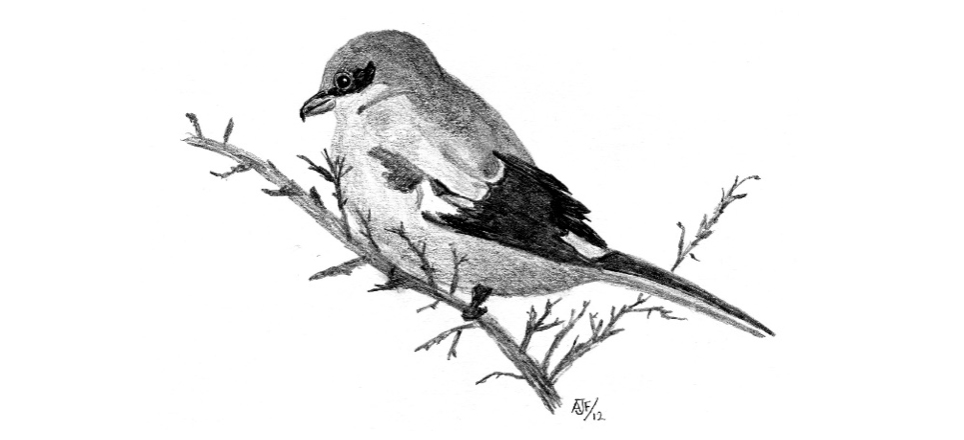
Two records, one was at Norton Green Tip from 2 to 19 January 2012 and, one was seen between Stevenage and, Walkern at Jack Pallett’s Spring on 22 and 23 October 2016.
Abundant resident.
Magpies are successful birds, which have survived differing Human attitudes towards them. In the nineteenth century they were persecuted by gamekeepers, farmers and gardeners, because of, superstition, and their reputation for raiding the nests of other bird species, and destroying their eggs and young.
The reduction of Magpie numbers in Britain by the end of the nineteenth century was so severe that some writers of the time were contemplating its extinction in some areas. Described as “extinct” around Hitchin in 1877, A. F. Crossman wrote in 1902 that Magpies were, “a thing of the past in most parts of Hertfordshire.” In 1908 they were also said to be rare at Stevenage.
Magpies began increasing again in southern and eastern England in the 1930s, and during the 1940s the increase was considerable, at this time there was also an expansion of birds from the countryside into the towns. Between 1967 and 1999 they increased by 107%.
Although the increase in Hertfordshire had begun after the First World War, Sage (1959) described Magpies as, “still rather scarce at Stevenage”. The first modern records for Stevenage are, two at Box Wood on 16 October 1965, a pair nest building in Ashdown Road in February and March 1966, single birds at, Chesfield Manor, Box Wood, Hertford Road, Newgate and three at Astonbury Wood in 1967, and a pair at Astonbury Wood on 23 February 1969.
Whilst the 1973 Breeding Atlas confirmed breeding from the tetrads covering Aston, Knebworth and Bragbury End in 1973 they were considered uncommon, with only one pair being seen that year in Fairlands Valley near Monks Wood. Further pairs were recorded in the 1970s at Astonbury (where they bred in 1976 and 1977), Box Wood, Collenswood School, and Watery Grove. In 1980 no nesting was recorded at Stevenage. Since then, they have increased dramatically and are today very common residents of Stevenage.
The 1992 Breeding Atlas confirmed breeding from every tetrad covering Stevenage, the 2012 Atlas from eight.
11 nests were found in Fairlands Valley Park in 2021 and eight in 2022.
The Common Bird Census at Watery Grove did not record them during the breeding season until 1985, when a single territory was held. From then until 1999 they have annually held one or two breeding territories, with the exception of 1986, 1988 and 1996 when only their presence was recorded.
The 2012 Winter Atlas confirmed their presence from all 11 of the tetrads covering Stevenage.
The following large flocks have been recorded: 41 birds in Fairlands Valley on 12 January 2002, 36 at an unrecorded location in 2011, 64 at a roost site at Warren Spring Laboratory on 21 February 2015, 51 birds in Fairlands Valley on 6 October 2019, 40 birds in Fairlands Valley Park on 19 January 2021 and 48 at Fairlands Farmhouse on 30 December 2022.
Resident and winter visitor in small numbers.
In the nineteenth century Jays were persecuted by, gamekeepers and farmers. They were also shot for their feathers, which were used in the fashion industry, and the blue feathers of their wing coverts used as fishing flies. On 21 February 1968 nine were shot in the Knebworth House Estate and adjoining woods during a shoot to reduce Muntjac Deer (Muntiacus reevesi), and in 1979 some were found on a Gamekeepers’ gibbet by Astonbury.
Uncommon as breeding birds in Hertfordshire during the nineteenth century, Foster (1914) described them as, “common in woods near Stevenage”.
The 1973 Breeding Atlas confirmed breeding from four of Stevenage’s tetrads, the 1992 Atlas from five but, from none by the 2012 Atlas.
The Common Bird Census at Watery Grove recorded them annually between 1972 and 1999 as either being present during the breeding season or holding single territories with, the exception of 1996 when two territories were held.
Breeding was confirmed from Astonbury Wood in 2024.
The 2012 Winter Atlas confirmed their presence from all 11 of the tetrads covering Stevenage.
Jays are prone to occasional irruptions, which may be linked to the failure of the Acorn crop either in Britain or on the continent. In 1882 there was a large immigration of Jays into Hertfordshire. 100 years later in the autumn of 1983 during a notable irruption of Jays into southern Britain the highest count in Hertfordshire was the 40 to 50 flying south over Stevenage on the morning of 4 October.
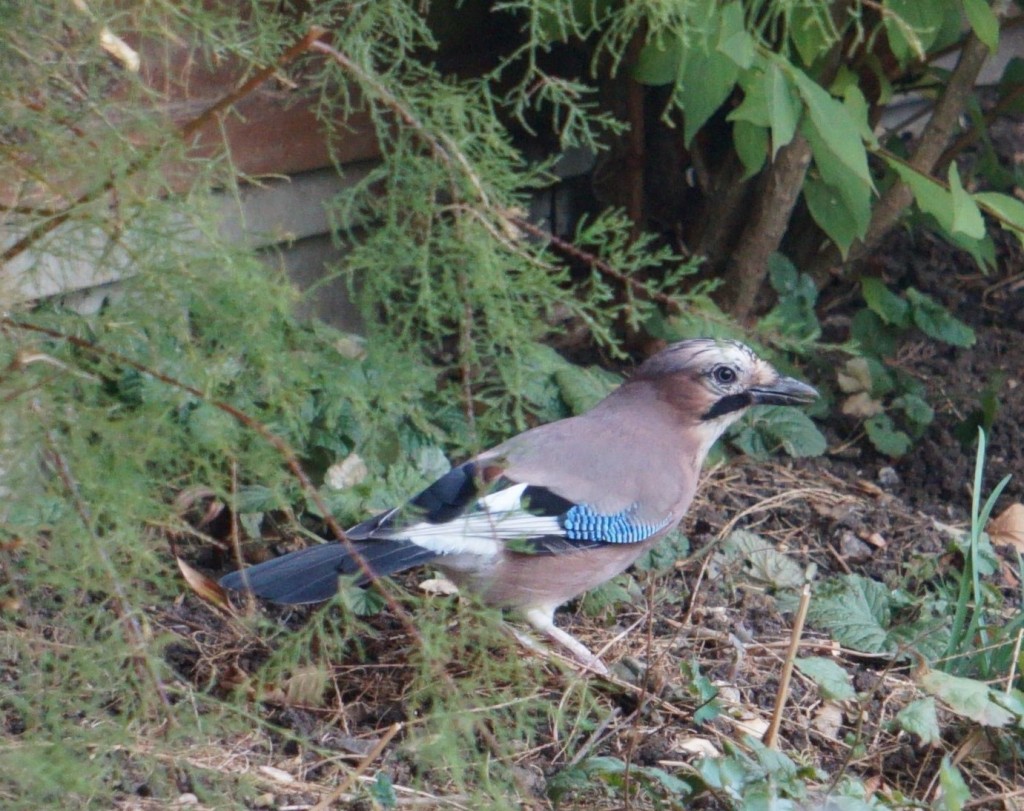
Jackdaw Close October 2018
Fairly common residents.
Jackdaws suffered less persecution than other members of the Crow family during the nineteenth century and, were at that time considered common as breeding birds in Hertfordshire.
Large numbers of Jackdaws, Rooks and Carrion Crows gather and roost in Fairlands Valley in the evenings. The largest flocks of Jackdaws seen there are 950 on 6 February 2017 and 1000 on 9 December 2023. 1000 were also seen at the adjoining Monks Wood on 29 November 2024.
A flock of 65 was seen at Chells on 3 December 1972 and, 320 were at an unrecorded location on 25 February 2015.
The 1973 Breeding Atlas confirmed breeding from eight of Stevenage’s tetrads, the 1992 Atlas from 10 and, the 2012 Atlas from four.
The Common Bird Census at Watery Grove recorded them as holding two territories in the 1990 breeding season, and as being present in the 1993 and 1998 seasons.
Young birds were seen at Astonbury Wood in 2024 indicating breeding in the wood.
A bird with a coloured ring B6A that was ringed at Benington on 11 June 2021 as at least two years old was seen in an Edmonds Drive Garden on 10 June 2025.
The 2012 Winter Atlas confirmed their presence from all 11 of the tetrads covering Stevenage.
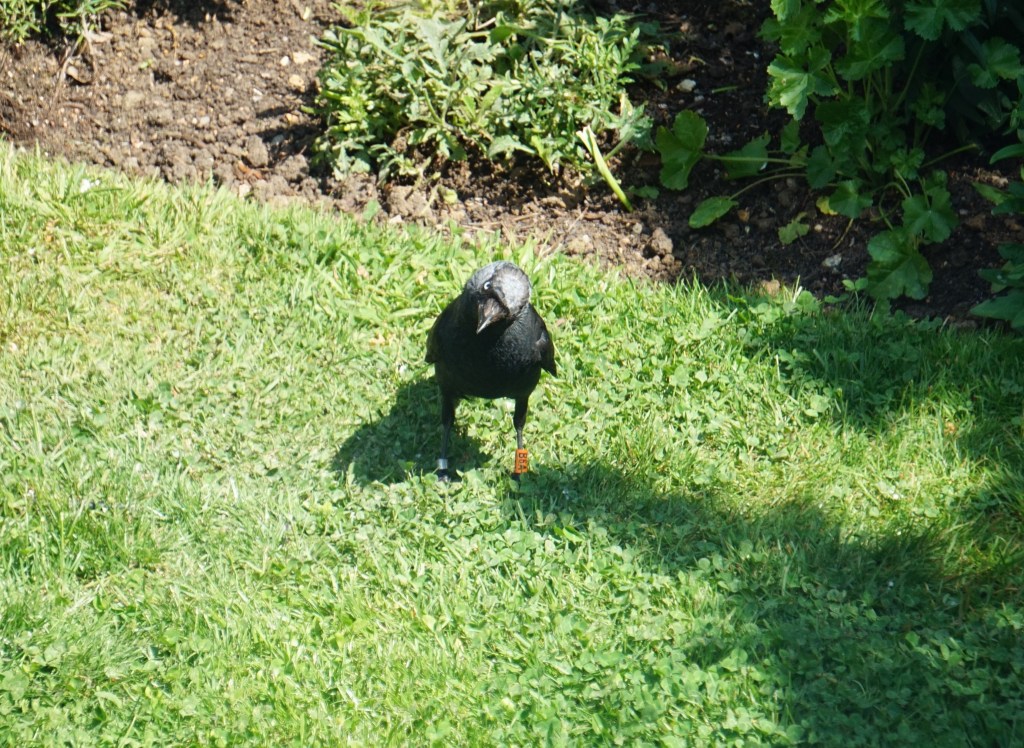
Ringed bird B6A
Fairly common resident with former rookeries recently being re-established.
Although Rooks consume great quantities of agricultural pests, they have always been regarded as pests especially on newly sown or ripening cereal crops, and for this reason have been “scared off” and where possible killed.
Rooks expanded their range in Britain during the eighteenth and early nineteenth Centuries, and their numbers were still increasing until around 1960 when there was a sudden sharp decrease due to the use of toxic chemicals in seed dressings.
Despite the loss of agricultural land as Stevenage developed rookeries have continued to exist within the town and surrounding countryside. Some are large and well-established others are small and may only exist for a short time.
In 1960/61 there were eight rookeries in Stevenage.
In 1971 rookeries were recorded at: Aston (Stringers Lane), Aston End (Lord’s Farm and New Wood), the Avenue, Bragbury End (three sites, one east of the Railway, one beside the A602 and one opposite the Chequers Pub), Chells (Six Acre Wood), Chesfield (Harbourclose Wood at Manor Farm, two sites), Frobisher Drive, Marymead, Monkswood Way (in the grounds of the former college, now Asda), Rectory Lane, the Town Centre (Swingate Car Park and behind the Towers). The largest rookeries were at the Avenue (90 nests) and Rectory Lane (59 nests).
In 1975 17 rookeries were recorded in Stevenage and 10 in 1993. In the surveys of rookeries from 1975 and 1993 three were present in the same locations, Round Wood, Chesfield, Manor Farm, Chesfield and, Roebuck Vets.
The large rookeries in the Avenue and at Rectory Lane had gone by 1975 but, were being re-established in 2005.
In 2013, 34 nests were recorded from a rookery at Warren Springs Laboratory on 21 February.
Since 2014 rookeries have been recorded (with active years) at: Ashburnham Walk (two sites 2016 to 2022); the Avenue, Martins Way (2014 to 2022), Bragbury End (2014 to 2022); Broadhall Way, near Greenside School (2015); Broadwater Crescent/Nokeside (2014) Broadwater Road (2014 to 2018); Claypit Hill Spring (2021); Fairlands Valley Park, north end (2015); Fairlands Way/Grace Way (2015, 2018, 2019); Farnham House, Gunnels Wood Road (2019); Fishers Green Road/Lymington Road (2014 and 2021); Fishers Green adjoining the A1M (2015); Grace Way (2019); Gresley Way (2014 to 2016); Hampson Park, adjoining Meredith Road (2015); Hampson Park (2015 to 2017); Holders, Aston End (2014 to 2022); Kimbolton Crescent (2022); Ledgefield Plantation, Chesfield (2014 to 2018); the Leisure Park (2022), Long Leaves (2021 and 2022); Manor Farm, Chesfield (2014, 2016, 2017); Moss Bury School (2015); New Wood, Aston End (2014 to 2022); Roebuck Retail Park, north (2014 and 2015); Roebuck Vets, Roebuck Gate (2018 to 2022); Round Wood, Chesfield (2014 to 2018); Sishes Wood (2016 and 2022); Stevenage Golf Course (2014 to 2021); Tesco Roundabout, Lytton Way (2020 to 2022); Vardon Road/Hobbs Court (2014); Vardon Road (2020 to 2022).
The largest number of nests recorded in a rookery is 53 at New Wood, Aston End in 2021.
In 1974 the following large flocks were recorded at Stevenage; 200 along the Hertford Road on 23 March, 91 in fields at Botany Bay on 26 May, 200 going to roost at Round Wood, Chesfield on 20 October, 50 in Elms (Ulmus procera) at Astonbury Wood on 17 November and 70 to 80 at Broaches Wood on 30 December.
A mixed flock of 2000 Rooks and Jackdaws was recorded from Stevenage on 8 November 1987 and, a flock of 150 was recorded at Stevenage on 10 January 2014. Large numbers of Rooks, Jackdaws, and Carrion Crows also gather and roost in Fairlands Valley in the evenings.
Three unusual records: A, “mottled” Rook (where some or all the feathers of the wings, tail or body have terminal or sub-terminal greyish white wing bars) was seen at the Old Town between January and April 1967; Rooks seen feeding on discarded Crisps at Fairlands School Playground in 1973 and 1974; Rooks seen feeding on ornamental Cherry Trees in Popple Way in 1974.
The 1973 Breeding Atlas confirmed breeding from nine of Stevenage’s tetrads, the 1992 Atlas from six and the 2012 Atlas from 10.
The 2012 Winter Atlas confirmed their presence from all 11 of the tetrads covering Stevenage.
Common resident.
Despite its familiarity today, the Carrion Crow was in the past so heavily persecuted that at one time it was considered as a rare bird in Hertfordshire. No bird was more hated by Gamekeepers and Landowners than the Crow, and in the late eighteenth and early nineteenth Centuries attempts were made to wipe it out, it was systematically poisoned, trapped and shot, without success. Its numbers began to increase during the First World War and there was a dramatic rise in its numbers after the Second World War. Today they are found in all types of open country including woodland and urban areas with trees.
Foster (1914) recorded that the Carrion Crow was, “rare in the district. It is more frequently seen in winter, especially near the bigger woods, and is almost invariably noticed in pairs. Occasionally seen hanging up in keepers’ larders. Not known to nest. Near Stevenage occasionally”. One was seen at Stevenage on 19 November 1907. Sage (1959) recorded that they were scarce at Stevenage. An unsuccessful breeding attempt was made in Monkswood in 1969 and, they remained uncommon at Stevenage until around 1978.
A large flock of 130 birds (believed to be non-breeding birds) were seen on a Stevenage School Playing Field on 19 May 2010. Large numbers of Carrion Crows, Jackdaws and, Rooks also gather and roost in Fairlands Valley in the evenings. A post breeding flock of 40 juveniles was seen in Fairlands Valley I May 2012. A flock of 63 was also recorded from Stevenage on 3 September 2013.
Breeding was confirmed from four of Stevenage’s tetrads in the 1973 Breeding Atlas, from 11 in the 1992 Atlas and, from eight in the 2012 Atlas.
Five nests were found in Fairlands Valley Park in 2020 and nine in 2021 and 2022.
They have successfully colonised the town and, are commonly found in all areas. They perform a useful service by scavenging discarded fast food and other refuse.
The 2012 Winter Atlas confirmed their presence from all 11 of the tetrads covering Stevenage.
At Watery Grove they were not recorded by, the Common Bird Census until 1977 when their presence was noted during the breeding season. In 1978 a single territory was held. They were not recorded again by the census until 1984 when a single territory was again held. Two territories were held in 1985, a single territory in 1987, and their presence noted in the 1986 and 1988 breeding seasons. From 1990 to 1996 single territories were held annually, and in 1997 and 1999 two territories were held, and three were held in 1998.
A former uncommon winter visitor.
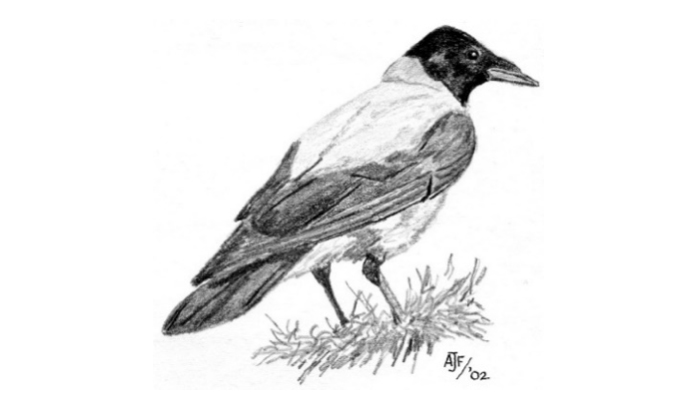
In former times Hooded Crows were common visitors to Hertfordshire, particularly to the Royston area, from where they got their local name, “Royston Crow”. Today they are rarely seen in the County, it is believed that this is because, the northern and eastern European breeding population is becoming resident, and is no longer migratory in winter. Haywood (1947) claimed their numbers in the County, greatly decreased after about 1911.
Foster (1914) recorded that they were seen occasionally in the Stevenage district. Five were seen near Stevenage on 15 February 1907.
An increasing visitor.
Ravens are gradually re-colonising Hertfordshire. Having previously bred in the County it was, in common with other parts of England, driven to extinction by Gamekeepers, Farmers and, collectors of their skins, eggs and, young for pets. Prior to 2006, when they bred again in the County, the last known breeding in Hertfordshire was at Brocket Hall near Welwyn in 1846. They are now increasingly being seen flying over Stevenage.
The first record for Stevenage is of one over Watery Grove on 28 March 2010
Other records prior to 2020 are: one at Norton Green Tip on 27 August 2010; one flying over Whomerley Wood on 14 October 2013; one at Norton Green Tip on 10 November 2014; four at an unrecorded location on 5 January 2015; two at Chesfield Park on 4 July and, 22 September 2016; one at Norton Green Tip on 9 September 2016; one flying low over Chancellor’s Road on 26 October 2016; two on Pylons near Granby Road on 18 January 2017; a pair in flight at Chesfield on 8 April 2017; one flying over Aston on 11 April 2017; three flying low towards Watery Grove on 15 August 2017; one, “calling over Broadwater on 29 September 2017; one at Chesfield on 22 December 2017; Two at Norton Green on 30 January 2018; one at Norton Green Tip on 28 April 2018; a family party of five calling over Chells Manor on 27 August 2018; one circling high over Fairlands Valley Park on 30 August 2018; One over Fairlands Valley Lakes on 13 September 2018; one flying north near Fishers Green on 13 November 2018; one at, “Majors Wood”, Aston End on 12 December 2018; two in, “display” flight over Fishers Green on 17 February 2019.
Since 2020 they have been recorded from: A1 (M) (two over Junction 8 on 31 October 2020, one over Junction 8 on 5 February 2021); Aston (one over on 24 November 2020, one over one over a Garden on 21 October 2024); Astonbury Wood (two over on 16 January 2024); Aston End (one on 10 July 2021, one on 28 January 2024); Box Wood (one seen carrying a large chick over on 8 July 2021); Broadwater (two over on 9 October 2025); Chells (one over on 5 September and 5 October 2020); Chells Manor (two over on 25 July 2021, four flying west towards on 26 December 2022, one over on 27 August 2023); Edmonds Drive (one over on 16 December 2025); Fairlands Valley Lakes (one over on 25 September 2022, two over on 12 December 2022, one over on 9 February 2023, four over on 5 October 2023; one over on 19 and 29 November 2023, one over on 25 January 2024, one over on 19 February 2024, two over on 27 February 2024, one over on 2 April 2024, one over on 16 December 2024, one over on 1 August 2025, one over on 1 September 2025, one over on 2 December 2025); Great Ashby (one over a Garden on 21 October 2024); (Gresley Way (two over on 21 December 2022); High Broomin Wood (one on 17 February 2024); Highcroft Tower, Roebuck (five flying over and feeding on the roof on 4 November 2025); Mobbsbury Wood (one on 13 February 2025); Shephall (one on 14 March 2025); Stevenage Garden Centre (one on a pylon nearby on 10 November 2023); Town Centre (one over on 10 December 2025); Watery Grove (one over on 11 September 2020, two over on 19 November 2022); Weston Road Cemetery (one over on 17 September 2020, one over on 15 September 2021, four over on 19 February 2024); one over a Stevenage garden on 31 August 2020.
Common resident and winter visitor.
Goldcrests are found in Stevenage’s woods, and during their autumn and winter movements can also be found in hedges, parkland, and gardens (six were seen in a Ferrier Road Garden on 1 January 1980 and three were seen bathing together in a Stevenage Garden pond in 2007). In Hertfordshire, the small flocks that appear in autumn away from the woodlands are due to movements of relatively local, mainly juvenile birds, as opposed to migrants from the continent.
A first winter male ringed near the Hoo, Kimpton on 11 October 2007 was found dead near Box Wood on 23 October 2007. In 1979 eight were ringed in Box Wood.
On 25 August 1982 a party of 25 were seen at Pin Green.
Being insectivorous, they are susceptible to cold weather and their population fluctuates with severe winters. The “great frost” of the 1916/17 winter for example reduced their numbers in Hertfordshire, and there was a sudden decline in their numbers due to severe weather in the winter of 1986.
The 2012 Winter Atlas confirmed their presence from 10 of the tetrads covering Stevenage.
The 1973 Breeding Atlas confirmed breeding from three of Stevenage’s tetrads, 1992 Atlas from eight and, the 2012 Atlas from one.
Breeding was confirmed at the former Warren Spring Laboratory on 22 April 2013 and fledged young recorded at Watery Grove 2015 and Chells Manor in 2017. Breeding was also confirmed from Fairlands Valley Park in 2018, 2023 and 2024.
The Common Bird Census at Watery Grove recorded their presence during the 1976, 1989, 1994 and 1996 Breeding Seasons.
Rare passage migrant, and winter visitor.
Birds have been seen at Stevenage during the spring, autumn and, winter.
The spring records are: single birds at Watery Grove on 8 April 1975 and, 5 April 1981; a male singing and holding territory at Mossbury Wood, Chells from 26 to 31 March 1989; a probable sighting of one in the Meadway – Gunnels Wood Road area on 18 March 1997; a male, visiting a bird bath, in a garden for 10 days in March 2008; a male at Wiltshire Spring from 24 to 27 March 2019; a male at Shackleton Spring on 27 April 2019; one at Box Wood on 6 March 2020; one at Watery Grove on 18 and 19 March 2023; one at Hanging Hill Wood, Chells on 29 April 2023.
Four autumn records: one at Ashburnham Walk on 31 October 2009, a probable bird at Tilekiln Wood, Great Ashby on 29 November 2015, one at Chells Manor on 3 October 2018 and one at Sishes Wood on 18 September 2024.
The winter records are; a single bird at Astonbury Wood on 9 February 1986, and a male at Pryors Wood from 28 January to 15 February 2010.
Abundant resident.
Although birds of open woodland, they have adapted well to the suburban environment, using gardens for feeding and, breeding where nest boxes are provided.
As with other Tit species they form flocks in the winter, one such flock seen at Norton Green in 1992 numbered fifty Great and Blue Tits. 37 were also counted in an Oak Tree in Wellfield Wood on 10 November 1974.
They were confirmed as breeding in every tetrad covering Stevenage in the 1973 and 1992 Breeding Atlases and, from ten in the 2012 Atlas.
An unusual nesting record is of a nest with young at the Stevenage Borough Council Depot canteen in 1981 where a knot had fallen out of a plank.
The 2012 Winter Atlas confirmed their presence from all 11 of the tetrads covering Stevenage.
The Common Bird Census at Watery Grove recorded them annually as holding between three and thirteen breeding territories between 1972 and 1999. As they were associated with the, “standard” Oaks in the wood rather than the coppiced Hornbeams, coppicing seemed to have little effect on their variable population.
A nestling ringed at Box Wood on 28 May 1980 was killed by flying into a window at Saffron Walden, Essex on 31 August 1980. 167 were ringed in Box Wood in 1980 and 267 were ringed in Box Wood in 1981.
Abundant resident.
Great Tits are birds of deciduous woodland. In more recent times they have spread widely from the woods into farmland, parkland and gardens. Their numbers fluctuate and they are vulnerable in severe winters. They were confirmed as breeding in every tetrad covering Stevenage in all three Breeding Atlases.
The 2012 Winter Atlas confirmed their presence from all 11 of the tetrads covering Stevenage.
The Common Bird Census at Watery Grove recorded them annually as holding between two and ten breeding territories. They are also associated with the Oaks in the wood, and their population was unaffected by coppicing.
Great Tits are known for nesting in unusual places, in 1977 a pair raised a brood at Astonbury in a concrete garden gnome, the shoulder of which was broken off and the nest and young were visible inside. In 1989 a pair nested inside one of the posts supporting the Windsor Close road sign.
96 were ringed in Box Wood in 1980.
A flock of 34 was seen at an unrecorded location on 2 November 2024.
Uncommon resident and winter visitor.
Coal Tits are vulnerable to cold weather, and were badly affected in Hertfordshire during the winter of 1978/79.
They were confirmed as breeding in two of the town’s tetrads in the 1973 Breeding Atlas, from seven in the 1992 Atlas and, from five in the 2012 Atlas.
A bird was seen collecting nesting material in the Old Town in 2016 and, fledglings were reported from central Stevenage in 2018 and, at Fairlands Valley Park in 2019, with breeding confirmed there in 2021 and fledglings seen in 2022 and 2023.
The 2012 Winter Atlas confirmed their presence from 10 of the tetrads covering Stevenage.
The Common Bird Census recorded their presence annually during the breeding season at Watery Grove between 1973 and 1979, with single territories being held in 1973 and 1979. The Census did not record them again until 1985 from when they annually held between one and two territories until 1998, with the exception of 1986, 1988, 1990, and 1997 when only their presence was recorded.
A juvenile ringed at Box Wood in 1971 was seen nest building in the wood on 22 April 1972. 31 birds were ringed at Box Wood in 1979.
Former resident.
Willow Tits were not recorded from North Hertfordshire until around 1937, and were considered scarce in this part of the County by Gladwin (1985).
Having reached a peak nationally in the 1970s, they have declined dramatically. A decline of 72% was estimated between 1994 and 2002. The causes of the decline are unknown, but competition for nest holes with Blue and Great Tits, predation of their nests by Greater Spotted Woodpeckers (Dendrocopos major), the drying out of preferred woodlands, and climate change have been suggested. Willow Tits are sedentary by nature and may be reluctant or unable to move to other suitable sites.
Confirmed as breeding in four of Stevenage tetrads by both the 1973 and 1992 Breeding Atlases. They were considered to be common in the area in 1980, and were, thought to have been badly affected by the harsh winter of 1991. They are now probably extinct at Stevenage, having not been seen since 2004.
The records for the 1960s and 1970s are: pair nesting in Whomerly Wood 14 May 1967; Monks Wood/Whomerly Wood in the winter of 1969/1970; eight at Watery Grove 28 March 1971; nest with young in a Birch Tree, Box Wood 4 June 1971; seen excavating a nest site, Box Wood 21 April 1973; two pairs Astonbury Wood 1973 (one pair had well grown young in a nest box 9 June 1973); breeding Astonbury Wood 1974 and1975; breeding Broaches Wood 1974; breeding Watery Grove 1975; four Watery Grove 6 June 1976; breeding Astonbury Wood 1977 (nest found in the bottom of an Ash Tree which contained newly hatched young 29 May 1977); display noted Watery Grove 1977, 11 ringed, Box Wood 1978; Astonbury Wood 1978 (pair seen with nesting material on 23 April 1978); three ringed Box Wood 1979; Astonbury Wood 13 April 1979.
The records for the 1980s and 1990s are: Watery Grove 1980; Astonbury Wood 14 and 23 April 1980; records from five sites around Stevenage 1981; seven ringed in Box Wood 1981; two Astonbury Wood 23 March 1986 and one on 13 Aril 1986; one at Mossbury Wood 27 March 1987; one at Astonbury Wood 15 April 1987; pair Box Wood 1April 1988; pair with the male bird in song Watery Grove 19 and 20 April 1988; pair Norton Green 30 March 1989; two at Astonbury Wood 16 July 1990 and 13 January 1992; one at Astonbury Wood 29 February and 8 March 1992; two Watery Grove 30 January 1994; Whomerly Wood 2 April 1996, 10 February and 7 April 1999.
The final record for Stevenage was of one feeding on a patch of Slender Thistles at Astonbury Wood on 4 December 2004.
At Watery Grove they were present in the 1970s when both nest boxes and bored-out natural holes were inhabited. The Common Bird Census recorded their presence in the 1973, 1974, 1981, 1985, 1987, 1990, 1991 and 1997 breeding seasons, and as holding single territories in 1992, 1993, 1996 and 1998.
Scarce and declining resident.
In common with the rest of the Britain, Marsh Tits are scarce and declining residents of Stevenage’s woods. The suggested reason for their decline is increased nest predation, competition with other Tit species, and subtle changes in woodland habitat. They are thought to favour woodlands with complex understory and, require large patches of suitable habitat to breed successfully.
Foster (1916) commented, “Stevenage district, but not so common as the Coal Tit (Periparus ater).”
The next record came from Box Wood on 22 August 1957.
There are no records from the 1960s apart from Monks Wood/Whomerly Wood in the winter of 1969/1970. In Hertfordshire generally at this time Marsh Tits and Willow Tits (Parus montanus) were being considered in the Bird Reports together, possibly because of difficulties in identifying the species separately!
The records from 1970 to 1999 are: Astonbury 1971 and 1979; Box Wood 1971, 1972, 1973, and 1974; Watery Grove 1971; Fairlands Valley 1973, 1975; Watery Grove 1973 and 1975; Ely Close 1973; Hertford Road 1974; Wellfield Wood 1974; a family party of eight at Watery Grove in mid-June 1977; Box Wood two birds ringed 1978 and 1979; Astonbury Wood 26 November 1978; Watery Grove 1978,1979, 1980; Astonbury Wood 23 March 1980; three birds ringed in Box Wood 1981; two at Watery Grove 15 April 1982; two at Watery Grove 14 April 1983; one at Box Wood 18 May 1984; three at Astonbury Wood 29 March 1986; Watery Grove 22 April 1990; two at Astonbury Wood 15 July 1990; pairs noted during the 1990 breeding season at Pryors Wood.
The Common Bird Census at Watery Grove recorded them holding three breeding territories in 1972, single territories in 1973 and 1974, and as being present during the 1975 breeding season. They were then not recorded by the Census until 1981, when a single territory was held. A single territory was also held in 1987, and their presence noted in 1985, 1986, 1988 and 1989. In the 1990s their presence was recorded annually, with single territories being held in 1992, 1998 and 1999.
Between 2000 and 2009 they were recorded annually from Watery Grove with records for every month except June and July. The most seen together was three on 18 March 2006. Other records were from: Pryors Wood 26 June 2001; Norton Green 6 March 2004; Aston End 19 November 2005; Astonbury Wood 9 August 2006; Norton Green 26 April 2008 (when three were seen).
Between 2010 and 2019 they were recorded annually from Watery Grove with records for every month of the year. The most seen together was five plus on 5 July 2019 which included a family group. Fledglings were also seen there in 2017 and 2018. Other records came from: Astonbury Wood 2010, 2012 and 2014; a Chesfield Park Garden 2016; Norton Green 2014 and 2016; Pryors Wood 2010 and 2019; Upper Kitching Spring 2011, 2015, 2016, 2017, 2018 and 2019; five in an unknown Stevenage Garden on 28 May 2011.
Since 2020 they have been recorded from Watery Grove with records for every month of the year. The most recent record is of one on 22 December 2025. Other records are: one in a Great Ashby Garden on 19 and 20 November 2020; Norton Green 2 February 2021; Upper Kitching Spring 5 and 31 January 2020 and 17 January 2021; one at Astonbury Wood on 24 October 2024.
The 1973 Breeding Atlas confirmed breeding from the tetrads covering Norton Green and Broadwater and considered breeding as probable from the tetrads covering Boxbury Farm, Pin Green and Bragbury End. The 1992 Atlas confirmed breeding from the tetrads covering Boxbury Farm and Norton Green and considered breeding as probable from five other tetrads. The 2012 Atlas confirmed breeding from the tetrad covering Bragbury End and considered breeding possible from the tetrad covering Norton Green.
The 2012 Winter Atlas confirmed their presence from five of the tetrads covering Stevenage.
Very rare visitors.
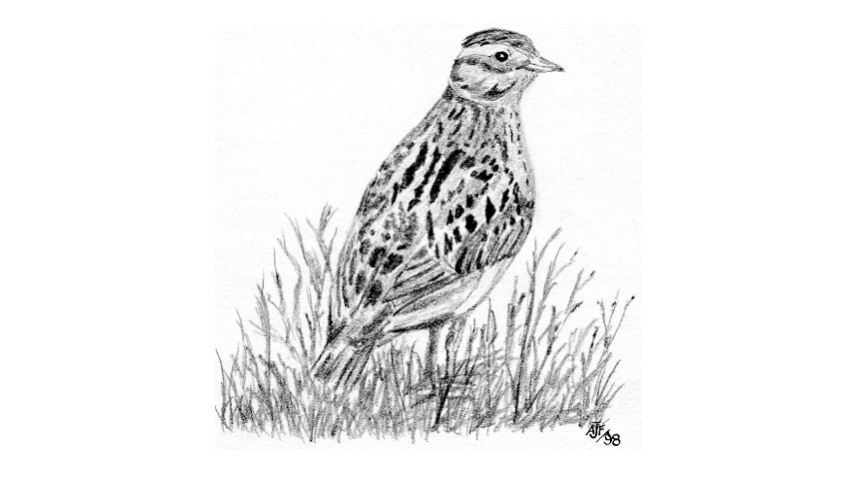
Three Records: Foster (1914) recorded that one had been observed at Whitney Wood, but no date was supplied, he had been informed of this by, Doctor Day of Baldock, one in a field near Aston on 6 January 1968, and one recorded at Watery Grove in 1984 during the Common Bird Census.
Fairly common resident of the agricultural edges of Stevenage, and passage migrant.
Nationally the Skylark population has declined by as much as 50% since 1980. This decline is believed to be as a result of more autumn grown cereals, which reduces the availability of stubble, an important food source in winter. Skylarks have suffered declines before, in the 1950s they suffered massive mortality as a result of the use of organochlorine pesticides, and the effects of the 1962/63 winter also reduced their numbers.
Prior to the Second World War, Skylarks used to be seen and, nested at the Walkern Road Allotments (now the site of Fresson Road), and in the late 1940s they could also be found in the fields that are now the site of Angotts Mead and Woolenwick School.
In 1973 there were 14 pairs in Fairlands Valley, and five pairs nested in the fields of the then new St. Nicholas Park, but shortly after two nests hatched, the fields were cut.
The 1973 Breeding Atlas confirmed breeding from four of Stevenage’s tetrads, the 1992 Atlas from six and, the 2012 Atlas from two, those covering Chesfield Park and, Chells Manor.
The 2012 Winter Atlas confirmed their presence from nine of the tetrads covering Stevenage.
Between mid-October to November westward to north westward passage of migrating Skylarks is observed annually in Hertfordshire, over 70 were seen in two hours passing north westward over Box Wood on 4 October 1980 and, 200 were seen near Stevenage on 23 October 2011. Large movements also occur with the onset of cold, weather, these tend to follow a south westerly direction. On 20 January 1985 250 were seen near Aston End, and 150 at Norton Green on 1 January 1997.
Other recorded flocks: 30 to 40 Hertford Road December 1972; 20 Hertford Road area 31 December 1973; 10 Fairlands Valley in 1979; 25 Norton Green Tip 13 June 1983; 12 Norton Green Tip 9 February 2008; 100 Aston between January and March 2009; 10 Norton Green Tip 11 October 2011; 60 Norton Green Tip 19 January 2012; c.60 seen in fog at Potters Spring 16 November 2012; 20 Norton Green Tip 10 March 2015.
14 pairs were recorded from Fairlands Valley in 1973.
Passage migrant, which bred in the past.
Sand Martins winter in the Sahel zone of Africa. During the winters of 1968/69 and 1982/83 that region suffered severe drought which severely affected the Sand Martin population, and it is estimated that since the 1960s they have decreased by as much as 90 to 95%.
John Piggott recalled in 1979 that in 1940 there was a colony at a site by what was the old Stevenage Town Football Ground in London Road. This football ground is now the site of the Bus Interchange.
They are now passage migrants, mainly seen feeding over Fairlands Valley Lakes, from where they were first recorded on 25 June 1972, in spring and autumn. The earliest they have been seen there is 17 March 2000 and 17 March 2019. The latest autumn migration date is 20 September 1975. In the autumn there was a large “fall” of them on the morning of 16 September 1994. The largest number seen is 24 on 19 September 2025.
Other records: Astonbury 21 May 1975 and 25 September 1977; Astonbury 1979 and 1980; one at Norton Green Tip on 31 March 2006; two at Norton Green Tip on 26 April 2008; five at Shephalbury on 14 April 2013; one at Norton Green Tip on 2 May 2019; eight at Aston End on 27 July 2020.